NXP Laboratories UK JN5139M4 IEEE 802.15.4 High Power Wireless Microcontroller User Manual JN DS JN5139 1v5c
NXP Laboratories UK Ltd IEEE 802.15.4 High Power Wireless Microcontroller JN DS JN5139 1v5c
Contents
manual
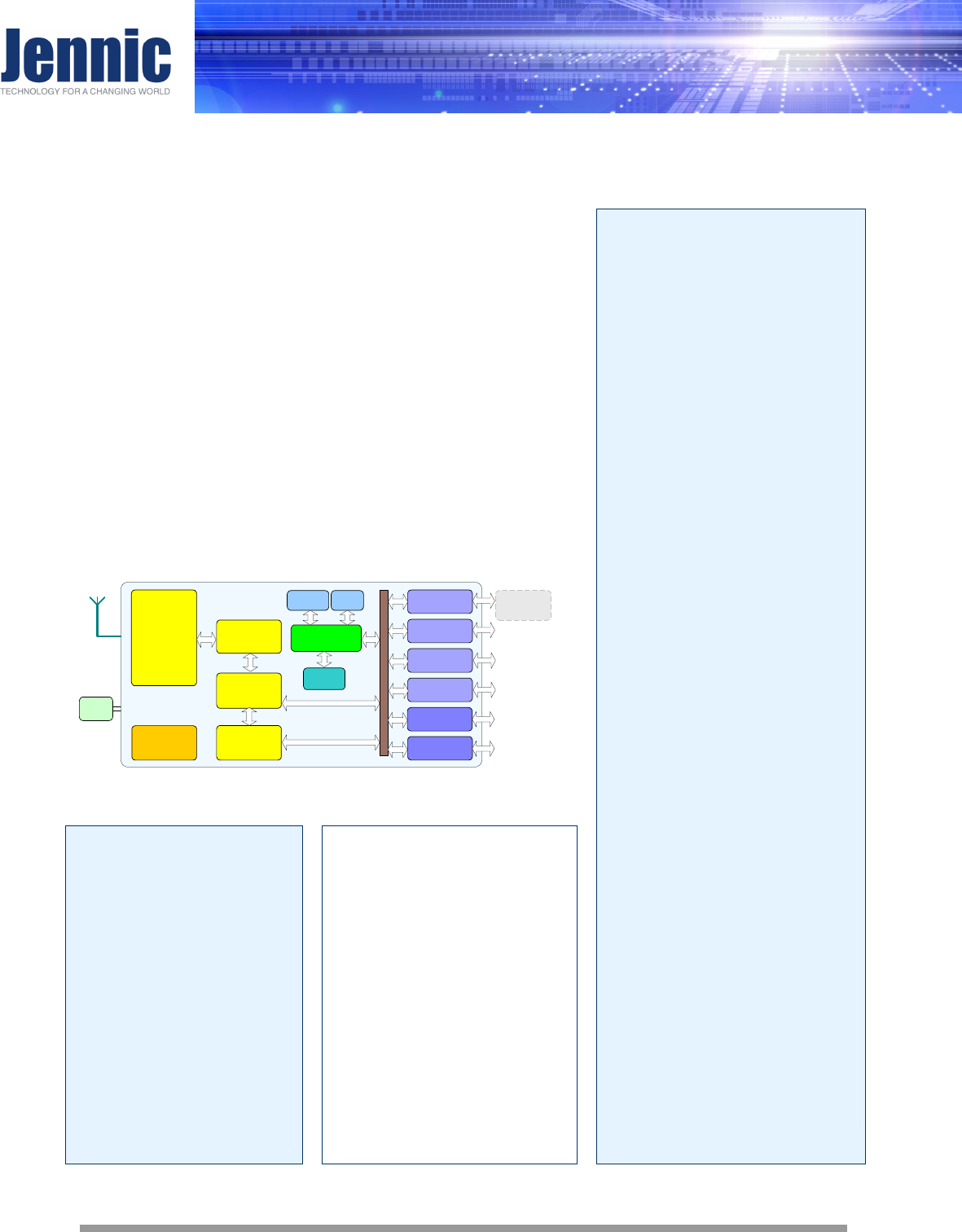
Data Sheet – JN5139
IEEE802.15.4 and ZigBee Wireless Microcontrollers
© Jennic 2008 JN-DS-JN5139 v1.5 1
Overview
The JN5139 is a low power, low cost wireless microcontroller suitable for
IEEE802.15.4 and ZigBee applications. The device integrates a 32-bit
RISC processor, with a fully compliant 2.4GHz IEEE802.15.4 transceiver,
192kB of ROM, 96kB of RAM, and a rich mixture of analogue and digital
peripherals.
The cost sensitive ROM/RAM architecture supports the storage of system
software, including protocol stacks, routing tables and application
code/data. An external flash memory may be used to store application code
that can be bootloaded into internal RAM and executed at runtime.
The device integrates hardware MAC and AES encryption accelerators,
power saving and timed sleep modes, and mechanisms for security key and
program code encryption. These features all make for a highly efficient, low
power, single chip wireless microcontroller for battery-powered applications.
Block Diagram
Benefits
• Single chip integrates
transceiver and
microcontroller for wireless
sensor networks
• Cost sensitive ROM/RAM
architecture, meets needs for
volume application
• System BOM is low in
component count and cost
• Hardware MAC ensures low
power consumption and low
processor overhead
• Extensive user peripherals
•
Pin compatible with JN5121
for easy migration
Applications
• Robust and secure low power
wireless applications
• Wireless sensor networks,
particularly IEEE802.15.4 and
ZigBee systems
• Home and commercial building
automation
• Remote Control
• Toys and gaming peripherals
• Industrial systems
•
Telemetry and utilities
(e.g. AMR)
Features: Transceiver
• 2.4GHz IEEE802.15.4 compliant
• 128-bit AES security processor
• MAC accelerator with packet
formatting, CRCs, address check,
auto-acks, timers
• Integrated power management
and sleep oscillator for low power
• On-chip power regulation for 2.2V
to 3.6V battery operation
• Deep sleep current 60nA
• Sleep current with active sleep
timer 1.2µA
• Needs minimum of external
components (< US$1 cost)
• Rx current 37mA
• Tx current 38mA
• Receiver sensitivity -97dBm
• Transmit power +3dBm
Features: Microcontroller
• 32-bit RISC processor sustains
16MIPs with low power
• 192kB ROM stores system code
including IEEE802.15.4 MAC
• 96kB RAM stores system data
and optionally bootloaded
program code
• 48-byte OTP eFuse supporting
AES based code encryption
feature
• 4-input 12-bit ADC, 2 11-bit
DACs, 2 comparators
• 2 Application timer/counters,
3 system timers
• 2 UARTs (one for debug)
• SPI port with 5 selects
• 2-wire serial interface
• Up to 21 DIO
Industrial temperature range
(-40°C to +85°C)
8x8mm 56-lead QFN
Lead-free and RoHS compliant
32-bit
RISC CPU
Timers
UARTs
12-bit ADC,
comparators
11-bit DACs,
temp sensor
2-wire serial
SPI
RAM
96kB
128-bit AES
Encryption
Accelerator
2.4GHz
Radio
ROM
192kB
Power
Management
XTAL
O-QPSK
Modem
IEEE802.15.4
MAC
Accelerator
Bootloader
Flash
48-byte
OTP eFuse

Jennic
JennicJennic
Jennic
2 JN-DS-JN5139 v1.5 © Jennic 2008
1 Introduction 6
1.1 Wireless Microcontroller 6
1.2 Wireless Transceiver 6
1.3 RISC CPU and Memory 6
1.4 Peripherals 7
1.5 Block Diagram 8
2 Pin Configurations 9
2.1 Pin Assignment 10
2.2 Pin Descriptions 11
2.2.1 Power Supplies 11
2.2.2 Reset 11
2.2.3 16MHz System Clock 11
2.2.4 Radio 11
2.2.5 Analogue Peripherals 11
2.2.6 Digital Input/Output 12
3 CPU 13
4 Memory Organisation 14
4.1 ROM 15
4.2 RAM 15
4.3 OTP eFuse Memory 16
4.4 External Memory 16
4.4.1 Secure External Memory Encryption 16
4.5 Peripherals 17
4.6 Unused Memory Addresses 17
5 System Clocks 18
5.1 16MHz Oscillator 18
5.2 32kHz Oscillator 18
6 Reset 19
6.1 Internal Power-on Reset 19
6.2 External Reset 20
6.3 Software Reset 20
7 Interrupt System 21
7.1 System Calls 21
7.2 Processor Exceptions 21
7.2.1 Bus Error 21
7.2.2 Alignment 21
7.2.3 Illegal Instruction 21
7.3 Hardware Interrupts 22
8 Wireless Transceiver 23
8.1 Radio 23
8.1.1 Radio External components 24
8.1.2 Antenna Diversity 24
8.2 Modem 25
8.3 Baseband Processor 26
8.3.1 Transmit 26

Jennic
JennicJennic
Jennic
© Jennic 2008 JN-DS-JN5139 v1.5 3
8.3.2 Reception 27
8.3.3 Auto Acknowledge 27
8.3.4 Beacon Generation 27
8.3.5 Security 27
8.4 Security Coprocessor 27
9 Digital Input/Output 29
10 Serial Peripheral Interface 30
11 Intelligent Peripheral Interface 33
11.1 Data Transfer Format 33
11.2 JN5139 Initiated Data Transfer 34
11.3 Remote Processor Initiated Data Transfer 34
12 Timers 35
12.1 Peripheral Timer / Counters 35
12.1.1 Pulse Width Modulation Mode 36
12.1.2 Capture Mode 36
12.1.3 Counter / Timer Mode 37
12.1.4 Delta-Sigma Mode 37
12.1.5 Timer / Counter Application 37
12.2 Tick Timer 39
12.3 Wakeup Timers 39
12.3.1 RC Oscillator Calibration 40
12.3.2 External 32kHz Clock Source 40
13 Serial Communications 41
13.1 Interrupts 42
13.2 UART Application 42
14 Two-Wire Serial interface 43
14.1 Connecting Devices 44
14.2 Multi-Master Operation 44
14.3 Clock Stretching 44
15 Analogue Peripherals 45
15.1 Analogue to Digital Converter 46
15.1.1 Operation 46
15.1.2 Supply Monitor 46
15.1.3 Temperature Sensor 46
15.2 Digital to Analogue Converter 47
15.2.1 Operation 47
15.3 Comparators 47
16 Power Management and Sleep Modes 48
16.1 Operating Modes 48
16.1.1 Power Domains 48
16.2 Active Processing Mode 48
16.2.1 CPU Doze 48
16.3 Sleep Mode 48
16.3.1 Wakeup Timer Event 49
16.3.2 DIO Event 49

Jennic
JennicJennic
Jennic
4 JN-DS-JN5139 v1.5 © Jennic 2008
16.3.3 Comparator Event 49
16.4 Deep Sleep Mode 49
17 Electrical Characteristics 50
17.1 Maximum ratings 50
17.2 DC Electrical Characteristics 50
17.2.1 Operating Conditions 50
17.2.2 DC Current Consumption 51
17.2.3 I/O Characteristics 52
17.3 AC Characteristics 52
17.3.1 Reset 52
17.3.2 SPI Timing 53
17.3.3 Two-wire serial interface 54
17.3.4 Power Down and Wake-Up timings 54
17.3.5 32kHz Oscillator 55
17.3.6 16MHz Crystal Oscillator 55
17.3.7 Bandgap Reference 56
17.3.8 Analogue to Digital Converters 56
17.3.9 Digital to Analogue Converters 57
17.3.10 Comparators 58
17.3.11 Temperature Sensor 58
17.3.12 Radio Transceiver 59
Appendix A Mechanical and Ordering Information 63
A.1 56pin QFN Package Drawing 63
A.2 PCB Decal 64
A.3 Ordering Information 65
A.4 Device Package Marking 66
A.5 Tape and Reel Information 67
A.5.1 Tape Orientation and Dimensions 67
A.5.2 Reel Information: 7” Reel 68
A.5.3 Dry Pack Requirement for Moisture Sensitive Material 69
A.6 PCB Design and Reflow Profile 70
Appendix B Development Support 71
B.1 Crystal Oscillator 71
B.1.1 Crystal Equivalent Circuit 71
B.1.2 Crystal Load Capacitance 72
B.1.3 Crystal ESR and Required Transconductance 72
B.2 16MHz Oscillator 74
B.3 Applications Information 75
B.3.1 Typical Application Schematic 75
B.3.2 PCB Requirements 76
B.3.3 Supply Decoupling 77
B.3.4 Reference Oscillator Requirements 77
B.3.5 Reference Oscillator Layout Considerations 77
B.3.6 VCO Tune Circuit Component Specifications 77
B.3.7 VCO Tune Circuit Layout Considerations 78
B.3.8 Radio Front-End 78
B.3.9 Antennae 78
B.3.10 Ground Planes 78
B.3.11 Manufacturing Considerations 79

Jennic
JennicJennic
Jennic
© Jennic 2008 JN-DS-JN5139 v1.5 5
B.3.12 Bespoke Solutions - PCB Layout Suggestions 80
B.3.13 Using a Balun 81
B.3.14 Decoupling Capacitors 81
B.3.15 Internal Regulator Smoothing Capacitors 82
B.3.16 VREF 82
B.3.17 IBIAS 82
B.3.18 EMC 82
Appendix C 83
Related Documents 83
RoHS Compliance 83
Status Information 83
Disclaimers 84
Version Control 84
Contact Details 85

Jennic
JennicJennic
Jennic
6 JN-DS-JN5139 v1.5 © Jennic 2008
1 Introduction
The JN5139 is an IEEE802.15.4 wireless microcontroller that provides a fully integrated solution for applications
using the IEEE802.15.4 standard in the 2.4 - 2.5GHz ISM frequency band [1], including ZigBee. It includes all of the
functionality required to meet the IEEE802.15.4 specification and has additional processor capability to run a wide
range of applications including but not limited to Remote Control, Home and Building Automation, Toys and Gaming.
The device includes a Wireless Transceiver, RISC CPU, on-chip memory and an extensive range of peripherals.
1.1 Wireless Microcontroller
Applications that transfer data wirelessly tend to be more complex than wired ones. Wireless protocols make
stringent demands on frequencies, data formats, timing of data transfers, security and other issues. Application
development must consider the requirements of the wireless network in addition to the product functionality and user
interfaces. To minimise this complexity, Jennic provides a series of software libraries and interfaces that control the
transceiver and peripherals of the JN5139. These libraries and interfaces remove the need for the developer to
understand wireless protocols and greatly simplifies the programming complexities of power modes, interrupts and
hardware functionality.
In view of the above, the register details of the JN5139 are not provided in the datasheet.
1.2 Wireless Transceiver
The Wireless Transceiver is highly integrated and, together with the integrated IEEE802.15.4 MAC library contained
in ROM requires little knowledge of RF or wireless design.
The Wireless Transceiver comprises a low-IF 2.45GHz radio, an O-QPSK modem, a baseband controller and a
security coprocessor. The radio has a 200Ω resistive differential antenna port that includes all the required matching
components on-chip, allowing a differential antenna to be connected directly to the port, minimising the system BOM
costs. Connection to a single ported antenna can be achieved using a 200/50Ω 2.45GHz balun. In addition, the
radio also provides an output to control transmit-receive switching of external devices such as power amplifiers
allowing applications that require increased transmit power to be realised very easily.
The Security coprocessor provides hardware-based 128-bit AES-CCM, CBC
(1)
, CTR and CCM* processing as
specified by the IEEE802.15.4 standard. It does this in-band on packets during transmission and reception, requiring
minimal intervention from the CPU. It is also available for off-line use under software control for encrypting and
decrypting packets generated by software layers such as Zigbee and user applications. This means that these
algorithms can be off-loaded by the CPU, increasing the processor bandwidth available for user applications.
The transceiver elements (radio, modem and baseband) work together to provide IEEE802.15.4 Medium Access
Control under the control of a protocol stack.
(1) AES-CBC processing is only available off-line for use under software control.
1.3 RISC CPU and Memory
A 32-bit RISC CPU allows software to be run on-chip, its processing power being shared between the IEEE802.15.4
MAC protocol, other higher layer protocols and the user application. The JN5139 has a unified memory architecture,
code memory, data memory, peripheral devices and I/O ports are organized within the same linear address space.
The device contains 192kBytes of ROM, 96kBytes of RAM and a 48-byte OTP eFuse memory.

Jennic
JennicJennic
Jennic
© Jennic 2008 JN-DS-JN5139 v1.5 7
1.4 Peripherals
The following peripherals are available on-chip:
• Master SPI port with five select outputs
• Two UARTs
• Two programmable Timer/Counters with capture/compare facility
• Two programmable Sleep Timers and a Tick Timer
• Two-wire serial interface (compatible with SMbus and I
2
C)
• Slave SPI port (shared with digital I/O)
• Twenty-one digital I/O lines (multiplexed with UARTs, timers and SPI selects)
• Four-channel, 12-bit, Analogue-to-Digital converter
• Two 11-bit Digital-to-Analogue converters
• Two programmable analogue comparators
• Internal temperature sensor and battery monitor
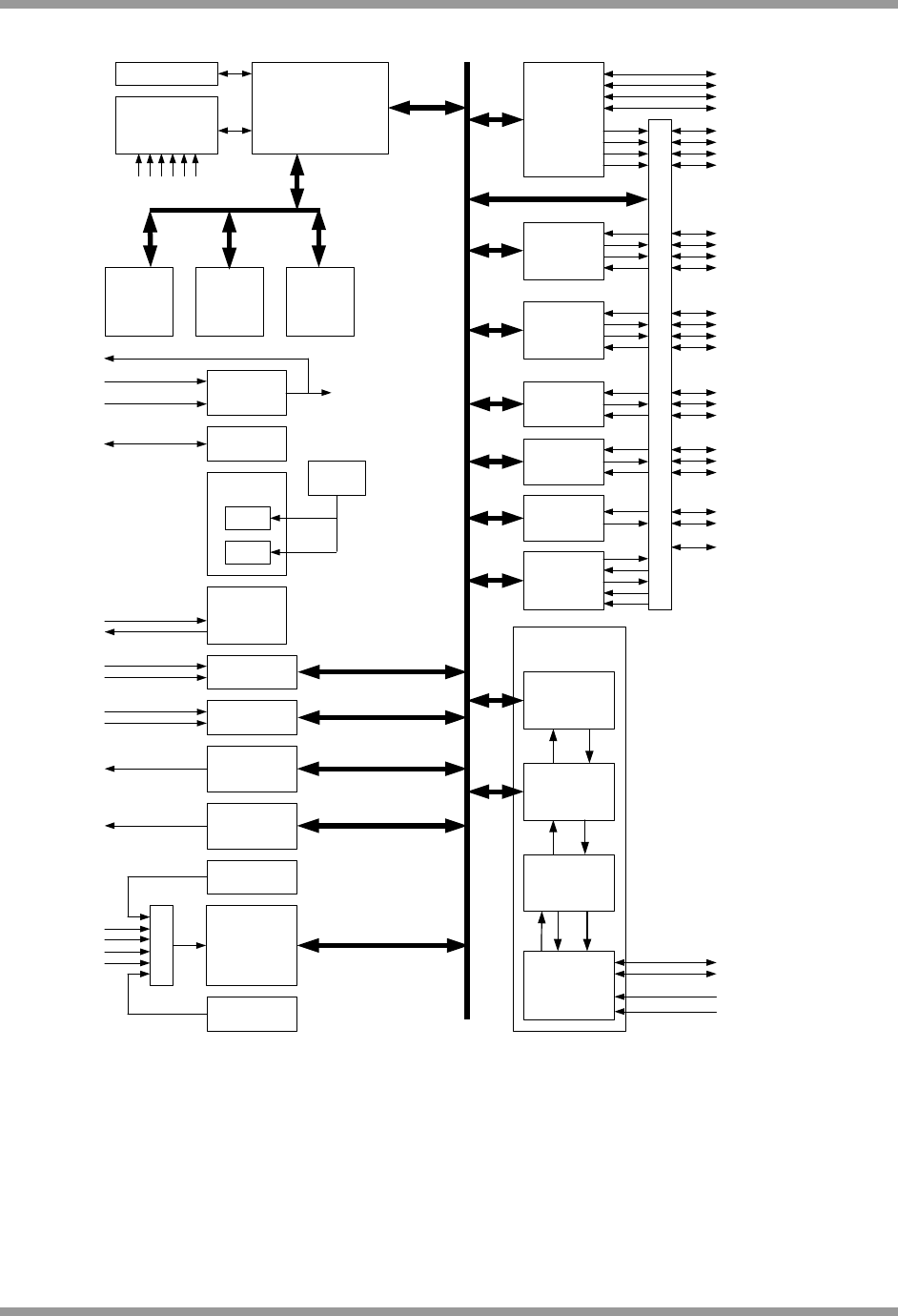
Jennic
JennicJennic
Jennic
8 JN-DS-JN5139 v1.5 © Jennic 2008
1.5 Block Diagram
32-bit RISC CPU
RAM
96kB
ROM
192kB
Reset
SPI
M
U
X
UART0
UART1
32kHz
Osc
WT1
WT0
Wakeup
Security
Coprocessor
DIO6/TXD0
DIO7/RXD0
DIO4/CTS0
DIO5/RTS0
DIO19/TXD1
DIO20/RXD1
DIO17/CTS1/IP_SEL
DIO18/RTS1/IP_INT
Baseband
Controller
Modem
Radio
Programmable
Interrupt
Controller
Timer0
2-Wire
Serial
Interface
Timer1
DAC1
DAC2
ADC
Comparator2
SPICLK
DIO10/TIM0OUT
SPIMOSI
SPIMISO
SPISEL0
DIO0/SPISEL1
DIO3/SPISEL4/RFTX
DIO2/SPISEL3/RFRX
DIO1/SPISEL2
DIO9/TIM0CAP/CLK32K
DIO8/TIM0CK_GT
DIO13/TIM1OUT
DIO11/TIM1CK_GT
DIO12/TIM1CAP
DIO14/SIF_CLK/IP_CLK
DIO15/SIF_D/IP_DO
DIO16/IP_DI
From Peripherals
M
U
X
RESETN
Wireless
Transceiver
ADC4
ADC1
ADC2
ADC3
DAC1
DAC2
COMP2P
COMP2M
Clock
Generator
XTALIN
XTALOUT
RFM
RFP
VCOTUNE
Tick Timer
Voltage
Regulators 1.8V
Temperature
Sensor
Supply
Monitor
VDD1
VDD2
Intelligent
Peripheral
IBIAS
VB_xx
OTP
eFuse
48-byte
Comparator1
COMP1P
COMP1M
Figure 1: JN5139 Block Diagram
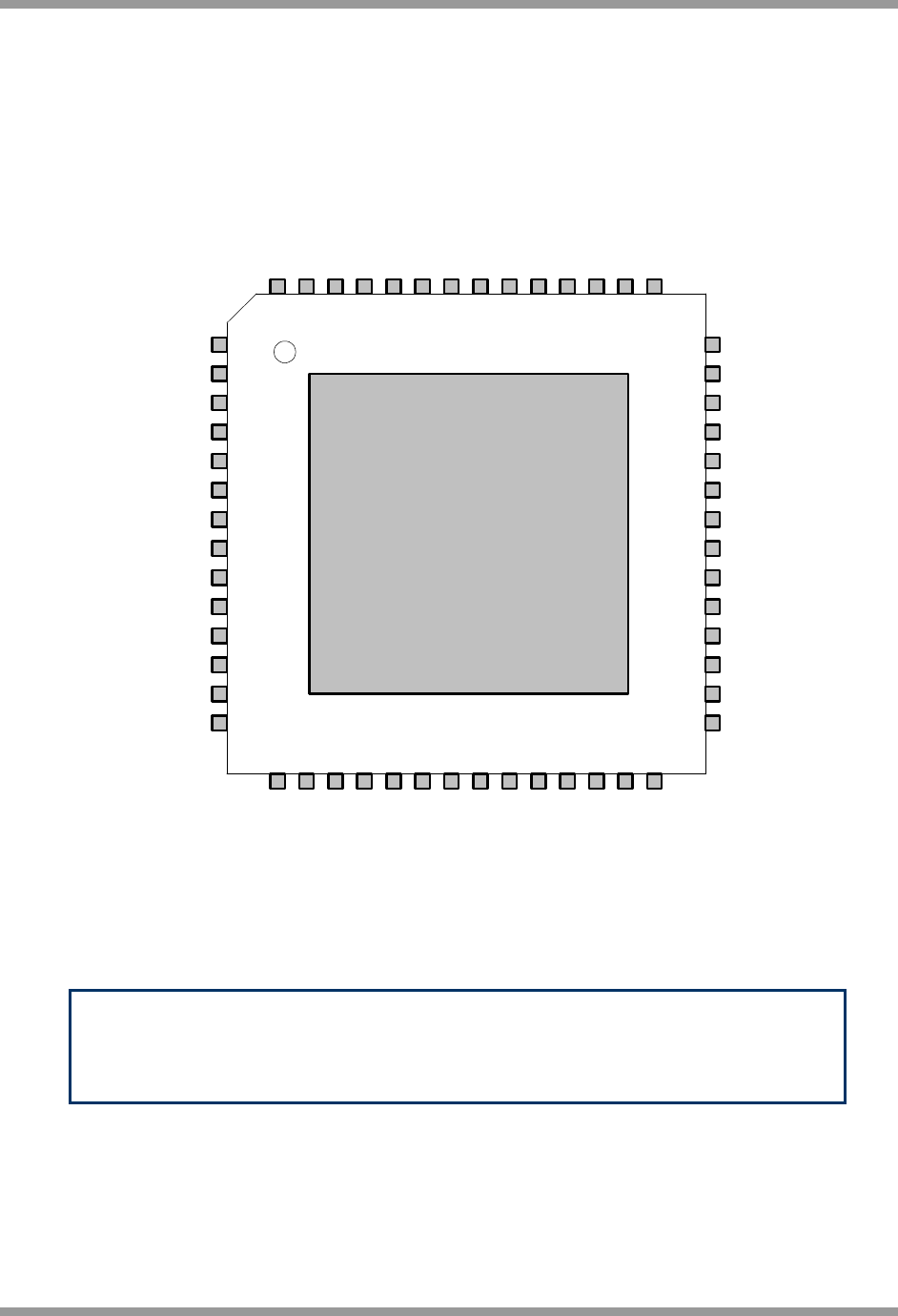
Jennic
JennicJennic
Jennic
© Jennic 2008 JN-DS-JN5139 v1.5 9
2 Pin Configurations
DIO6/TXD0
DIO7/RXD0
DIO4/CTS0
DIO5/RTS0
DIO19/TXD1
DIO20/RXD1
DIO17/CTS1/IP_SEL
DIO18/RTS1/IP_INT
VB_VCO
DIO10/TIM0OUT
SPIMISO
SPIMOSI
SPISEL0
DIO0/SPISEL1
DIO3/SPISEL4/RFTX
DIO2/SPISEL3/RFRX
DIO1/SPISEL2
DIO9/TIM0CAP/CLK32K
DIO8/TIM0CK_GT
DIO13/TIM1OUT
DIO11/TIM1CK_GT
DIO12/TIM1CAP
DIO14/SIF_CLK/IP_CLK
DIO15/SIF_D/IP_DO
DIO16/IP_DI 1
2
3
4
5
VSS2
RESETN
VSS3
VSSS
6
7
8
9
10
11
12
13
14
XTALOUT
XTALIN
VB_SYN
VCOTUNE
VB_DIG2
56
55
54
53
52
51
50
49
48
47
46
45
44
43
29
30
31
32
33
34
35
36
37
38
39
40
41
42
15
16
17
18
19
20
21
22
23
24
25
26
27
28
VDD1
COMP1M
COMP1P
IBIAS
RFP
VB_RF
RFM
VREF
ADC1
ADC2
ADC3
ADC4
VB_A
DAC1
DAC2
COMP2P
COMP2M
SPICLK
VB_DIG1
VSS1
VB_MEM
VDD2
PADDLE
Figure 2: 56-pin QFN Configuration (top view)
Note: Please refer to Appendix B.3.11 for important applications
information regarding the connection of the PADDLE to the PCB.

Jennic
JennicJennic
Jennic
10 JN-DS-JN5139 v1.5 © Jennic 2008
2.1 Pin Assignment
Pin No Power supplies Description
3, 13, 15, 21 28, 35,
40
VB_DIG2, VB_SYN, VB_VCO, VB_RF,
VB_A, VB_DIG1, VB_MEM
Regulated supply voltage
16, 49 VDD1, VDD2 Device supplies: VDD1 for analogue, VDD2 for digital
7,9,10,39, PADDLE VSS2, VSS3, VSSS, VSS1, VSSA Device grounds
General
8 RESETN Reset output/input
11, 12 XTALOUT, XTALIN System crystal oscillator
Radio
14 VCOTUNE VCO tuning RC network
19 IBIAS Bias current control
20, 22 RFP, RFM Differential antenna port
Analogue Peripheral I/O
24, 25, 26, 27 ADC1, ADC2, ADC3, ADC4 ADC inputs
23 VREF Analogue peripheral reference voltage
29, 30 DAC1, DAC2 DAC outputs
17, 18, 31, 32 COMP1M, COMP1P, COMP2P, COMP2M Comparator inputs
Digital I/O
Primary Function Alternate Function
33 SPICLK SPI Clock
36 SPIMOSI SPI Master Out Slave In
34 SPIMISO SPI Master In Slave Out
37 SPISEL0 SPI Slave Select Output 0
38 DIO0 SPISEL1 DIO0 or SPI Slave Select Output 1
41 DIO1 SPISEL2 DIO1 or SPI Slave Select Output 2
42 DIO2 SPISEL3, RFRX DIO2 or SPI Slave Select Output 3 or
Radio Receive Control Output
43 DIO3 SPISEL4, RFTX DIO3 or SPI Slave Select Output 4 or
Radio Transmit Control Output
44 DIO4 CTS0 DIO4 or UART 0 Clear To Send Input
45 DIO5 RTS0 DIO5 or UART 0 Request To Send Output
46 DIO6 TXD0 DIO6 or UART 0 Transmit Data Output
47 DIO7 RXD0 DIO7 or UART 0 Receive Data Input
48 DIO8 TIM0CK_GT DIO8 or Timer0 Clock/Gate Input
50 DIO9 TIM0CAP,CLK32K DIO9 or Timer0 Capture Input or CLK32K
51 DIO10 TIM0OUT DIO10 or Timer0 PWM Output
52 DIO11 TIM1CK_GT DIO11 or Timer1 Clock/Gate Input
53 DIO12 TIM1CAP DIO12 or Timer1 Capture Input or Antenna Diversity
Output
54 DIO13 TIM1OUT DIO13 or Timer1 PWM Output
55 DIO14 SIF_CLK, IP_CLK DIO14 or Serial Interface Clock or Intelligent Peripheral
Clock Input
56 DIO15 SIF_D, IP_DO DIO15 or Serial Interface Data or Intelligent Peripheral
Data Out
1 DIO16 IP_DI DIO16 or Intelligent Peripheral Data In
2 DIO17 CTS1, IP_SEL DIO17 or UART 1 Clear To Send Input or Intelligent
Peripheral Device Select Input
4 DIO18 RTS1, IP_INT DIO18 or UART 1 Request To Send Output or Intelligent
Peripheral Interrupt Output
5 DIO19 TXD1 DIO19 or UART 1 Transmit Data Output
6 DIO20 RXD1 DIO20 or UART 1 Receive Data Input

Jennic
JennicJennic
Jennic
© Jennic 2008 JN-DS-JN5139 v1.5 11
2.2 Pin Descriptions
2.2.1 Power Supplies
The device is powered from the VDD1 and VDD2 pins, each being decoupled with a 100nF ceramic capacitor. VDD1
is the power supply to the analogue circuitry; it should be decoupled to analogue ground. VDD2 is the power supply
for the digital circuitry; it should be decoupled to digital ground. A 10uF tantalum capacitor is required at the common
ground star point of analogue and digital supplies. Decoupling pins for the internal 1.8V regulators are provided
which require a 100nF capacitor located as close to the device as practical. VB_VCO, VB_RF, VB_A and VB_SYN
should be decoupled to analogue ground, while VB_MEM, VB_DIG1 and VB_DIG2 should be decoupled to digital
ground. VB_SYN and VB_RF also require an additional 47pF capacitor. See also Appendix B for connection details.
VSSA is the analogue ground, connected to the paddle of the device, while VSSS, VSS1, VSS2, VSS3 are digital
ground pins.
2.2.2 Reset
RESETN is a bi-directional active low reset pin that is connected to a 40kΩ internal pull-up resistor. It may be pulled
low by an external circuit, or can be driven low by the JN5139 if an internal reset is generated. Typically, it will be
used to provide a system reset signal. Refer to section 6.2, External Reset, for more details.
2.2.3 16MHz System Clock
A crystal connected between XTALIN and XTALOUT drives the system clock. A capacitor to analogue ground is
required on each of these pins. Refer to section 5.1 16MHz Oscillator for more details.
2.2.4 Radio
A 200Ω balanced antenna (such as a printed circuit antenna) can be connected directly to the radio interface pins
RFM and RFP.
A single-ended 50Ω antenna such as a ceramic type or SMA connector for an external antenna requires the addition
of a 200/50Ω 2.45GHz balun transformer connected to the antenna pins. The balun differential port should be
connected to the antenna port with 200Ω balanced controlled impedance track. A 50Ω controlled impedance track
should be used to connect the unbalanced port of the balun to the antenna to ensure good impedance matching and
reduce losses and reflections.
A simple external loop filter circuit consisting of two capacitors and a resistor is connected to VCOTUNE. Refer to
section 8.1 Radio for more details.
An external resistor (43kΩ) is required between IBIAS and analogue ground to set various bias currents and
references within the radio.
2.2.5 Analogue Peripherals
Several of the analogue peripherals require a reference voltage to use as part of their operations. They can use
either an internal reference voltage or an external reference connected to VREF. This voltage is referenced to
analogue ground and the performance of the analogue peripherals is dependant on the quality of this reference.
There are four ADC inputs, two comparator inputs and two DAC outputs. The analogue I/O pins on the JN5139 can
have signals applied up to 0.3v higher than VDD1. A schematic view of the analogue I/O cell is shown in Figure 3
Analogue I/O Cell.
In reset and deep sleep, the analogue peripherals are all off and the DAC outputs are in a high impedance state.
In sleep, the ADC and DACs are off, with the DAC outputs in a high impedance state and the comparator may
optionally be used as a wakeup.
Unused ADC and comparator inputs should be left unconnected.
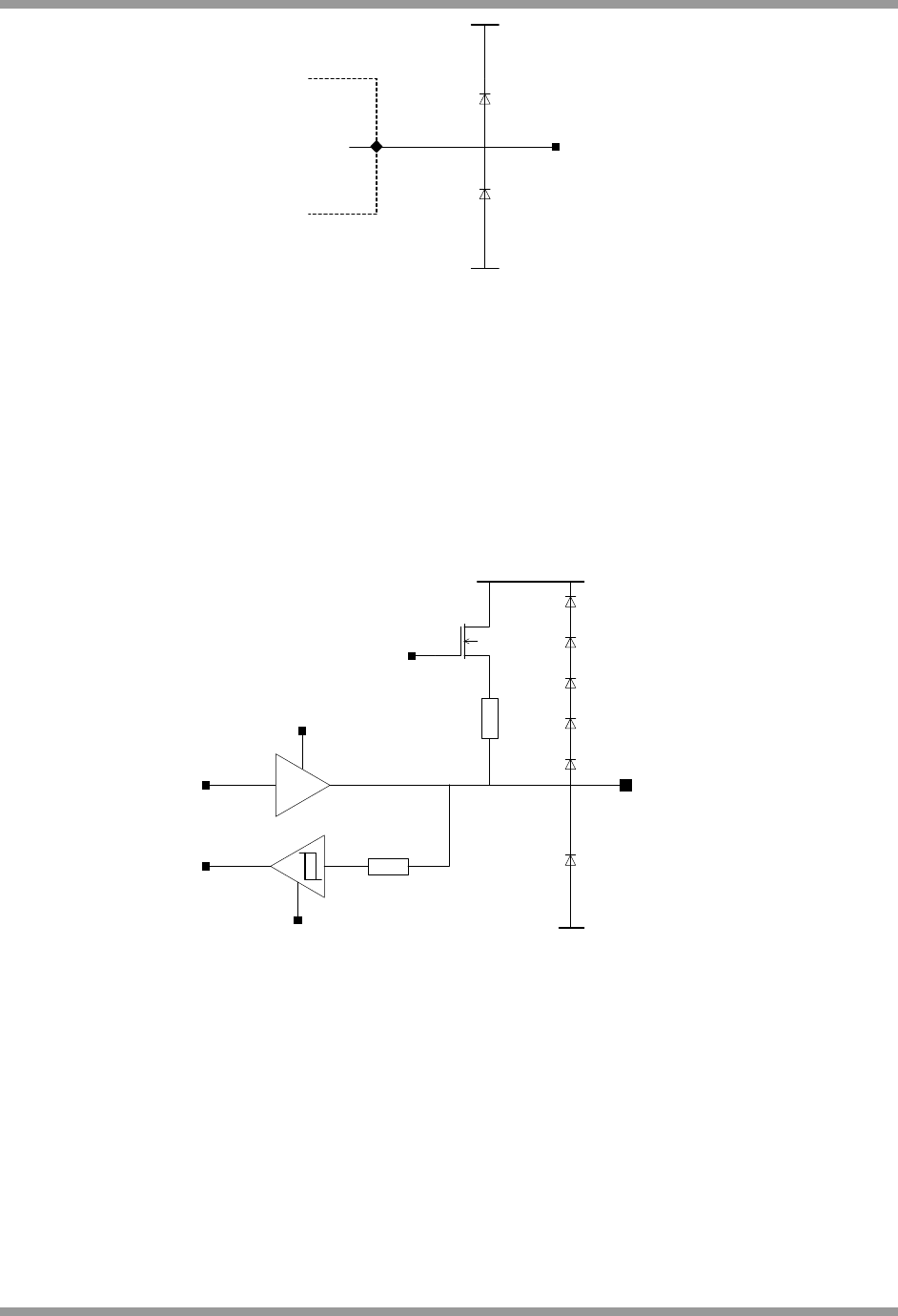
Jennic
JennicJennic
Jennic
12 JN-DS-JN5139 v1.5 © Jennic 2008
VDD1
Analogue
I/O Pin
VSSA
Analogue
Peripheral
Figure 3 Analogue I/O Cell
2.2.6 Digital Input/Output
Digital I/O pins on the JN5139 can have signals applied up to 2V higher than VDD2 (with the exception of pins DIO9
and DIO10 that are 3V tolerant) and are therefore TTL-compatible with VDD2 > 3V. For other DC properties of these
pins see section 17.2.3 I/O Characteristics.
When used in their primary function all Digital Input/Output pins are bi-directional and are connected to weak internal
pull up resistors (40kΩ nominal) that can be disabled. When used in their secondary function (selected when the
appropriate peripheral block is enabled) then their direction is fixed by the function. The pull up resistor is enabled or
disabled independently of the function and direction.
A schematic view of the digital I/O cell is in Figure 4: DIO Pin Equivalent Schematic.
I
O
IE
VDD2
VSS
Pu
R
PU
R
PROT
OE
DIO[x] Pin
Figure 4: DIO Pin Equivalent Schematic
Each DIO pin configuration is programmed through software library calls. The configuration includes the direction of
each pin, input or output. When a peripheral that uses the cell as part of its I/O is enabled, then the pin state will be
automatically configured by the peripheral. The use of the pull-up resistor Rpu for each pin can be configured, the
default state from reset is enabled.
In reset, the digital peripherals are all off and the DIO pins are set as high-impedance inputs. During sleep and deep
sleep, the DIO pins retain both their input/output state and output level that was set as sleep commences. If the DIO
pins were enabled as inputs and the interrupts were enabled these pins may be used to wake up the JN5139 from
sleep.

Jennic
JennicJennic
Jennic
© Jennic 2008 JN-DS-JN5139 v1.5 13
3 CPU
The CPU of the JN5139 is a 32-bit load and store RISC processor. It has been architected for three key
requirements:
• Low power consumption for battery powered applications
• High performance to implement a wireless protocol at the same time as complex applications
• Efficient coding of high-level languages such as C provided with the Jennic Software Developers Kit
It features a linear 32-bit logical address space with unified memory architecture, accessing both code and data in the
same address space. Registers for peripheral units, such as the timers, UARTs and the baseband processor are
also mapped into this space.
The CPU contains a block of 32 32-bit General-Purpose (GP) registers together with a small number of special
purpose registers which are used to store processor state and control interrupt handling. The contents of any GP
register can be loaded from or stored to memory, while arithmetic and logical operations, shift and rotate operations,
and signed and unsigned comparisons can be performed either between two registers and stored in a third, or
between registers and a constant carried in the instruction. Operations between general or special-purpose registers
execute in one cycle (16MHz) while those that access memory require a further cycle to allow the memory to
respond.
The instruction set manipulates 8, 16 and 32-bit data, stored in big-endian format; this means that programs can use
objects of these sizes very efficiently. Manipulation of 32-bit quantities is particularly useful for protocols and high-
end applications allowing algorithms to be implemented in fewer instructions than on smaller word-size processors,
and to execute in fewer clock cycles.
The instruction set is designed for the efficient implementation of high-level languages such as C. Access to fields in
complex data structures is very efficient due to the provision of several addressing modes, together with the ability to
be able to use any of the GP registers to contain the address of objects. Subroutine parameter passing is also made
more efficient by using GP registers rather than pushing objects on the stack. The recommended programming
method for the JN5139 is by using C, which is supported by a software developer kit comprising a C compiler, linker
and debugger.
The CPU architecture also contains features that make the processor suitable for embedded, real-time applications.
In some applications, it may be necessary to use a real-time operating system to allow multiple tasks to run on the
processor.
Embedded applications require efficient handling of external hardware events. Exception processing (including reset
and interrupt handling) is enhanced by the inclusion of a number of special-purpose registers into which the PC and
status register contents are copied as part of the operation of the exception hardware. This means that the essential
registers for exception handling are stored in one cycle, rather than the slower method of pushing them onto the
processor stack. The PC is also loaded with the vector address for the exception that occurred, allowing the handler
to start executing in the next cycle.
To improve power consumption a number of power-saving modes are implemented in the JN5139, described more
fully in section 16 - Power Management and Sleep Modes. One of these modes is the CPU doze mode; under
software control, the processor can be shut down and on an interrupt will wake up to service the request.
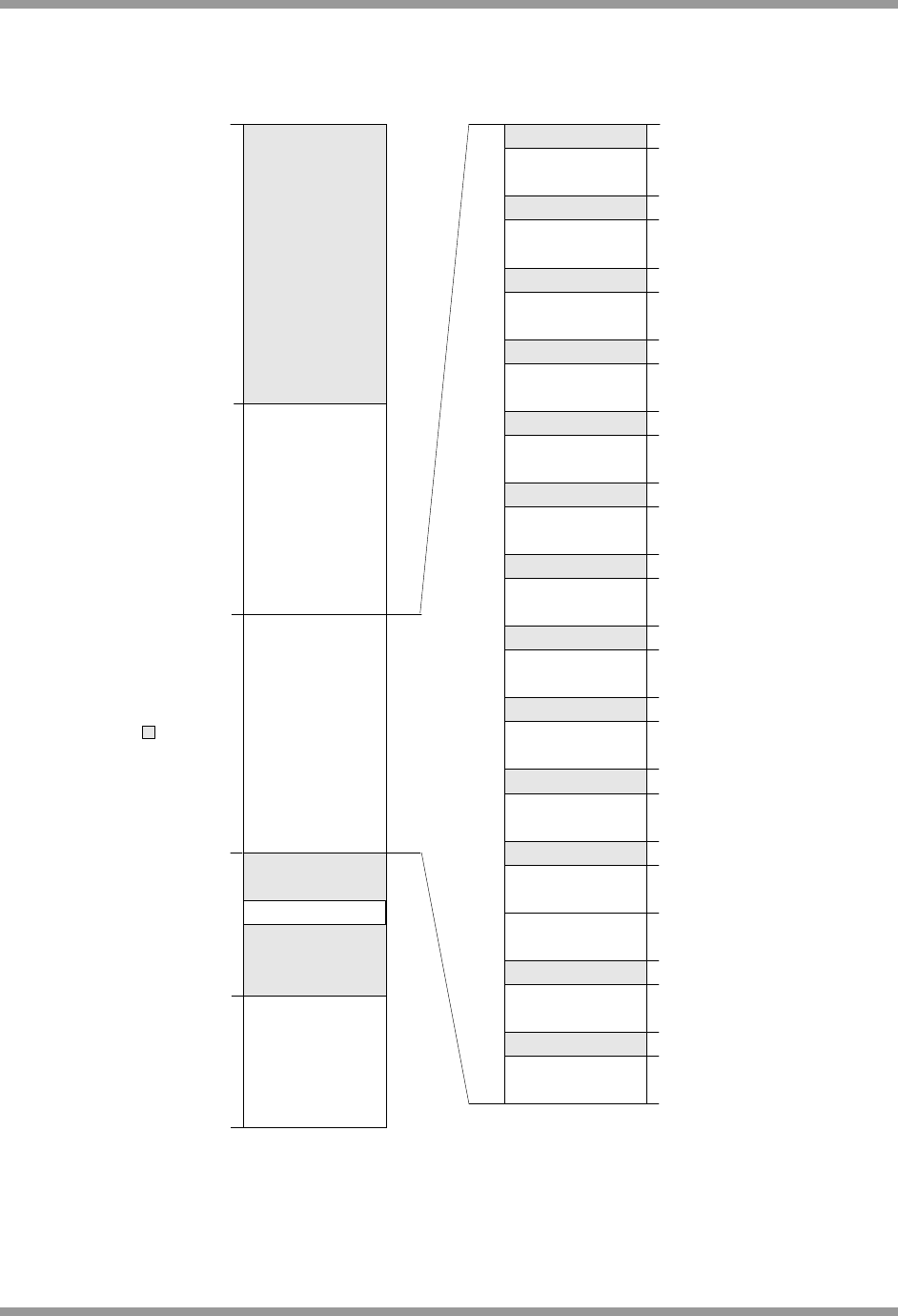
Jennic
JennicJennic
Jennic
14 JN-DS-JN5139 v1.5 © Jennic 2008
4 Memory Organisation
This section describes the different memories found within the JN5139. The device contains ROM, RAM, OTP eFuse
memory, the wireless transceiver and peripherals all within the same linear address space.
0x00000000
0x00030000
RAM
(96kB)
0xF0000000
0xF0018000
System Controller
Baseband Controller
Security Coprocessor
PHY Controller
Analogue Peripherals
GPIO
UART0
UART1
Timer0
SPI
Intelligent Peripheral
0x100000FF
0x10000000
0x10000400
0x100009FF
0x10000C00
0x10000DFF
0x10000E00
0x10000E5F
0x10000F00
0x10000F2B
0x20000000
0x2000000B
0x30000000
0x3000007F
0x40000000
0x4000007F
0x50000000
0x5000001B
0x60000000
0x6000001B
0x70000000
0x70000013
0x80000000
Timer1
2-Wire Interface
0x8000001B
0x90000000
0x90000013
0x98000000
Intelligent Peripheral
Memory Block
0x980001FF
0xEFFFFFFF0xFFFFFFFF
PeripheralsUnpopulated
ROM
(192kB)
0x10000000
RAM Echo
0x04000000
0x04018000
Figure 5: JN5139 Memory Map
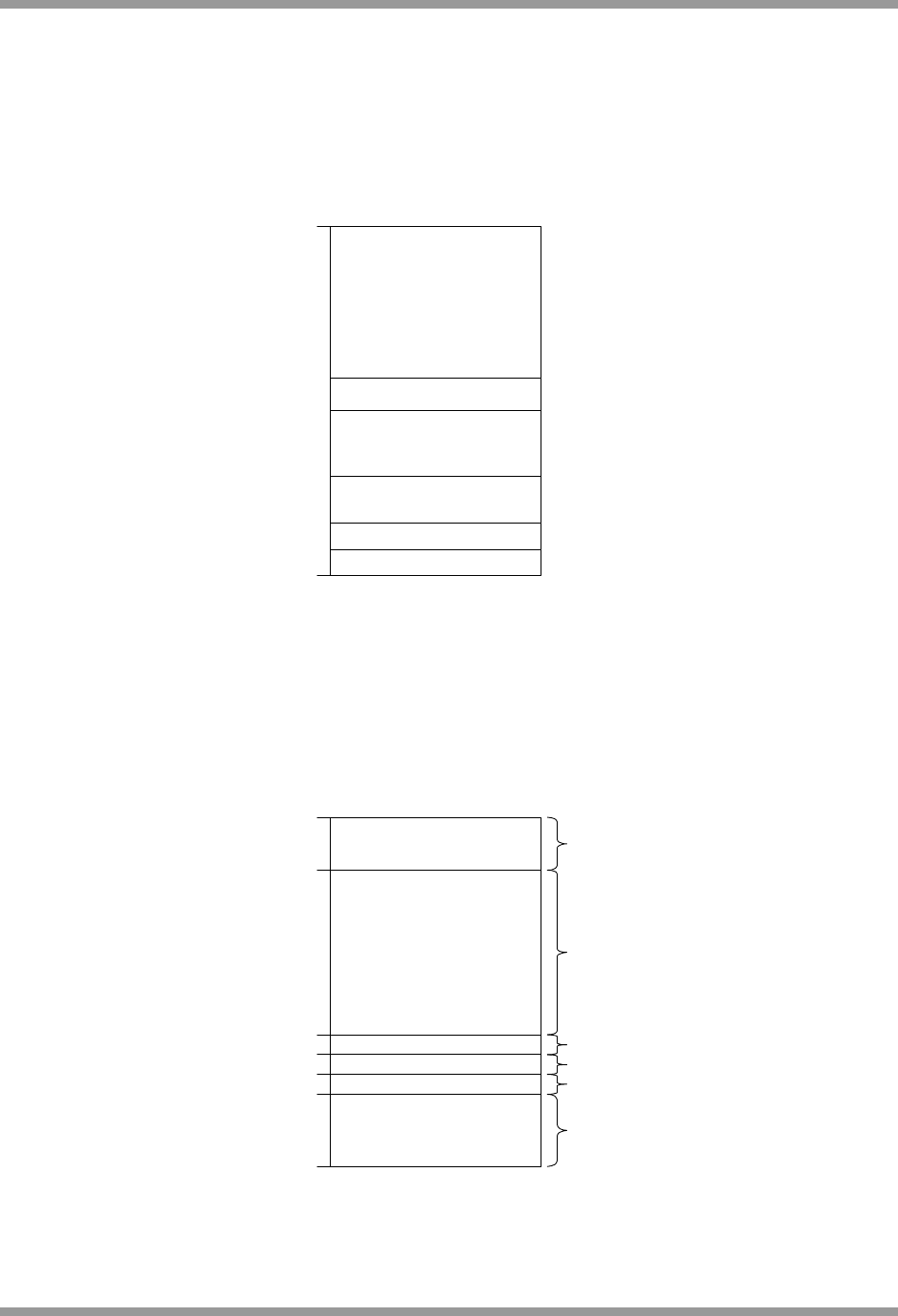
Jennic
JennicJennic
Jennic
© Jennic 2008 JN-DS-JN5139 v1.5 15
4.1 ROM
The ROM is 192K bytes in size, organized as 48k x 32-bit words and can be accessed by the CPU in a single clock
cycle. The ROM contents include bootloader to allow external Flash memory contents to be bootloaded into RAM at
runtime, a default interrupt vector table, an interrupt manager, IEEE802.15.4 MAC and assorted APIs for interfacing
to the MAC and on-chip hardware peripherals. The operation of the boot loader is described in detail in Application
Note JN-AN-1003 Boot Loader Operation [2]. The interrupt manager routes interrupt calls to the application’s soft
interrupt vector table contained within RAM. Section 7 contains further information regarding the handling of
interrupts. Typical ROM contents are shown in Figure 6.
0x0002FFFF
0x00000000
Unused
APIs
IEEE802.15.4 MAC
Boot Loader
Interrupt Manager
Interrupt Vectors
Figure 6: ROM contents
4.2 RAM
The JN5139 contains 96k bytes of high speed RAM organized as 24k x 32-bit. It can be used for both code and data
storage and is accessed by the CPU in a single clock cycle. At reset, a boot loader controls the loading of segments
of code and data from an external memory connected to the SPI port, into RAM. Software can control the power
supply to the RAM allowing the contents to be maintained during a sleep period when other parts of the device are
un-powered. Typical RAM contents are shown in Figure 7.
2k Bytes
92k Bytes
4K Bytes
24 Bytes
12 Bytes
32 Bytes
0x04018000
0x04017800
0x04001020
0x04000000
0x04000FD0
0x04000FF4
0x04001000
CPU Stack (Grows down)
Application
+
Networking Stack
MAC Address
OAD Data
FLASH Header Data
MAC Data
Interrupt Vector Table
Figure 7: RAM Contents
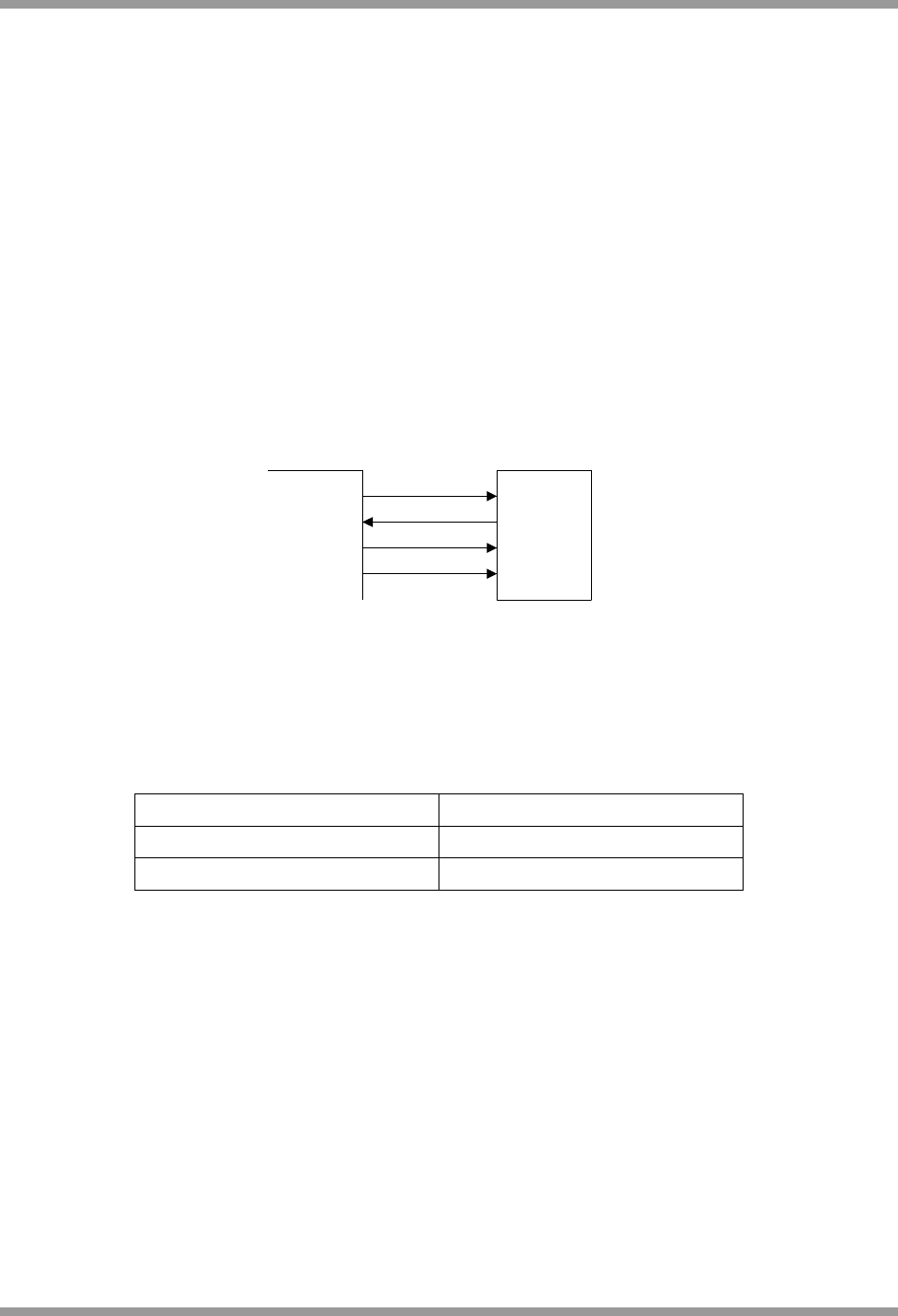
Jennic
JennicJennic
Jennic
16 JN-DS-JN5139 v1.5 © Jennic 2008
4.3 OTP eFuse Memory
The JN5139 contains 48-bytes of eFuse memory; this is one time programmable memory that is organised as 12 x
32-bit words, 4 words are reserved by Jennic and 4 words are reserved for future use. The remaining 4 words are
fully user programmable, designed to allow for the storage of a 128-bit encryption key for secure external memory
encryption (see section 4.4.1)
For full details on how to program and use the eFuse memory, please refer to application note JN-AN-1062 Using
OTP eFuse Memory [3].
Alternatively, Jennic can provide an eFuse programming service for customers that wish to use the eFuse but do not
wish to undertake this for themselves. For further details of this service, please contact your local Jennic sales office.
4.4 External Memory
An external memory with an SPI interface may be used to provide storage for program code and data for the device
when external power is removed. The memory is connected to the SPI interface using select line SPISEL0; this
select line is dedicated to the external memory interface and is not available for use with other external devices. See
Figure 8 for connection details.
JN5139 Serial
Memory
SPISEL0
SPIMISO
SPIMOSI
SPICLK
SS
SDO
SDI
CLK
Figure 8: Connecting External Serial Memory
At reset, the contents of this memory are copied into RAM by the software boot loader. The Flash memory devices
that are supported as standard through the JN5139 bootloader are given in Table 1. Jennic recommends that where
possible one of these devices should be selected.
Manufacturer Device Number
ST Microelectronics M25P10-A
SST (Silicon Storage Technology) 25VF010
Table 1: Supported Flash Memories
Applications wishing to use an alternate Flash memory device should refer to application note JN-AN-1038
Programming Flash devices not supported by the JN51xx ROM-based bootloader [4]. This application note provides
guidance on developing an interface to an alternate device.
4.4.1 Secure External Memory Encryption
The contents of the external serial memory may be securely encrypted to protect against system cloning or intrusion.
The AES security processor combined with a user programmable 128-bit encryption key is used to encrypt the
contents of the external memory. The encryption key is stored in eFuse.
When bootloading program code from external serial memory, the JN5139 automatically accesses the encryption key
to execute the decryption process. User program code does not need to handle any of the decryption process; it is a
transparent process.

Jennic
JennicJennic
Jennic
© Jennic 2008 JN-DS-JN5139 v1.5 17
With encryption enabled, the speed of bootloading code from external Flash memory is halved.
4.5 Peripherals
All peripherals have their registers mapped into the memory space. Access to these registers requires 3 clock
cycles. Applications have access to the peripherals through the software libraries that present a high-level view of
the peripheral’s functions through a series of dedicated software routines. These routines provide both a tested
method for using the peripherals and allow bug-free application code to be developed more rapidly.
4.6 Unused Memory Addresses
Any attempt to access an unpopulated memory area will result in a bus error exception (interrupt) being generated.
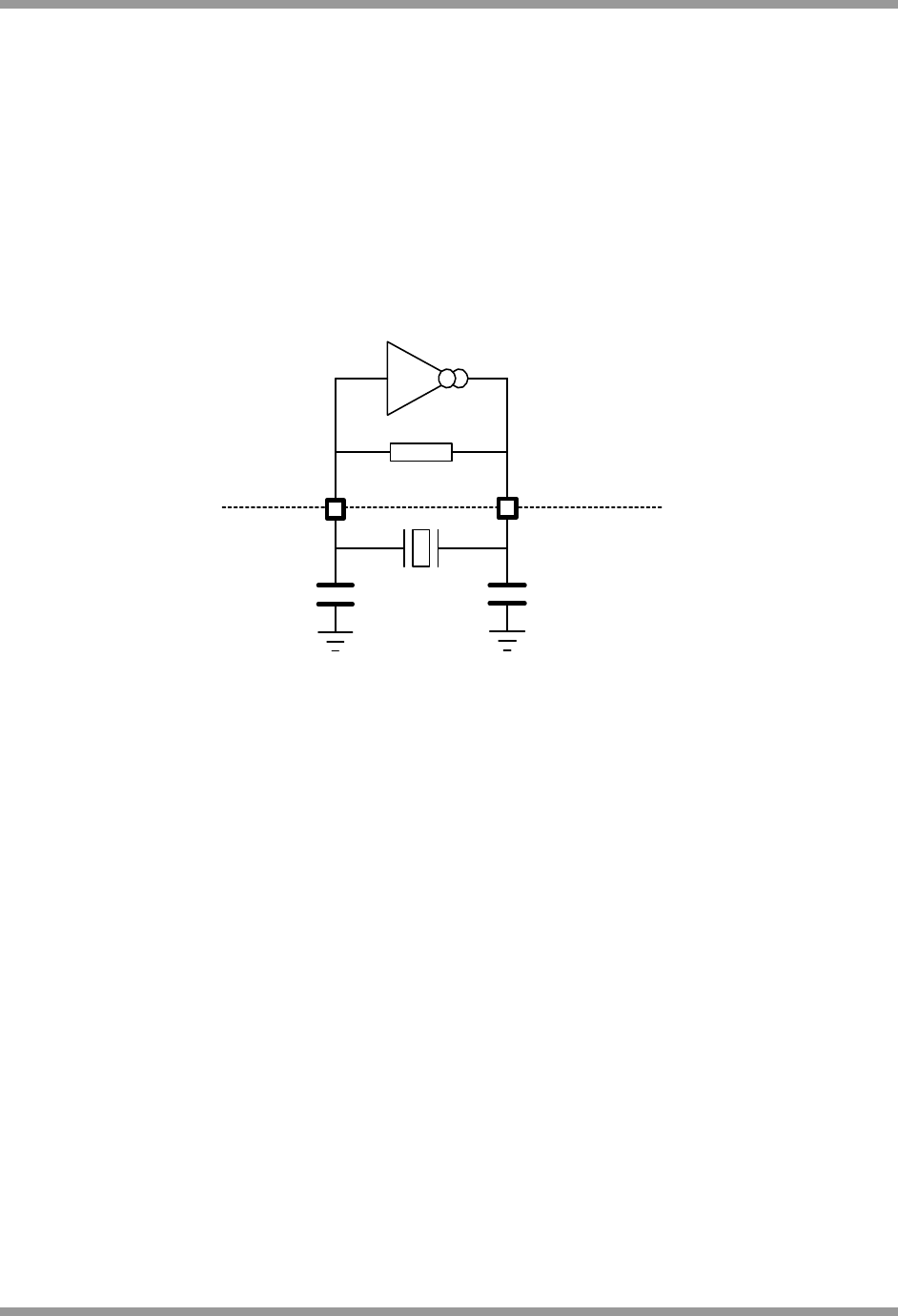
Jennic
JennicJennic
Jennic
18 JN-DS-JN5139 v1.5 © Jennic 2008
5 System Clocks
Two separate oscillators are used to provide system clocks: a crystal-controlled 16MHz oscillator, using an external
crystal and an internal, RC-based 32kHz oscillator.
5.1 16MHz Oscillator
The JN5139 contains the necessary on-chip components to build a 16 MHz reference oscillator with the addition of
an external crystal resonator and two tuning capacitors. The schematic of these components are shown in Figure 9.
The two capacitors, C1 and C2, should be 15pF ±5% and use a COG dielectric. Due to the small size of these
capacitors, it is important to keep the traces to the external components as short as possible. The on-chip
transconductance amplifier is compensated for temperature variation, and is self-biasing by means of the internal
resistor R1. The electrical specification of the oscillator can be found in section 17.3.6.
For detailed application
support and specification of the crystal required see Appendix B.1.
XTALOUT
C2
C1
R1
XTALIN
JN5139
Figure 9: Crystal oscillator connections
The clock generated by this oscillator provides the reference for most of the JN5139 subsystems, including the
transceiver, processor, memory and digital and analogue peripherals.
5.2 32kHz Oscillator
The internal 32kHz RC oscillator requires no external components. It provides a low speed clock for use in sleep
mode. The clock is used for timing the length of a sleep period (see section 16 Power Management and Sleep
Modes) and also to generate the system clock used internally during reset. The internal timing components of the
oscillator have a wide tolerance due to manufacturing process variation and so the oscillator runs nominally at 32kHz
±30%. To make this useful as a timing source for accurate wakeup from sleep, a frequency calibration factor derived
from the more accurate 16MHz oscillator may be applied. The calibration factor is derived through software, details
can be found in section 12.3.1. For detailed electrical specifications, see section 17.3.5.

Jennic
JennicJennic
Jennic
© Jennic 2008 JN-DS-JN5139 v1.5 19
6 Reset
A system reset initialises the device to a predefined state and forces the CPU to start program execution from the
reset vector. The reset process that the JN5139 goes through is as follows.
When power is applied, the 32kHz oscillator starts up and stabilises, which takes approximately 100µsec. At this
point, the 16MHz crystal oscillator is enabled and power is applied to the processor and digital logic. The logic blocks
are held in reset until the 16MHz crystal oscillator stabilises, which typically takes 2.5ms.
Once the oscillator is up and running the internal reset is removed from the CPU and peripheral logic and the CPU
starts to run code beginning at the reset vector, consisting of initialisation code and then optionally the resident Boot
Loader (described in JN-AN-1003 Boot Loader Operation [2]).
Section 17.3.1 provides detailed electrical data and timing.
The JN5139 has three sources of reset:
• Internal Power-on Reset
• External Reset
• Software Reset
Note: When the device exits a reset condition, device operating
parameters (voltage, frequency, temperature, etc.) must be met to ensure
operation. If these conditions are not met, then the device must be held in
reset until the operating conditions are met. (See section 17.3.1)
6.1 Internal Power-on Reset
For the majority of applications the internal power-on reset is capable of generating the required reset signal. When
power is applied to the device, the power-on reset circuit monitors the rise of the VDD supply. When VDD reaches
the specified threshold, the reset signal is generated and can be observed as a rising edge on the RESETN pin. This
signal is held internally until the power supply and oscillator stabilisation time has elapsed, at which point the internal
reset signal is then removed and the CPU is allowed to run.
RESETN Pin
Internal RESET
VDD
Figure 10: Internal Power-on Reset
If the application requires a power supply reset to be used, i.e. removing and then applying VDD, it is important that
the device decoupling capacitors are completely discharged before the VDD is re-applied. Failure to do so may inhibit
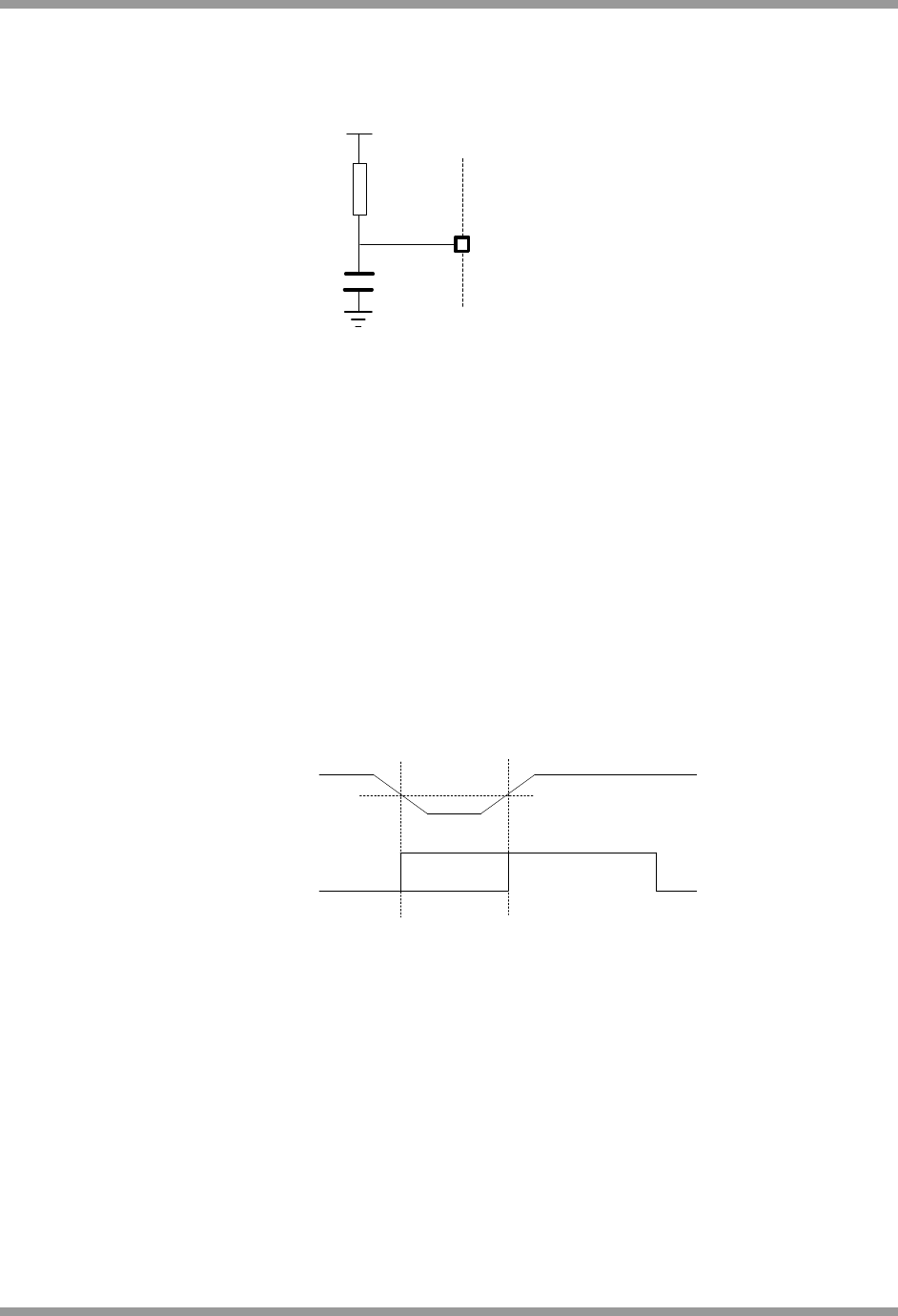
Jennic
JennicJennic
Jennic
20 JN-DS-JN5139 v1.5 © Jennic 2008
the operation of the internal power-on reset circuit. If complete discharge is difficult to achieve then it is recommended
that the external reset circuit, as shown in Figure 11, be used.
RESETN
C1
R1
JN5139
VDD
10k
100nF
Figure 11: External Reset Generation
The external resistor and capacitor provide a simple reset operation when connected to the RESETN pin.
6.2 External Reset
An external reset is generated by a low level on the RESETN pin. Reset pulses longer than the minimum pulse width
will generate a reset during active or sleep modes. Shorter pulses are not guaranteed to generate a reset. The
JN5139 is held in reset while the RESETN pin is low and when the applied signal reaches the Reset Threshold
Voltage (V
RST
) on its positive edge, the internal reset process starts.
Multiple devices may connect to the RESETN pin in an open-collector mode. The JN5139 has an internal pull-up
resistor although an external pull-up resistor is recommended when multiple devices connect to the RESETN pin.
The pin is an input for an external reset and an output during the power-on reset and software reset. No devices
should drive the RESETN pin high.
V
RST
Internal Reset
RESETN pin
Reset
Figure 12: External Reset
6.3 Software Reset
The RESETN line can be driven low by the JN5139 to provide a reset to other devices in the system (e.g. external
sensors) without resetting itself. When the RESETN line is not driven it will pull back high through either the internal
pull-up resistor or any external circuitry. It is essential to ensure that the RESETN line pulls back high within 100µsec
after the JN5139 stops driving the line (careful consideration should be taken for any capacitance on this line).
A system reset can be triggered at any time through software control. For example this can be executed within a
user’s application, upon detection of a system failure. When performing the reset, the RESETN pin is driven low for
1µsec; depending on the external components this may or may not be visible on the pin.

Jennic
JennicJennic
Jennic
© Jennic 2008 JN-DS-JN5139 v1.5 21
7 Interrupt System
The interrupt system on the JN5139 is a hardware-vectored interrupt system. The JN5139 provides several interrupt
sources, some associated with CPU operations (CPU exceptions) and others which are used by hardware in the
device. When an interrupt occurs the CPU stops executing the current program and loads its program counter with a
fixed hardware address specific to that interrupt. The interrupt handler or interrupt service routine is stored at this
location and is run on the next CPU cycle. Execution of interrupt service routines is always performed in supervisor
mode. Interrupt sources and their vector locations are listed in Table 2 below:
Interrupt Source Vector Location Interrupt Definition
Reset 0x100 Software or hardware reset
Bus Error 0x200 Bus error or attempt to access invalid physical address
Tick Timer 0x500 Tick Timer expiry
Alignment 0x600 Load/Store to naturally not aligned location
Illegal Instruction 0x700 Illegal instruction in instruction stream
Hardware Interrupts 0x800 Hardware Interrupt
System Call 0xC00 System Call Initiated by software (l.sys instruction)
Trap 0xE00 Caused by l.trap instruction
Table 2: Interrupt Vectors
7.1 System Calls
Executing the l.sys instruction causes a system call interrupt to be generated. The purpose of this interrupt is to
allow a task to switch into supervisor mode when a real time operating system is in use, see section 3 for further
details. It also allows a software interrupt to be issued, as does execution of the l.trap instruction.
7.2 Processor Exceptions
7.2.1 Bus Error
A bus error exception is generated when software attempts to access a memory address that does not exist, or is not
populated with memory or peripheral registers.
7.2.2 Alignment
Alignment exceptions are generated when software attempts to access objects that are not aligned to natural word
boundaries. 16-bit objects must be stored on even byte boundaries, while 32-bit objects must be stored on quad byte
boundaries. For instance, attempting to read a 16-bit object from address 0xFFF1 will trigger an alignment exception
as will a read of a 32-bit object from 0xFFF1, 0xFFF2 or 0xFFF3. Examples of legal 32-bit object addresses are
0xFFF0, 0xFFF4, 0xFFF8 etc.
7.2.3 Illegal Instruction
If the CPU reads an unrecognised instruction from memory as part of its instruction fetch, it will cause an illegal
instruction exception.
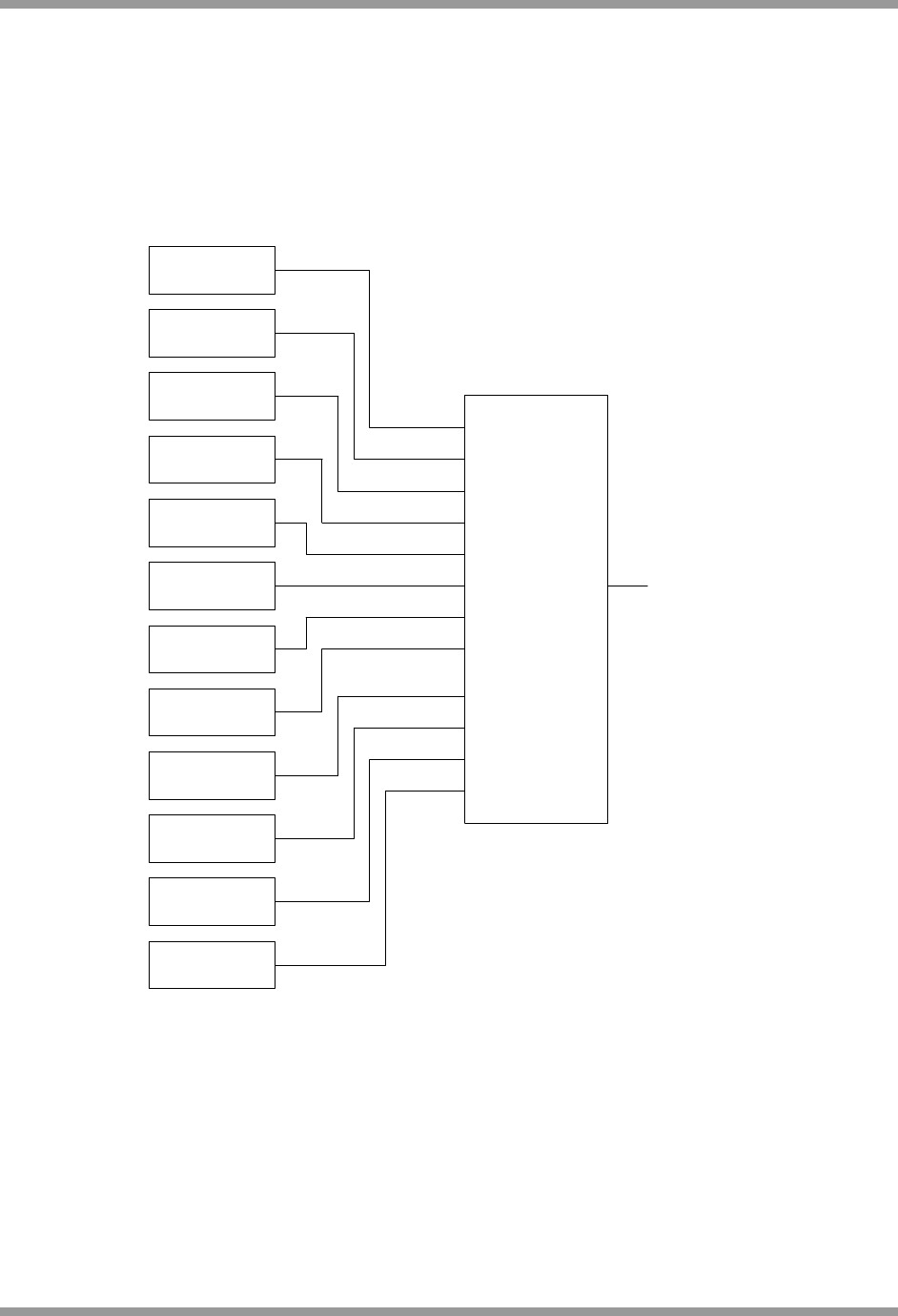
Jennic
JennicJennic
Jennic
22 JN-DS-JN5139 v1.5 © Jennic 2008
7.3 Hardware Interrupts
Hardware interrupts generated from the transceiver, analogue or digital peripherals and DIO pins are individually
masked using the Programmable Interrupt Controller (PIC). Management of interrupts is provided in the peripherals
library. Further details of interrupts are provided for the functions in their respective sections in this datasheet.
Interrupts are used to wake the JN5139 from sleep. The peripherals, baseband controller, security coprocessor and
PIC are powered down during sleep but the DIO interrupts and optionally the wake-up timers and analogue
comparator interrupts remain powered to bring the JN5139 out of sleep.
Wake-up
Timers
Baseband
Controller
Hardware
Interrupt
Security
Coprocessor
DIO Pins
UART0
UART1
Timer0
Timer1
2-wire Serial
Interface
SPI Controller
Intelligent
Peripheral
Analogue
Peripheral
Programmable
Interrupt
Controller
Figure 13: Programmable Interrupt Controller
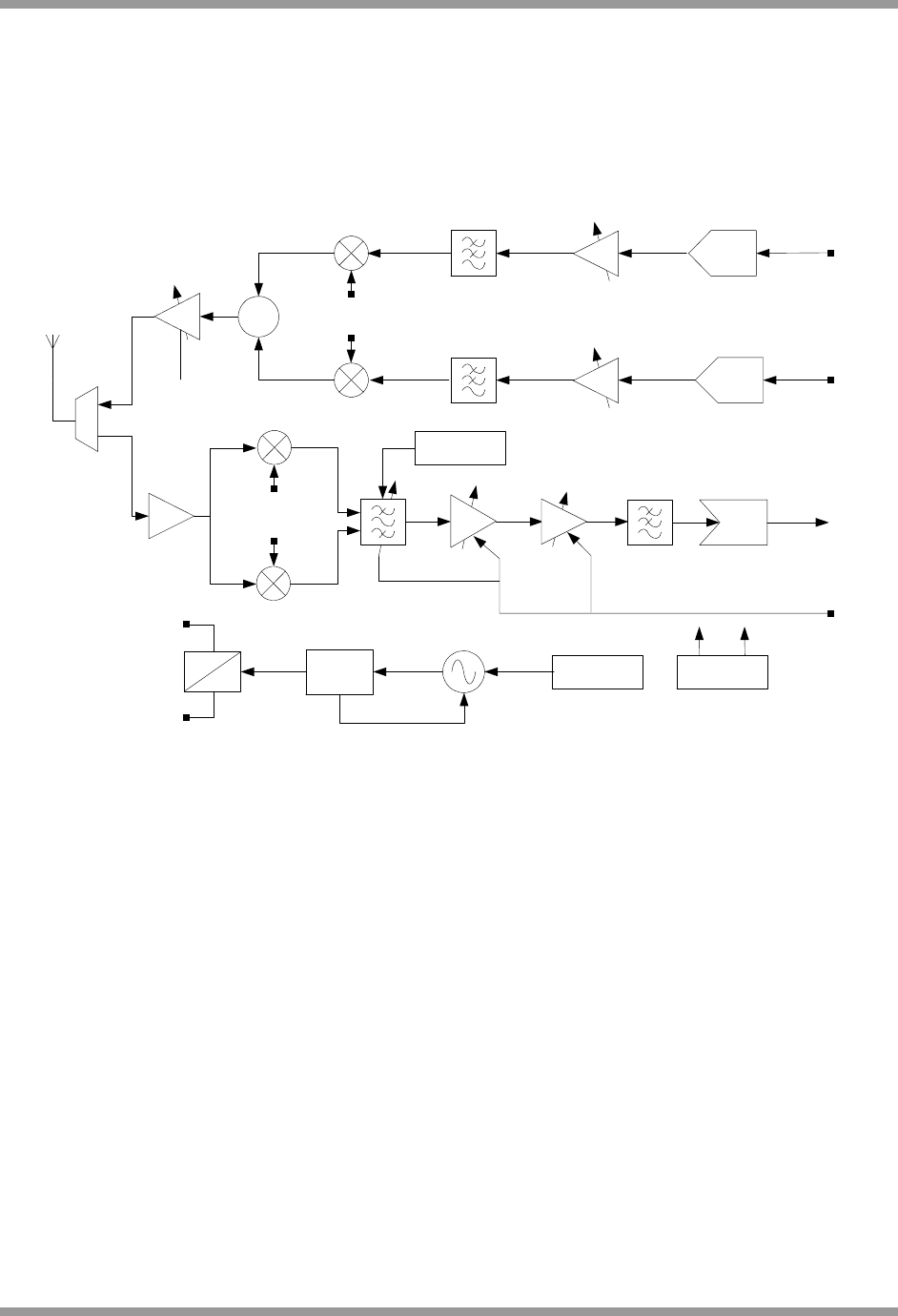
Jennic
JennicJennic
Jennic
© Jennic 2008 JN-DS-JN5139 v1.5 23
8 Wireless Transceiver
The wireless transceiver comprises a 2.45GHz radio, an O-QPSK modem, a baseband processor, a security
coprocessor and PHY controller. These blocks, with protocol software provided as a library, implement an
IEEE802.15.4 standards-based wireless transceiver that transmits and receives data over the air in the unlicensed
2.4GHz band.
8.1 Radio
IDATA
QDATA
IF DATA
AGC
DAC
DAC
PA
PA
Power
PA (I)
Trim
PA (Q)
Trim
∑
Calibration
Reference
& BIAS
ADC
LNA
TX
RX
VGA2
VGA1
VGA
VGA
PLL
90
0
LOI
LOQ
LOI
LOQ
LOI
LOQ
Calibration
VCO
Figure 14: Radio Architecture
The radio comprises a low-IF receive path and a direct up-conversion transmit path, which converge at the TX/RX
switch. This switch includes the necessary matching components such that a 200Ω differential antenna may be
directly connected without external components. Alternatively, a balun can be used for single ended antennas.
The 16MHz crystal oscillator feeds a divider, which provides the frequency synthesiser with a reference
frequency. The synthesiser contains programmable feedback dividers, phase detector, charge pump and internal
Voltage Controlled Oscillator (VCO). The VCO has no external components, and includes calibration circuitry to
compensate for differences in internal component values due to process and temperature variations. The VCO is
controlled by a Phase Locked Loop (PLL) that has a loop filter comprising 3 external components. A programmable
charge pump is also used to tune the loop characteristic. Finally, quadrature (I and Q) local oscillator signals for the
mixer drives are derived.
The receiver chain starts with the low noise amplifier / mixer combination whose outputs are passed to the polyphase
bandpass filter. This filter provides the channel definition as well as image frequency rejection. The signal is then
passed to two variable gain amplifier blocks. The gain control for these stages and the bandpass filter is derived in
the automatic gain control (AGC) block within the Modem. The signal is conditioned with the anti-alias low pass filter
before being converted to a digital signal with a flash ADC.
In the transmit direction, the digital I and Q streams from the Modem are passed to I and Q quadrature DAC blocks
which are buffered and low-pass filtered, before being applied to the modulator mixers. The summed 2.4 GHz signal
is then passed to the RF Power Amplifier (PA), whose power control can be selected from one of six settings. The
output of the PA drives the antenna via the RX/TX switch.
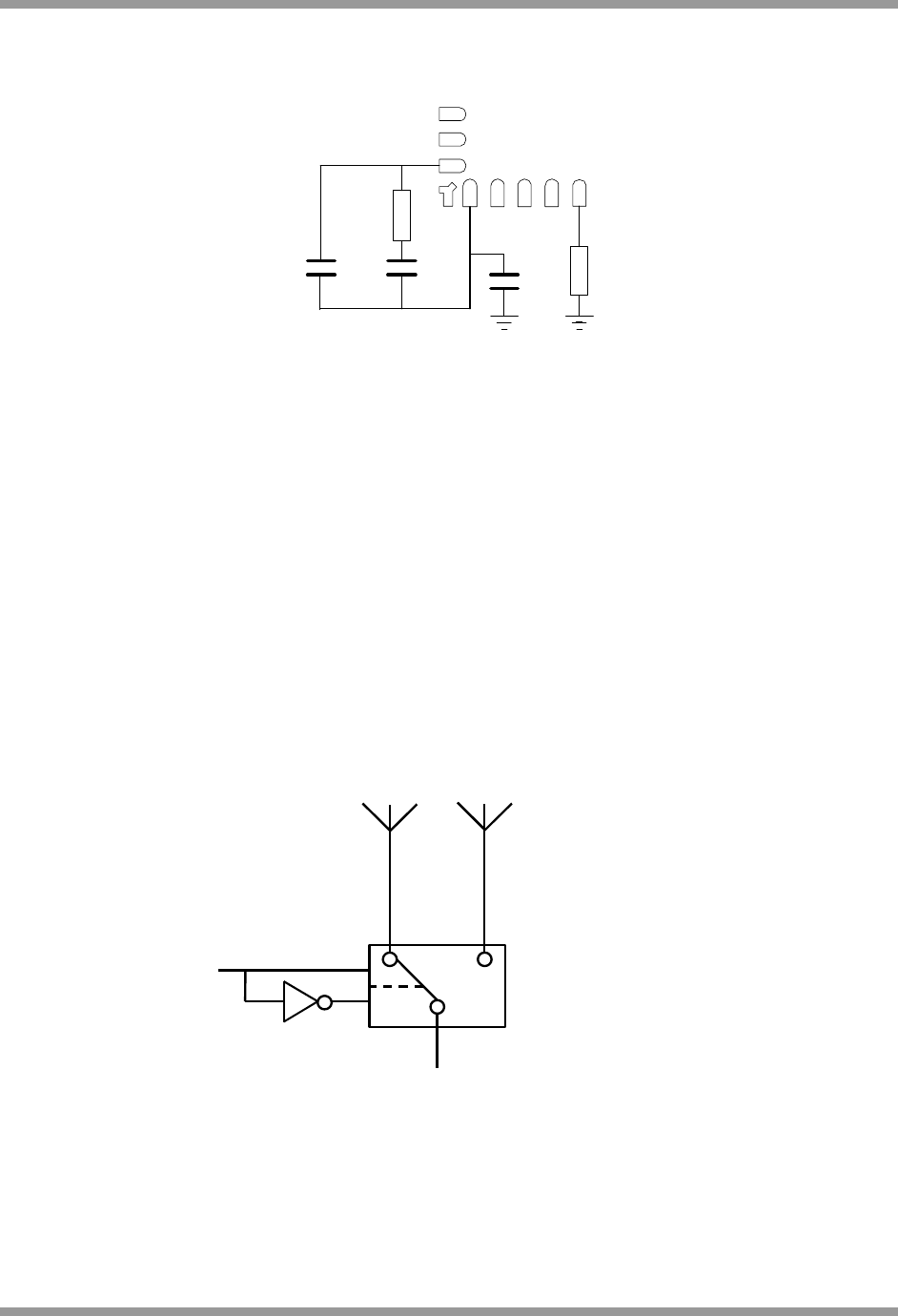
Jennic
JennicJennic
Jennic
24 JN-DS-JN5139 v1.5 © Jennic 2008
8.1.1 Radio External components
The VCO loop filter requires three external components and the IBIAS pin requires one external component as shown
in Figure 15. These components should be placed close to the JN5139 pins and analogue ground.
15
VCOTUNE
3n3F
330pF
4k7
1% VB_VCO
19
43k
1%
VSSA
IBIAS
VSSA
100nF
Figure 15: VCO Loop Filter and IBIAS
The radio is powered from a number of internal 1.8V regulators fed from the analogue supply VDD1, in order to
provide good noise isolation between the digital logic of the JN5139 and the analogue blocks. These regulators are
also controlled by the baseband controller and protocol software to minimise power consumption. Decoupling for
internal regulators is required as described in section 2.2.1, Power Supplies.
8.1.2 Antenna Diversity
Support is provided for antenna diversity. Antenna diversity is a technique that maximises the performance of an
antenna system. It allows the radio to switch between two antennas that have very low correlation between their
received signals. Typically, this is achieved by spacing two antennas around 0.25 wavelengths apart or by using two
orthogonal polarisations. So, if a packet is transmitted and no acknowledgement is received, the radio system can
switch to the other antenna for the retry, with a different probability of success.
The JN513x provides an output on DIO12 that is asserted on odd numbered retries that can be used to control an
antenna switch; this enables antenna diversity to be implemented easily (see Figure 16 and Figure 17)
Antenna A
ADO (DIO[12])
Antenna B
Device RF Port
RF Switch: Single-Pole, Double-Throw (SPDT)
A B
COM
SEL
SELB
Figure 16 Simple Antenna Diversity Implementation using External RF Switch
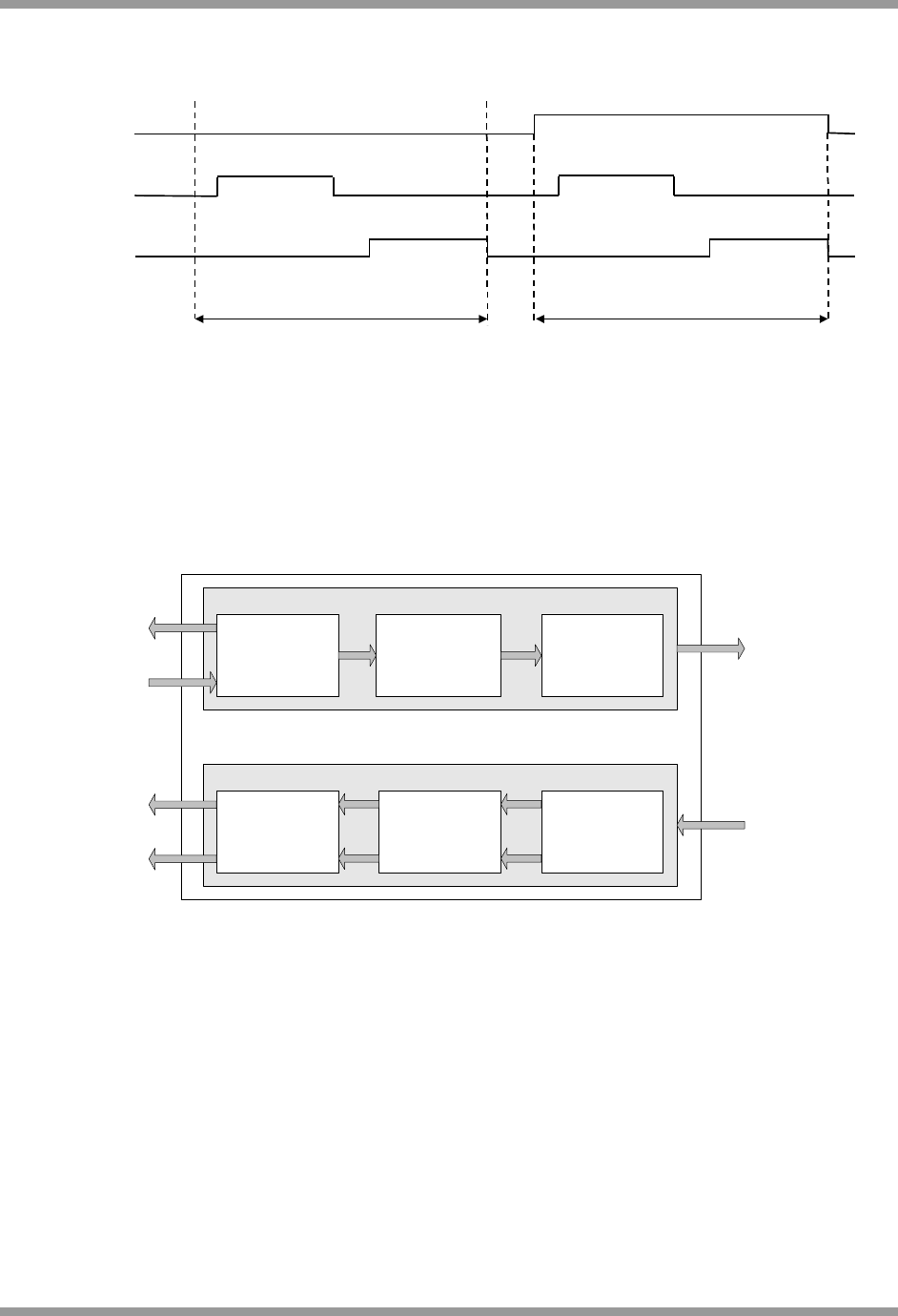
Jennic
JennicJennic
Jennic
© Jennic 2008 JN-DS-JN5139 v1.5 25
TX Active
ADO (DIO[12])
1
st
TX-RX Cycle 2
nd
TX-RX Cycle (1
st
Retry)
RX Active
Figure 17 Antenna Diversity ADO Signal for TX with Acknowledgement
8.2 Modem
The Modem performs all the necessary modulation and spreading functions required for digital transmission and
reception of data at 250kbps in the 2450MHz radio frequency band in compliance with the IEEE802.15.4 standard.
AGC O-QPSK
Demodulation
Symbol
Detection
(Despreading)
Pulse Shaping O-QPSK
Modulation Spreading
TX
RX
TX Data
Interface
RX Data
Interface
I
Q
I
I
Q
Q
IF Signal
Gain
Figure 18: Modem Architecture
The transmitter receives symbols from the baseband processor and uses the spreading function to map each unique
4-bit symbol to a 32-chip Pseudo-random Noise (PN) sequence. Offset-QPSK modulation and half-sine pulse
shaping is applied to the resultant spreading sequence to produce two independent quadrature phase signals (I and
Q), which are subsequently converted to analogue voltages in the radio transmit path.
The Automatic Gain Control (AGC) monitors the received signal level and adjusts the gain of the amplifiers in the
radio receiver to ensure that the optimum signal amplitude is maintained during reception.
The demodulator performs digital IF down-conversion and matched filtering and is extremely tolerant to carrier
frequency offsets in excess of ±80ppm without suffering any significant degradation in performance.
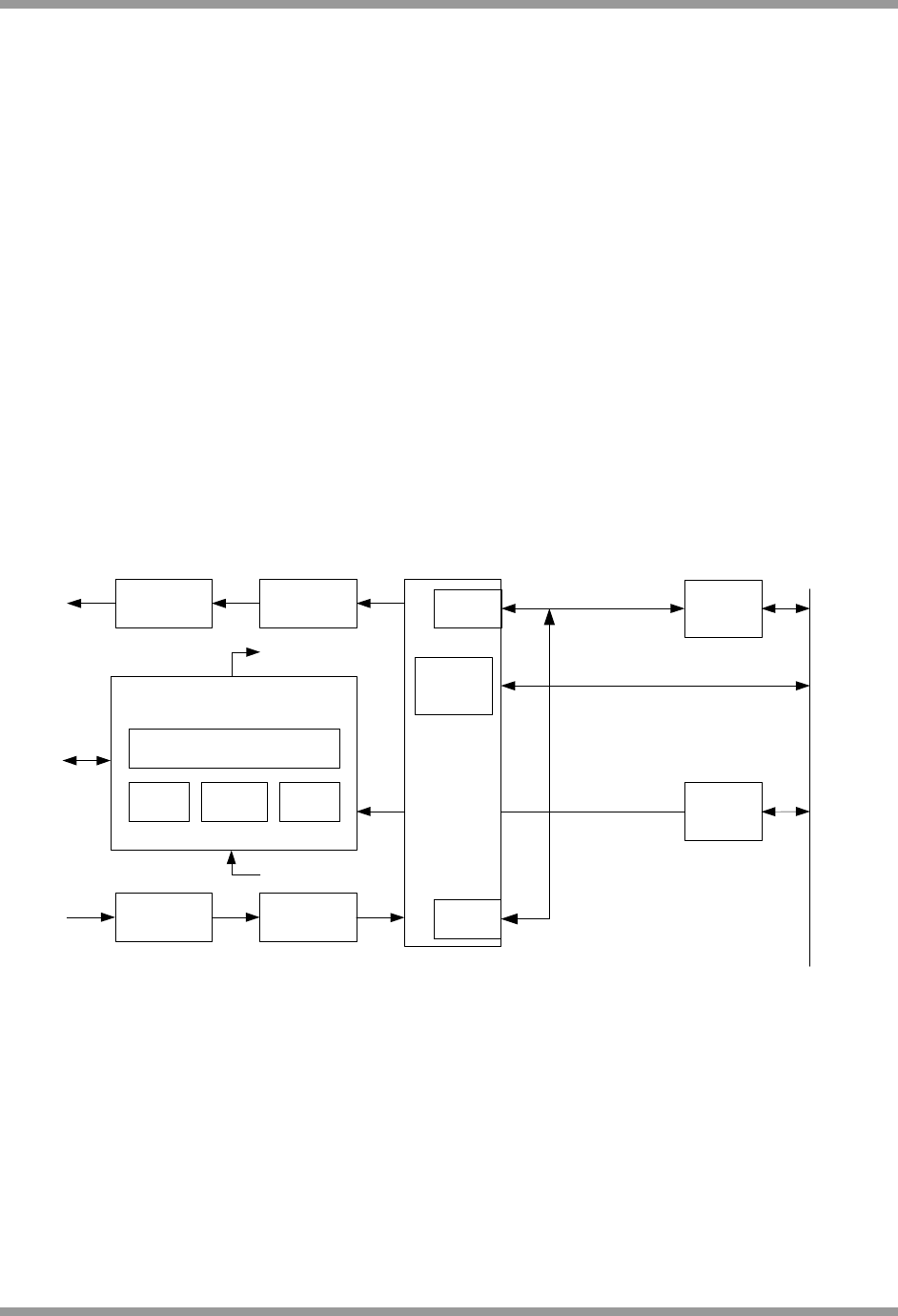
Jennic
JennicJennic
Jennic
26 JN-DS-JN5139 v1.5 © Jennic 2008
Symbol detection and synchronization is performed using direct sequence correlation techniques in conjunction with
searches for the Preamble and Start-of-Frame Delimiter (SFD) fields contained in the transmitted IEEE 802.15.4
Synchronization Header (SHR).
Features are provided to support network channel selection algorithms include Energy Detection (ED), Link Quality
Indication (LQI) and fully programmable Clear Channel Assessment (CCA).
The Modem provides a digital Receive Signal Strength Indication (RSSI) that facilitates the implementation of the
IEEE 802.15.4 ED function.
The LQI is defined in the IEEE 802.15.4 standard as a characterization of the strength and/or data quality of a
received packet. The Modem produces a signal quality metric based upon correlation magnitudes, which may be
used in conjunction with the ED value to formulate the LQI.
The CCA capability of the Modem supports all modes of operation defined in the IEEE 802.15.4 standard, namely
Energy above ED threshold, Carrier Sense and Carrier Sense and/or energy above ED threshold.
8.3 Baseband Processor
The baseband processor provides all time-critical functions of the IEEE802.15.4 MAC layer. Dedicated hardware
guarantees air interface timing is precise. The MAC layer hardware/software partitioning enables software to
implement the sequencing of events required by the protocol and to schedule timed events with millisecond
resolution, and the hardware to implement specific events with microsecond timing resolution. The protocol software
layer performs the higher-layer aspects of the protocol, sending management and data messages between endpoint
and coordinator nodes, using the services provided by the baseband processor.
Append
Checksum
Verify
Checksum
CSMA CCA Backoff
Control
Deserialiser
Serialiser Tx/Rx
Frame
Buffer
Protocol
Timers
Tx
Bitstream
Rx
Bitstream
Protocol Timing Engine
Supervisor
Radio
Status
Control
AES
Codec
Inline
Security
Decrypt
Port
Encrypt
Port
AES
Codec
Processor
Bus
Figure 19: Baseband Processor
8.3.1 Transmit
A transmission is performed by software writing the data to be transferred into the Tx/Rx Frame Buffer, together with
parameters such as the destination address and the number of retries allowed, and programming one of the protocol
timers to indicate the time at which the frame is to be sent. This time will be determined by the software tracking the
higher-layer aspects of the protocol such as superframe timing and slot boundaries. Once the packet is prepared and
protocol timer set, the supervisor block controls the transmission. When the scheduled time arrives, the supervisor
controls the sequencing of the radio and modem to perform the type of transmission required. It can perform all the

Jennic
JennicJennic
Jennic
© Jennic 2008 JN-DS-JN5139 v1.5 27
algorithms required by IEEE802.15.4 such as CSMA/CA including retries and random backoffs without processor
intervention.
When the transmission begins, the header of the frame is constructed from the parameters programmed by the
software and sent with the frame data through the serialiser to the Modem. At the same time, the radio is prepared
for transmission. During the passage of the bitstream to the modem, it passes through a CRC checksum generator
that calculates the checksum on-the-fly, and appends it to the end of the frame.
If using slotted access, it is possible for a transmission to overrun the time in its allocated slot; the Baseband
Processor handles this situation autonomously and notifies the protocol software via interrupt, rather than requiring it
to handle the overrun explicitly.
8.3.2 Reception
In a reception, the radio is set to receive on a particular channel. On receipt of data from the modem, the frame is
directed into the Tx/Rx Frame Buffer where both header and frame data can be read by the protocol software. An
interrupt may be provided on receipt of the frame header. As the frame data is being received from the modem it is
passed through a checksum generator; at the end of the reception the checksum result is compared with the
checksum at the end of the message to ensure that the data has been received correctly.
During reception, the modem determines the Link Quality, which is made available at the end of the reception as part
of the requirements of IEEE802.15.4.
8.3.3 Auto Acknowledge
Part of the protocol allows for transmitted frames to be acknowledged by the destination sending an acknowledge
packet within a very short window after the transmitted frame has been received. The JN5139 baseband processor
can automatically construct and send the acknowledgement packet without processor intervention and hence avoid
the protocol software being involved in time-critical processing within the acknowledge sequence. The JN5139
baseband processor can also request an acknowledge for packets being transmitted and handle the reception of
acknowledged packets without processor intervention.
8.3.4 Beacon Generation
In beaconing networks, the baseband processor can automatically generate and send beacon frames; the repetition
rate of the beacons is programmed by the CPU, and the baseband then constructs the beacon contents from data
delivered by the CPU. The baseband processor schedules the beacons and transmits them without CPU
intervention.
8.3.5 Security
The baseband processor supports the transmission and reception of secured frames using the Advanced Encryption
Standard (AES) algorithm transparently to the CPU. This is done by passing incoming and outgoing data through an
in-line security engine that is able to perform encryption and decryption operations on-the-fly, resulting in minimal
processor intervention. The CPU must provide the appropriate encrypt/decrypt keys for the transmission or
reception. On transmission, the key can be programmed at the same time as the rest of the frame data and setup
information.
During reception, the CPU must look up the key and provide it from information held in the header of the incoming
frame. However, the hardware of the security engine can process data much faster than the incoming frame data
rate. This means that it is possible to allow the CPU to receive the interrupt from the header of an incoming packet,
read where the frame originated, look up the key and program it to the security hardware before the end of the frame
has arrived. By providing a small amount of buffering to store incoming data while the lookup process is taking place,
the security engine can catch up processing the frame so that when the frame arrives in the receive frame buffer it is
fully decrypted.
8.4 Security Coprocessor
As well as being used during in-line encryption/decryption operations over a streaming interface and in external
memory encryption, it is also possible to use the AES core as a coprocessor to the CPU of the JN5139. To allow the
hardware to be shared between the two interfaces an arbiter ensures that the streaming interface to the AES core
always has priority, to ensure that in-line processing can take place at any time.
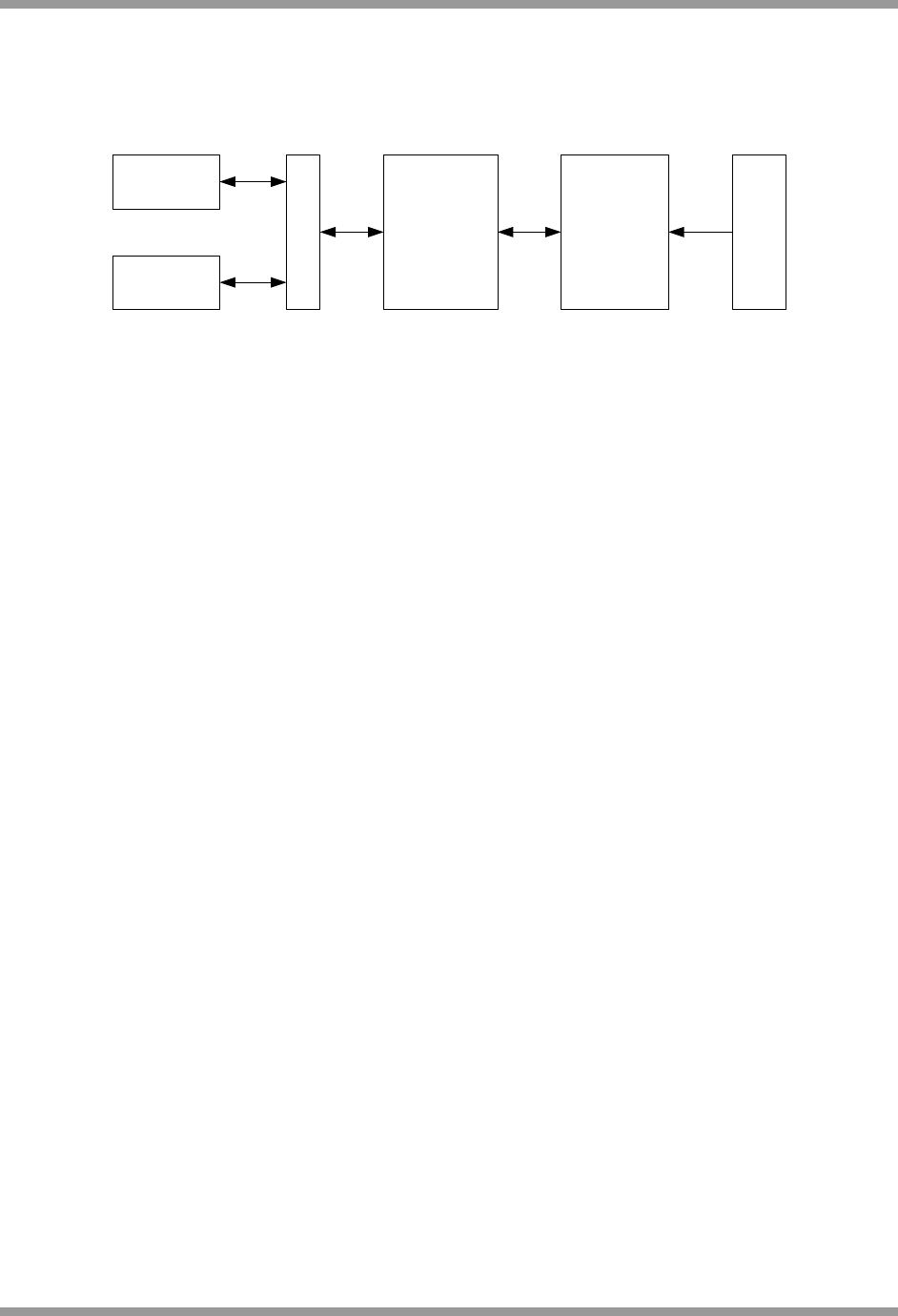
Jennic
JennicJennic
Jennic
28 JN-DS-JN5139 v1.5 © Jennic 2008
Some protocols (for example ZigBee) require that security operations can be performed on buffered data rather than
in-line. A hardware implementation of the encryption engine significantly speeds up the processing of the contents of
these buffers. The Security Coprocessor can be accessed through software to allow the contents of memory buffers
to be transformed. Information such as the type of security operation to be performed and the encrypt/decrypt key to
be used must also be provided.
Processor
Interface
In-line
Interface
Arbiter
AES
Block
Encrpytion
Controller
AES
Encoder
Key Generation
Figure 20: Security Coprocessor Architecture
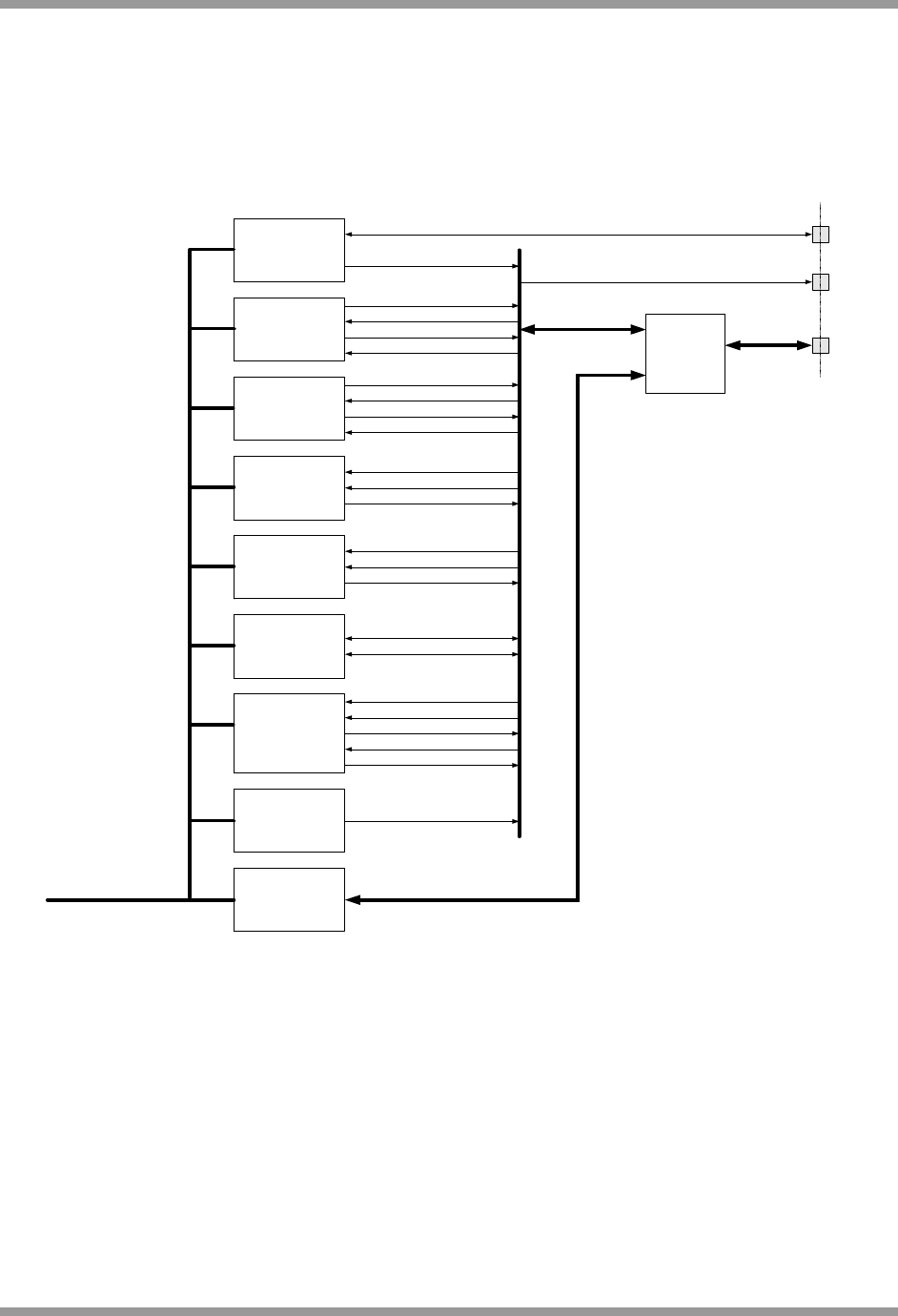
Jennic
JennicJennic
Jennic
© Jennic 2008 JN-DS-JN5139 v1.5 29
9 Digital Input/Output
There are 21 Digital I/O (DIO) pins, which can be configured as either an input or an output, and each has a
selectable internal pull-up resistor. Most DIO pins are multiplexed with alternate peripheral features of the device.
Once a peripheral is enabled it takes precedence over the device pins. Refer to the individual module sections for a
full description of the alternate peripherals functions. Following a reset (and whilst the reset input is held low), all
peripherals are off and the DIO pins are configured as inputs with the internals pull-ups turned on.
SPI Port
UART 0
UART 1
Counter/Timer 0
Counter/Timer 1
MUX
RFTX
Chip
Pins
2-Wire Serial
Interface
GPIO
Data / Direction
Registers
DIO<20:0>
DIO<20:0>
SPISEL<4:0>
Processor Bus
(Address, Data, Interrupts)
SPICLK, MOSI, MISO
SPISEL<0>
TxD
CTS
RxD
RTS
TxD
CTS
RxD
RTS
TIM0CK_GT
TIM0CAP
TIM0OUT
TIM1CK_GT
TIM1CAP
TIM1OUT
SIF_CLK
SIF_D
RFTX
Intelligent
Peripheral
IP_CLK
IP_SEL
IP_DI
IP_DO
IP_INT
Figure 21: DIO Block Diagram
When a peripheral is not enabled, the DIO pins associated with it can be used as digital inputs or outputs. Each pin
can be controlled individually by setting the direction and then reading or writing to the pin.
The individual pull-up resistors, R
PU
, can also be enabled or disabled as needed. These are generally configured
once after reset depending on the external components and functionality. The setting is held through sleep cycles.
When configured as an input each pin can be used to generate an interrupt upon a change of state (selectable
transition either from low to high or high to low); the interrupt can be enabled or disabled. When the device is
sleeping, these interrupts become events that can be used to wake the device up. The interrupt transition edges can
be configured, and interrupts can be enabled and/or masked. Equally the status of the interrupt may be read. See
section 16 Power Management and Sleep Modes for further details on sleep and wakeup.
Where a pin is configured for output but is read as an input, then the output pin state will be read back.
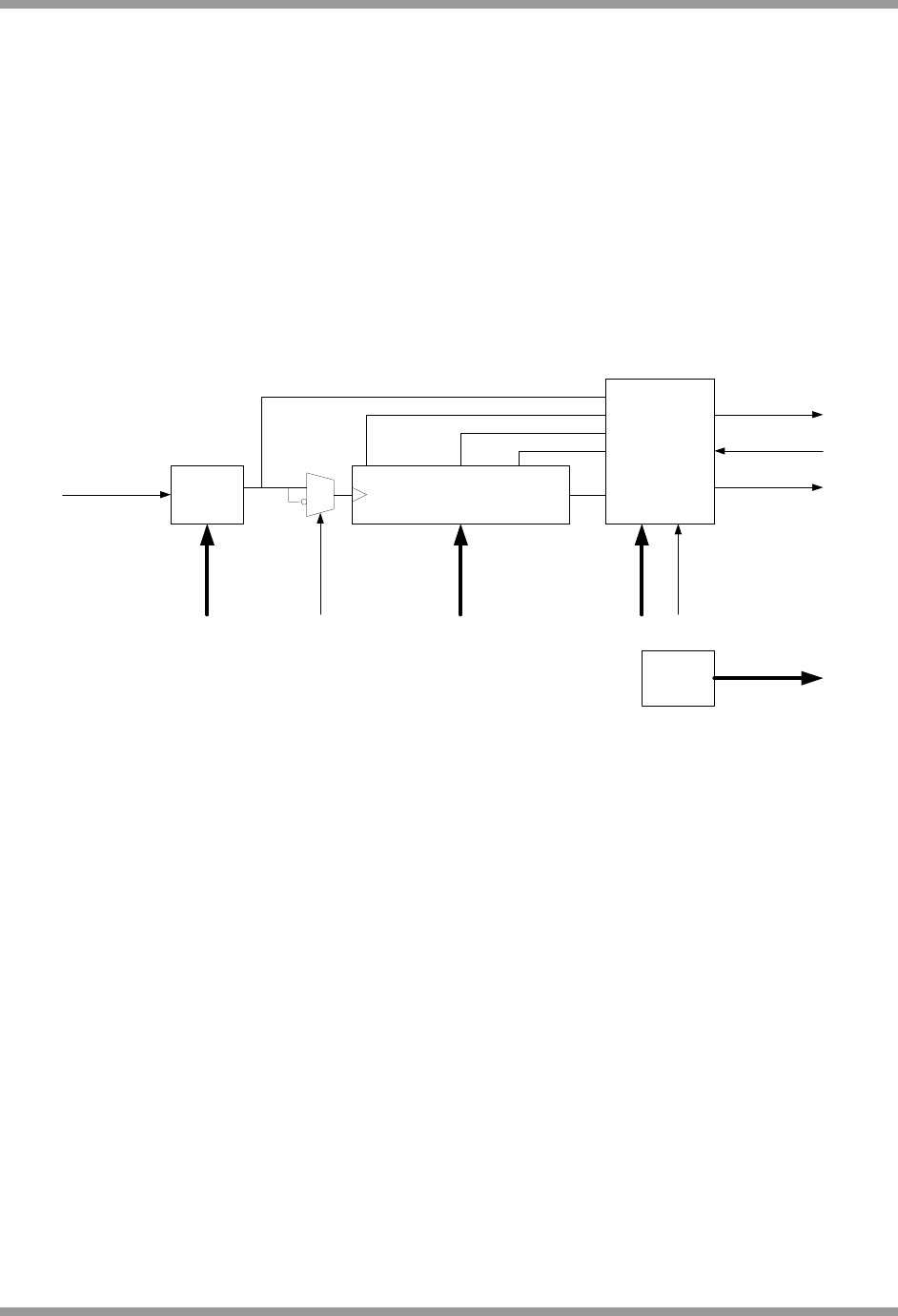
Jennic
JennicJennic
Jennic
30 JN-DS-JN5139 v1.5 © Jennic 2008
10 Serial Peripheral Interface
The Serial Peripheral Interface (SPI) allows high-speed synchronous data transfer between the JN5139 and
peripheral devices. The JN5139 operates as a master on the SPI bus and all other devices connected to the SPI are
expected to be slave devices under the control of the JN5139 CPU. The SPI includes the following features:
•
Full-duplex, three-wire synchronous data transfer
•
Programmable bit rates up to 16Mbps
•
Programmable transaction size of 8,16 or 32 bits
•
Supports standard SPI modes 0, 1, 2, 3 to allow control over the relationship between clock and transmit /
receive data
•
Automatic slave select generation (up to 5 slaves)
•
Maskable transaction complete interrupt
•
LSB First or MSB First Data Transfer
Clock
Divider
SPI Bus
Cycle
Controller
Data Buffer
31 15 7
DIV
Clock Edge
Select
Data
CHAR_LEN
LSB
SPIMISO
SPIMOSI
SPICLK
Select
Latch
SPISEL [4..0]
16 MHz
0
Figure 22: SPI Block Diagram
The SPI bus employs a simple shift register data transfer scheme. Data is clocked out of and into the active devices
in a first-in, first-out fashion allowing SPI devices to transmit and receive data simultaneously.
There are three dedicated pins SPICLK, SPIMOSI, SPIMISO that are shared across all devices on the bus. Master-
Out-Slave-In or Master-In-Slave-Out data transfer is relative to the clock signal SPICLK generated by the JN5139.
The JN5139 provides five slave selects, SPISEL0 to SPISEL4 to allow five SPI peripherals on the bus. SPISEL0 is a
dedicated pin and SPISEL1 to 4, are alternate functions of pins DIO0 to 3 respectively. This allows a serial flash
memory to be connected to SPISEL0 and download to internal RAM via software from reset.
The interface can transfer 8, 16 or 32 bits without software intervention and can keep the slave select lines asserted
between transfers when required, to enable longer transfers to be performed.
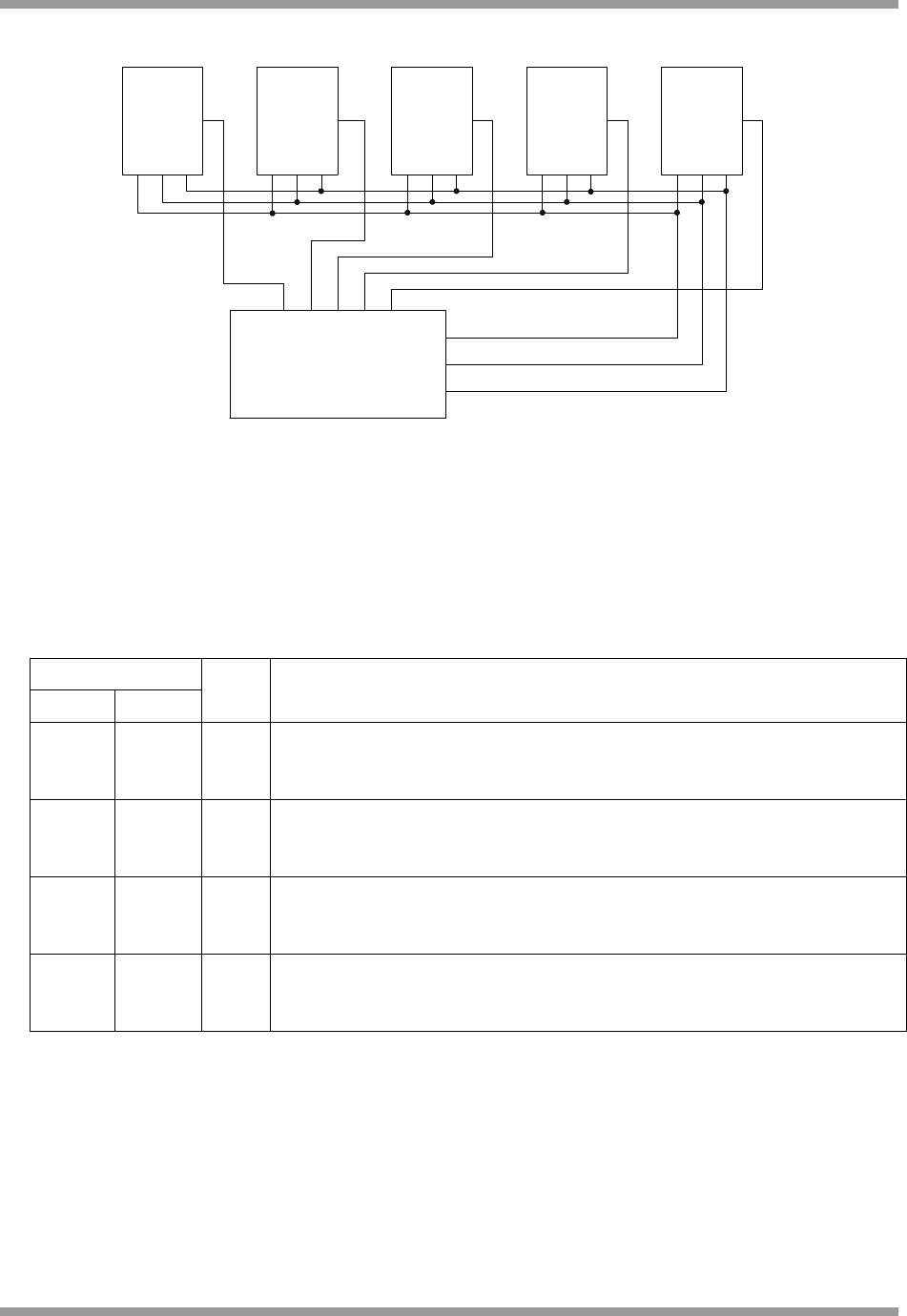
Jennic
JennicJennic
Jennic
© Jennic 2008 JN-DS-JN5139 v1.5 31
SI
SO
C
SS
Slave 0
Flash
Memory
JN5139
37
38
41
42
43
36
33
34
SI
SO
C
SS
Slave 1
User
Defined
SI
SO
C
SS
Slave 2
User
Defined
SI
SO
C
SS
Slave 3
User
Defined
SI
SO
C
SS
Slave 4
User
Defined
SPIMISO
SPIMOSI
SPICLK
SPISEL4
SPISEL2
SPISEL3
SPISEL1
SPISEL0
Figure 23: Typical JN5139 SPI Peripheral Connection
The data transfer rate on the SPI bus is determined by the SPICLK signal. The JN5139 supports transfers at
selectable data rates from 16MHz to 250kHz selected by a clock divider. Both SPICLK clock phase and polarity are
configurable. The clock polarity controls if SCLK is high or low between transfers (and hence the polarity of the first
clock edge in a transfer). The clock phase and polarity determines which edge of SPICLK is used by the JN5139 to
present new data on the SPIMOSI line; the opposite edge will be used to read data from the SPIMISO line.
SPICLK
Polarity Phase Mode Description
0 0 0 SPICLK is low when idle – the first edge is positive.
Valid data is output on SPIMOSI before the first clock and changes every
negative edge. SPIMISO is sampled every positive edge.
0 1 1 SPICLK is low when idle – the first edge is positive.
Valid data is output on SPIMOSI every positive edge. SPIMISO is sampled every
negative edge.
1 0 2 SPICLK is high when idle – the first edge is negative.
Valid data is output on SPIMOSI before the first clock edge and is changed
every positive edge. SPIMISO is sampled every negative edge.
1 1 3 SPICLK is high when idle – the first edge is negative.
Valid data is output on SPIMOSI every negative edge. SPIMISO is sampled
every positive edge.
Table 3 SPI Configurations
If more than one SPISEL line is to be used in a system they must be used in numerical order, for instance if 3 SPI
select lines are to be used, they must be SPISEL0, 1 and 2. A SPISEL line can be configured to automatically
deassert between transactions if required, or it may stay asserted over a number of transactions. For devices such
as memories where a large amount of data can be received by the master by continually providing SPICLK
transitions, the ability for the select line to stay asserted is an advantage since it keeps the slave enabled over the
whole of the transfer.

Jennic
JennicJennic
Jennic
32 JN-DS-JN5139 v1.5 © Jennic 2008
A transaction commences with the SPI bus being set to the correct configuration, and then the slave device is
selected. Upon commencement of transmission (8, 16 or 32 bits) data is placed in the FIFO data buffer and clocked
out, at the same time generating the corresponding SPICLK transitions. Since the transfer is full-duplex, the same
number of data bits is being received from the slave as it transmits. The data that is received during this transmission
can be read 8, 16 or 32 bits. If the master simply needs to provide a number of SPICLK transitions to allow data to
be sent from a slave, it should perform transmit using dummy data. An interrupt can be generated when the
transaction has completed or alternatively the interface can be polled.
If a slave device wishes to signal the JN5139 indicating that it has data to provide, it may be connected to one of the
DIO pins that can be enabled as an interrupt.
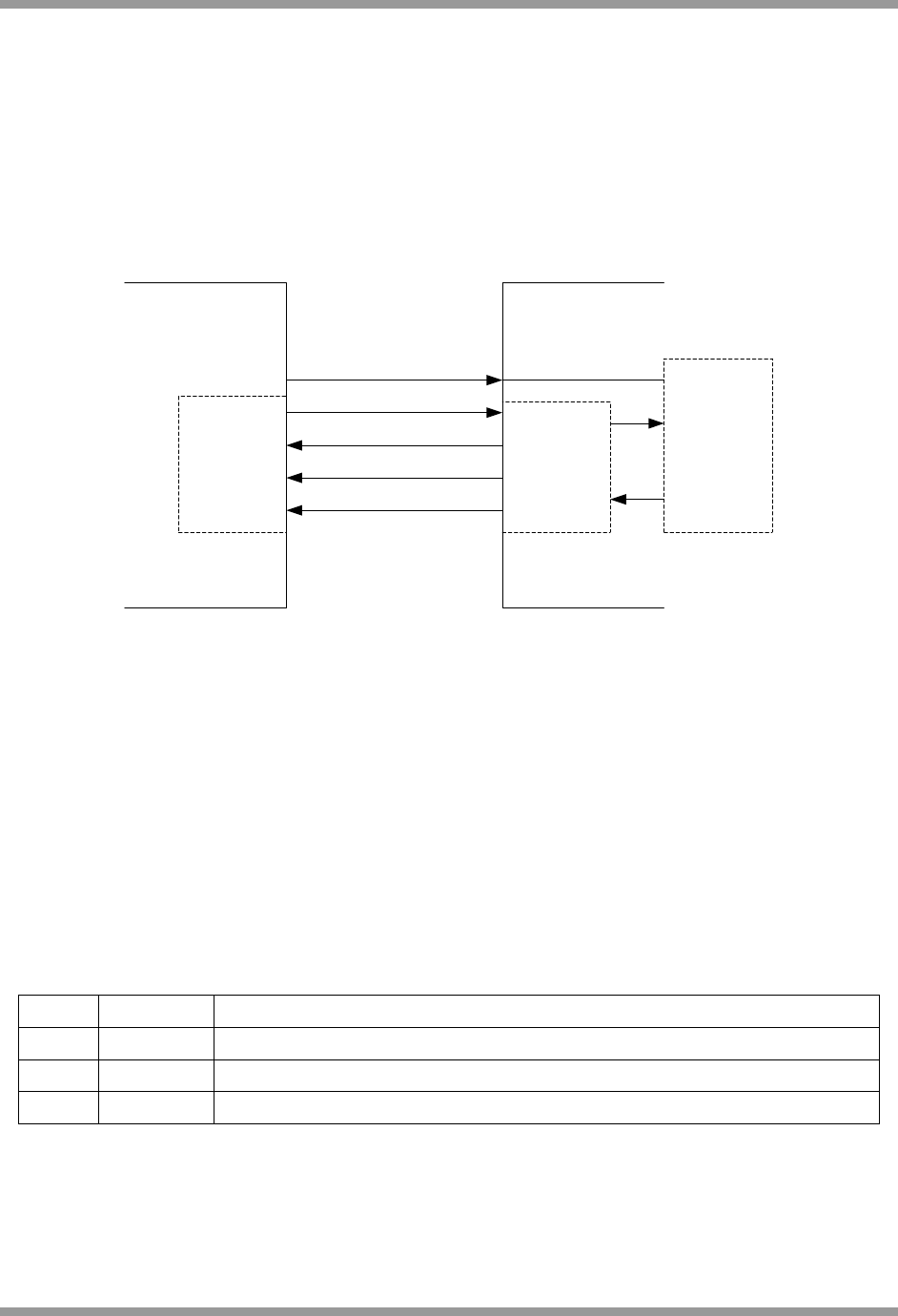
Jennic
JennicJennic
Jennic
© Jennic 2008 JN-DS-JN5139 v1.5 33
11 Intelligent Peripheral Interface
The Intelligent Peripheral (IP) Interface is provided for systems that are more complex, where there is a processor
that requires a wireless peripheral. As an example, the JN5139 may provide a complete IEEE802.15.4, ZigBee or
other wireless network to a phone, computer, PDA, set-top box or games console. No resources are required from
the main processor compared to a transceiver as the complete wireless protocol may be run on the internal JN5139
CPU. The wireless peripheral may be controlled via one of the UARTs but the IP interface is intended to provide a
high-speed, low-processor-overhead interface.
The intelligent peripheral interface is a SPI slave interface and uses pins shared with other DIO signals. The
interface is designed to allow message passing and data transfer. Data received and transmitted on the IP interface
is copied directly to and from a dedicated area of memory without intervention from the CPU. This memory area, the
intelligent peripheral memory block, contains 64 32-bit word receive and transmit buffers.
JN5139
Intelligent
Peripheral
Interface
SPI
MASTER
System Processor
(e.g. in cellphone, computer)
CPU
IP_DO SPIMISO
IP_INT SPIINT
IP_DI SPIMOSI
SPISEL
IP_SEL
IP_CLK SPICLK
Figure 24: Intelligent Peripheral Connection
The interface functions as a SPI slave. It is possible to select the clock edge of IP_CLK on which data on the IP_DIN
line of the interface is sampled, and the state of data output IP_DOUT is changed. The order of transmission is MSB
first. The IP_DO data output is tri-stated when the device is inactive, i.e. the device is not selected via IP_SEL. An
interrupt output line IP_INT is available so that the JN5139 can indicate to an external master that it has data to
transfer.
The IP interface signals IP_CLK, IP_DO, IP_DI, IP_SEL, IP_INT are alternate functions of pins DIO14 to 18
respectively.
11.1 Data Transfer Format
Transfers are started by the remote processor asserting the IP_SEL line and terminated by the remote processor de-
asserting IP_SEL.
Data transfers are bi-directional and traffic in both directions has a format of status byte, data length byte (of the
number of 32-bit words to transfer) and data packet (from the receive and transmit buffers). The first byte transferred
in either direction is a status byte with the following format:
Bit Field Description
7:2 RSVD Reserved, set to 0.
1 TXQ 1: Data queued for transmission
0 RXRDY 1: Buffer ready to receive data
Table 4: IP Status Byte Format
If data is queued for transmission and the recipient has indicated that they are ready for it (RXRDY in incoming status
byte was 1), the next byte to be transmitted is the data length in words. If either the JN5139 or the remote processor
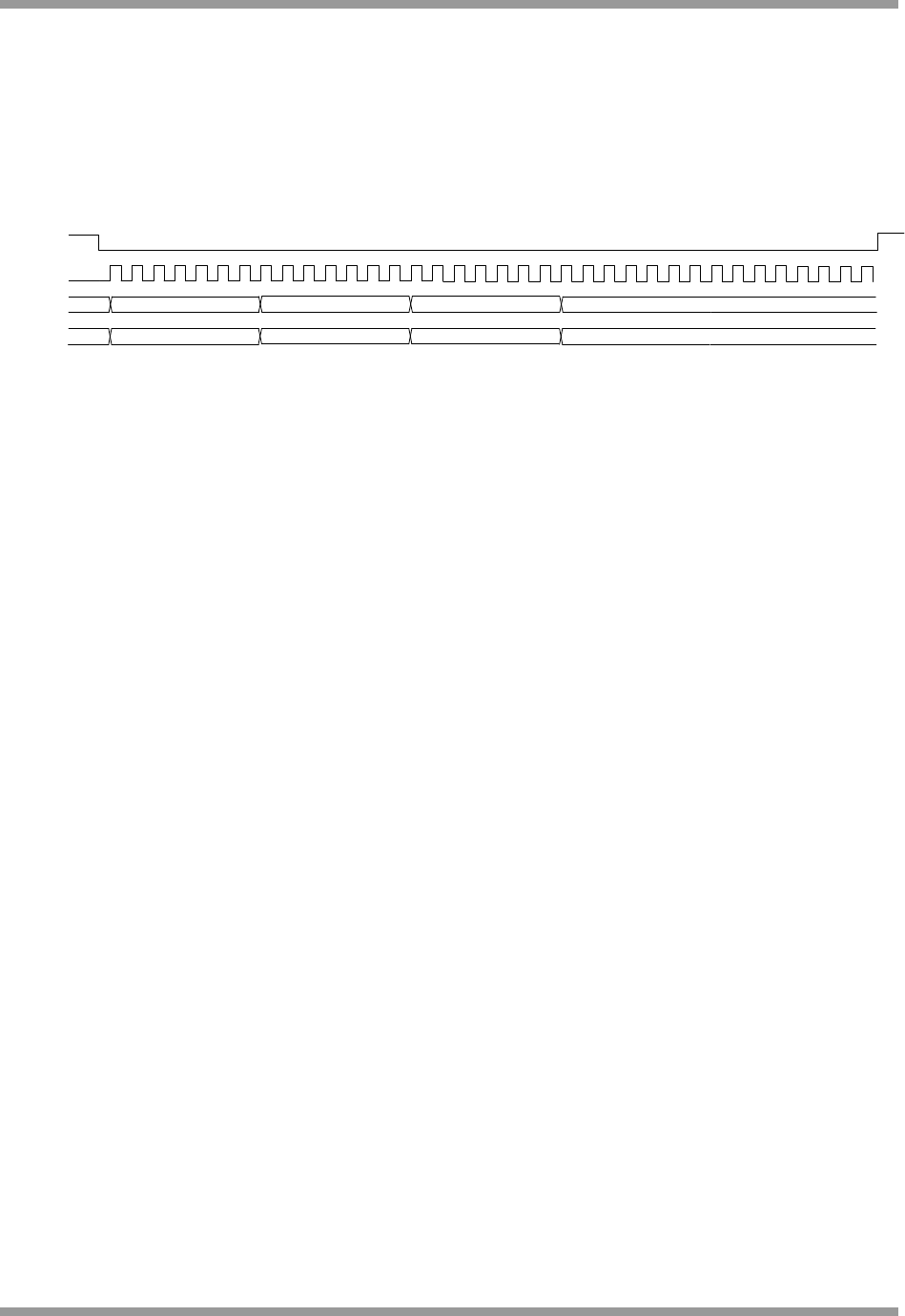
Jennic
JennicJennic
Jennic
34 JN-DS-JN5139 v1.5 © Jennic 2008
has no data to transfer, then the data length should be set to zero. The transaction can be terminated by the master
after the status byte has been sent if it is not possible to send data in either direction. This may be because neither
party has data to send or because the receiver does not have a buffer available. If the data length is non-zero, the
data in the JN5139 transmit memory buffer is sent, beginning at the start of the buffer. At the same time that data
bytes are being sent from the transmit buffer, the JN5139 receive buffer is being filled with incoming data, beginning
from the start of the buffer.
The remote processor, acting as the master, must determine the larger of its incoming or outgoing data transfers and
deassert IP_SEL when all of the transmit and receive data has been transferred. The data is transferred into or out of
the buffers starting from the lowest address in the buffer, and each word is assembled with the MSB first on the serial
data lines.
IP_SEL
IP_CLK
IP_DI Status (8 bit) N words of data
IP_DO
data length or 0s (8 bit)
Status (8 bit) N words of data
data length or 0s (8 bit)padding (8 bit)
padding (8 bit)
Figure 25: Intelligent Peripheral Data Transfer Waveforms
11.2 JN5139 Initiated Data Transfer
To send data, the data is written into either buffer 0 or 1 of the intelligent peripheral memory area. Then the buffer
number is written together with the data length. If the call is successful, the interrupt line IP_INT will signal to the
remote processor that there is a message ready to be sent from the JN5139. When a remote processor starts a
transfer to the JN5139 by deasserting IP_SEL, then IP_INT is deasserted. If the transfer is unsuccessful and the
data is not output then IP_INT is reasserted after the transfer to indicate that data is still waiting to be sent.
The interface can be configured to generate an internal interrupt whenever a transaction completes (for example
IP_SEL becomes inactive after a transfer starts). It is also possible to mask the interrupt. The end of the
transmission can be signalled by an interrupt, or the interface can be polled.
To receive data the interface must be firstly initialised and when this is done, the bit RXRDY sent in the status byte
from the IP block will show that data can be received by the JN5139. Successful data arrival can be indicated by an
interrupt, or the interface can be polled.
To send and receive at the same time, the transmit and receive buffers must be set to be different.
11.3 Remote Processor Initiated Data Transfer
The remote processor (master) may initiate a transfer to send data to the JN5139 by asserting the slave select pin,
IP_SEL, and generating its status byte on IP_DI with TXRDY set. After receiving the status byte from the JN5139, it
should check that the JN5139 has a buffer ready by reading the RXRDY bit. If the RXRDY bit is 0 indicating that the
JN5139 cannot accept data, it should terminate the transfer by deasserting IP_SEL unless it is receiving data from
the JN5139. If the RXRDY bit is 1, indicating that the JN5139 can accept data, then the master should generate a
further 8 clocks on IP_CLK in order to transfer its own message length on IP_DI. The master should continue
clocking the interface until sufficient clocks have been generated to send all the data specified in the length field to
the JN5139. The master should then deassert IP_SEL to show the transfer is complete.
The master may initiate a transfer to read data from the JN5139 by asserting the slave select pin, IP_SEL, and
generating its status byte on IP_DI with RXRDY set. After receiving the status byte from the JN5139, it should check
that the JN5139 has a buffer ready by reading the TXRDY bit. If the TXRDY bit is 0, indicating that the JN5139 does
not have data to send, it should terminate the transfer by deasserting IP_SEL unless it is transmitting data to the
JN5139. If the TXRDY bit is 1, indicating that the JN5139 can send data, then the master should generate a further 8
clocks on IP_CLK in order to receive the message length on IP_DO. The master should continue clocking the
interface until sufficient clocks have been generated to receive all the data specified in the length field from the
JN5139. The master should then deassert IP_SEL to show the transfer is complete.
Data can be sent in both directions at once and the master must ensure both transfers have completed before
deasserting IP_SEL.
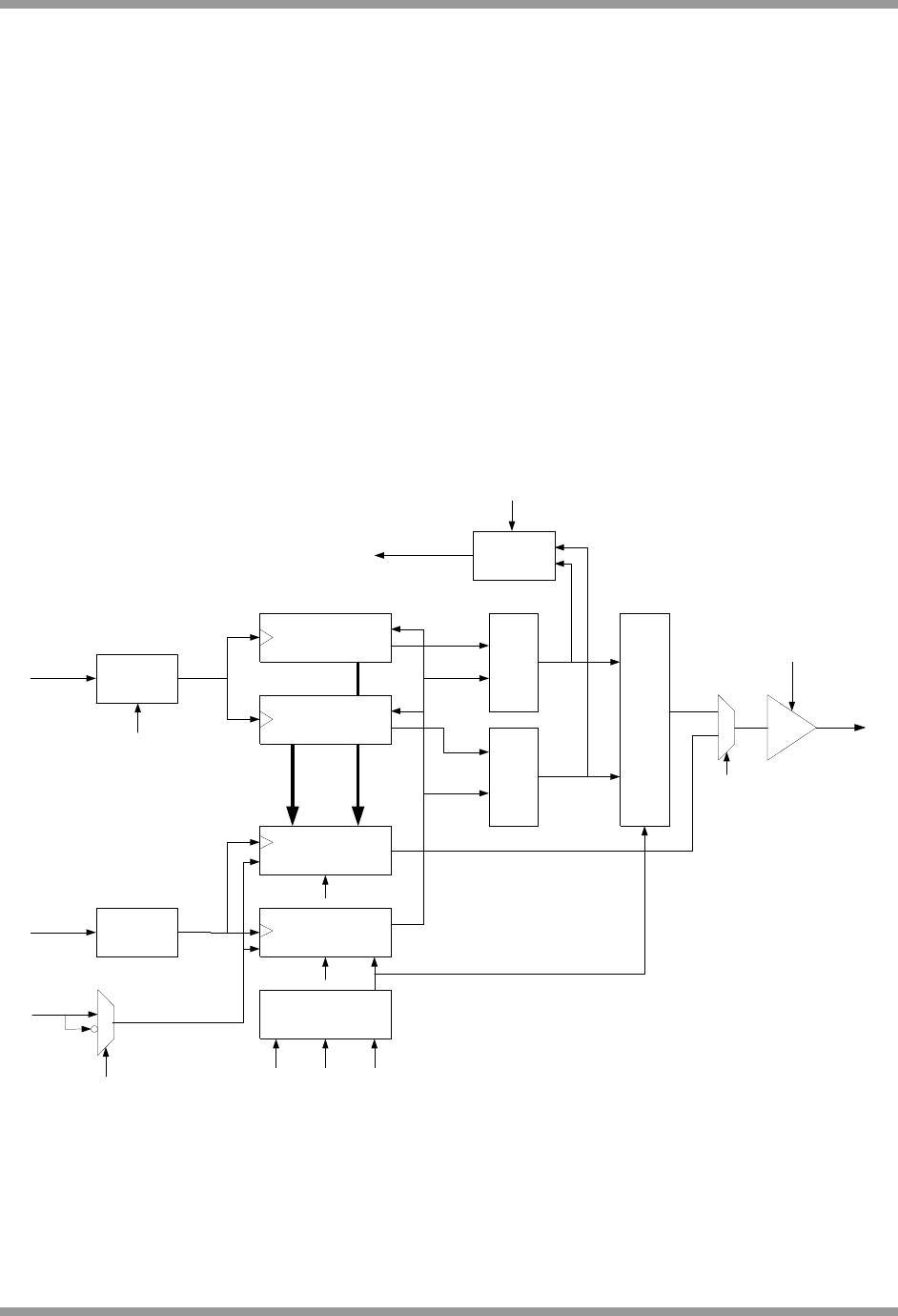
Jennic
JennicJennic
Jennic
© Jennic 2008 JN-DS-JN5139 v1.5 35
12 Timers
12.1 Peripheral Timer / Counters
Two general-purpose timer / counter units are available that can be independently configured to operate in one of five
modes. The timers have the following features:
•
16-bit prescaler, divides system clock by 2
prescale
value as the clock to the timer
•
Clocked from internal system clock
•
16-bit counter, 16-bit Rise and Fall (period) registers
•
Timer: can generate interrupts off Rise and Fall counts. Can be gated by external signal
•
Counter: counts number of transitions on external event signal. Can use low-high, high-low or both
transitions
•
PWM/Single pulse: outputs repeating Pulse Width Modulation signal or a single pulse. Can set period and
mark-space ratio
•
Capture: measures times between transitions of an applied signal.
•
Delta-Sigma: Return-To-Zero (RTZ) and Non-Return-to-Zero (NRZ) modes
Interrupt
Generator
Rise
Fall
Delta-Sigma
Counter
Reset Generator
=
Prescaler
INT
Int Enable
Sys Clk
S/w
Reset
System
Reset
Single
Shot
=
S
R
OE
Gate
Gate
Edge
Select
Reset
PWM/Delta-
Sigma
Capture
Generator
Capture
Enable
PWM/∆−Σ
PWM/∆−Σ
TIMxCK_GT
TIMxOUT
TIMxCAP
Figure 26: Timer Unit Block Diagram
The clock source for the timer unit is fed from the 16MHz system clock. This clock passes to a 16-bit prescaler where
a value of 0 leaves the clock unmodified and other values divide it by 2
prescale
value. For example, a prescale value
of 2 applied to the 16MHz system clock source results in a timer clock of 4MHz. The value of the prescaler is set
through software.
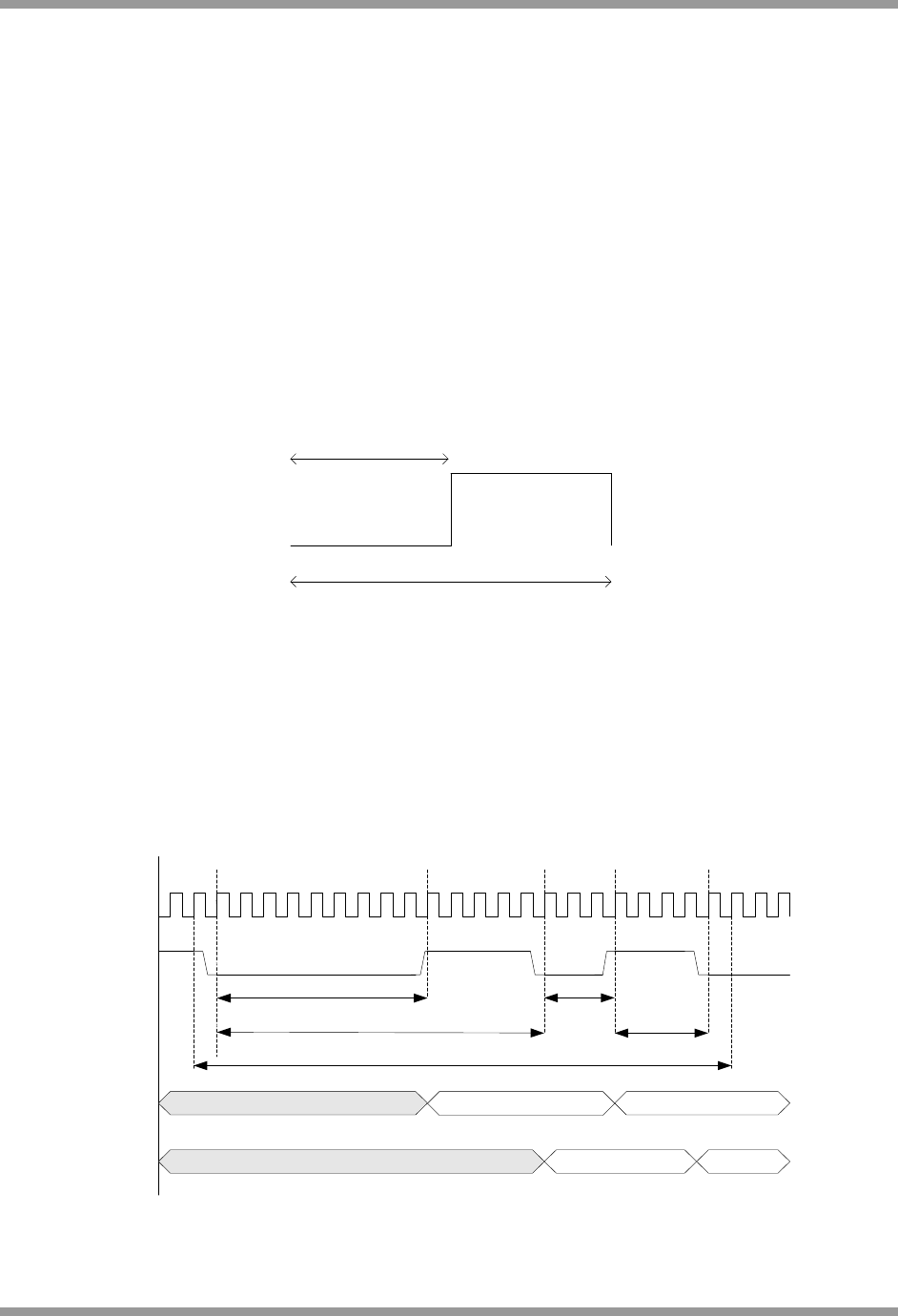
Jennic
JennicJennic
Jennic
36 JN-DS-JN5139 v1.5 © Jennic 2008
The counter is optionally gated by a signal on the clock / gate input (TIMxCK_GT). If the gate function is selected the
counter is frozen when the clock/gate input is high.
An interrupt can be generated when the counter is equal to the value in either of the High or Low registers.
The internal Output Enable (OE) signal enables or disables the timer output.
The Timer 0 signals CK_GT, CAP and OUT are alternate functions of pins DIO8, 9 and 10 respectively and Timer 1
signals CK_GT, CAP and OUT are alternate functions of pins DIO11, 12, and 13 respectively. Selection of either the
Timer or DIOx functionality is made through software, in either case the timer still functions internally.
12.1.1 Pulse Width Modulation Mode
Pulse Width Modulation (PWM) mode allows the user to specify an overall cycle time and pulse length within the
cycle. The pulse can be generated either as a single shot or as a train of pulses with a repetition rate determined by
the cycle time.
In this mode, the cycletime and low periods of the PWM output signal can be set by the values of two independent
16-bit registers (Fall and Rise). The counter increments and its output is compared to the 16-bit Rise and Fall
registers. When the counter is equal to the Rise register, the PWM output is set to high; when the counter reaches
the Fall value, the output returns to low. In continuous mode, when the counter reaches the Fall value, it will reset
and the cycle repeats. The PWM waveform is available on TIMxOUT when the output driver is enabled.
Rise
Fall
Figure 27: PWM Output Timings
12.1.2 Capture Mode
The capture mode can be used to measure the time between transitions of a signal applied to the capture input
(TIMxCAP). When the capture is started, on the next low-to-high transition of the captured signal, the count value is
stored in the Rise register, and on the following high-to-low transition, the counter value is stored in the Fall register.
The pulse width is the difference in counts in the two registers multiplied by the driving clock (in all cases this must be
the 16MHz clock and so the prescaler must be set to 0). Upon reading the capture registers the counter is stopped.
The values in the High and Low registers will be updated whenever there is a corresponding transition on the capture
input, and the value stored will be relative to when the mode was started. Therefore, if multiple pulses are seen on
TIMxCAP before the counter is stopped only the last pulse width will be stored.
CLK
CAPT
x93
x 14
t
RISE
t
RISE
t
FALL
t
FALL
Rise
Fall
95 43
7
Capture Mode Enabled
Figure 28: Capture Mode
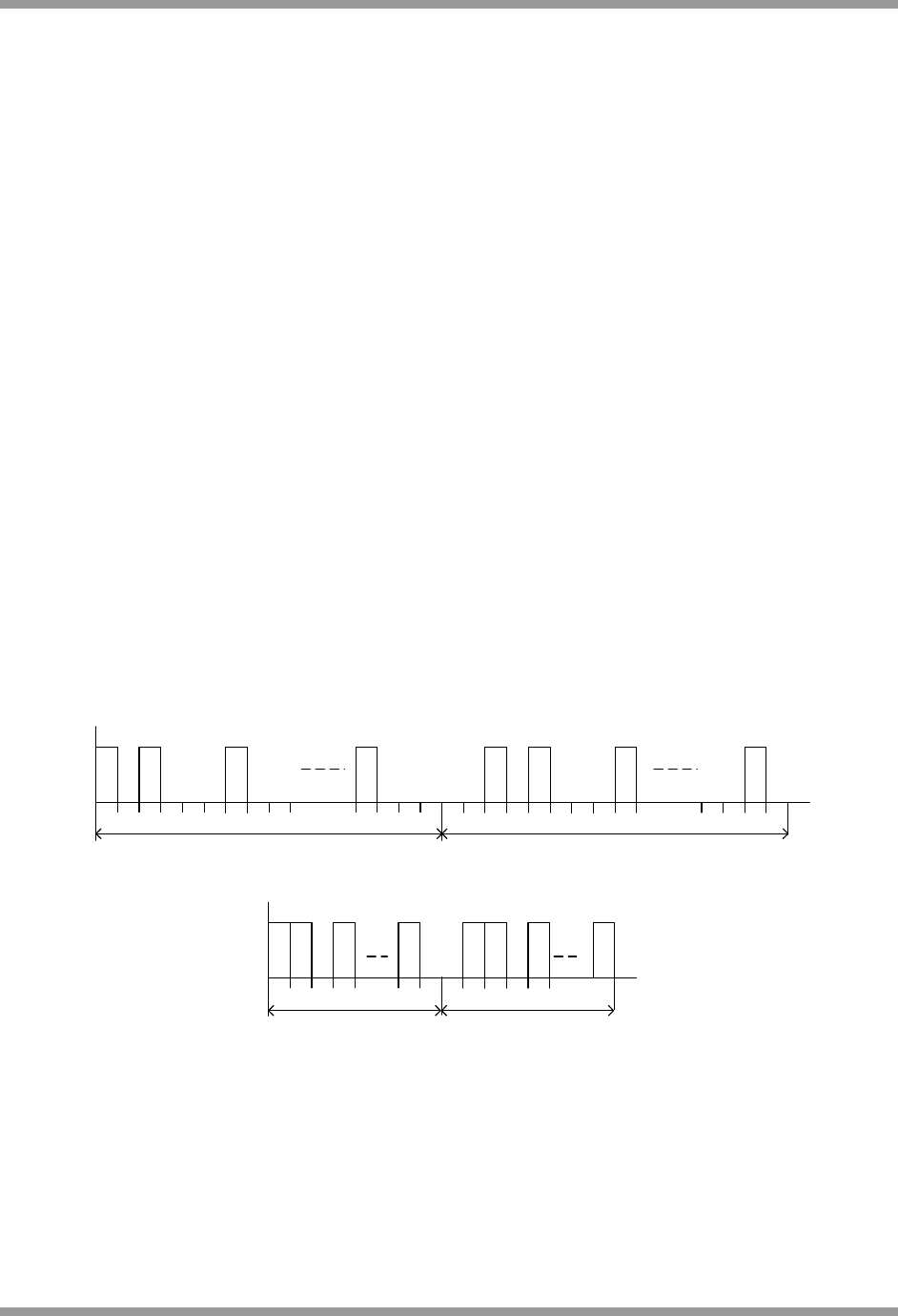
Jennic
JennicJennic
Jennic
© Jennic 2008 JN-DS-JN5139 v1.5 37
12.1.3 Counter / Timer Mode
The counter/timer can be used to generate timing or count interrupts for software to use. As a timer the clock source
is from the system clock, prescaled if required. The timer period is programmed into the Fall register and the Fall
register match interrupt enabled. The timer is started as either a single-shot or a repeating timer, and generates an
interrupt when the counter reaches the Fall register value.
When used to count external events on TIMxCK_GT the clock source is selected from the input pin and the number
of events programmed into the Fall register. The Fall register match interrupt is enabled and the counter started,
usually in single shot mode. An interrupt is generated when the programmed number of low-to-high transitions is
seen on the input pin.
12.1.4 Delta-Sigma Mode
A separate delta-sigma mode is available, allowing a low speed delta-sigma DAC to be implemented with up to 16-bit
resolution. This requires that a resistor-capacitor network is placed between the output DIO pin and digital ground. A
stream of pulses with digital voltage levels is generated which is integrated by the RC network to give an analogue
voltage. A conversion time is defined in terms of a number of clock cycles. The width of the pulses generated is the
period of a clock cycle. The number of pulses output in the cycle, together with the integrator RC values will
determine the resulting analogue voltage. For example, generating approximately half the number of pulses that
make up a complete conversion period will produce a voltage on the RC output of VDD1/2, provided the RC time
constant is chosen correctly. During a conversion, the pulses will be pseudo-randomly dispersed throughout the
cycle in order to produce a steady voltage on the output of the RC network.
The output signal is asserted for the number of clock periods defined in the High register, with the total period being
2
16
cycles. For the same value in the High register the pattern of pulses on subsequent cycles is different, due to the
pseudo-random distribution.
The delta-sigma convertor output can operate in a Return-To-Zero (RTZ) or a Non-Return-to-Zero (NRZ) mode. The
NRZ mode will allow several pulses to be output next to each other. The RTZ mode ensures that each pulse is
separated from the next by at least one period. This improves linearity if the rise and fall times of the output are
different to one another. Essentially, the output signal is low on every other output clock period, and the conversion
cycle time is twice the NRZ cycle time ie 2
17
clocks. The integrated output will only reach half VDD2 in RTZ mode,
since even at full scale only half the cycle contains pulses. Figure 29 and Figure 30 illustrate the difference between
RTZ and NRZ for the same programmed number of pulses.
1 2 3 1 2 N
Conversion cycle 1
217
N
Conversion cycle 2
3
Figure 29: Return To Zero Mode in Operation
1 2 3 1 2 N
Conversion cycle 1
N 3
216 Conversion cycle 2
Figure 30: Non-Return to Zero Mode
12.1.5 Timer / Counter Application
Figure 31 shows an application of the JN5139 timers to provide closed loop speed control. Timer 0 is configured in
PWM mode to provide a variable mark-space ratio switching waveform to the gate of the NFET. This in turn controls
the power in the DC motor.
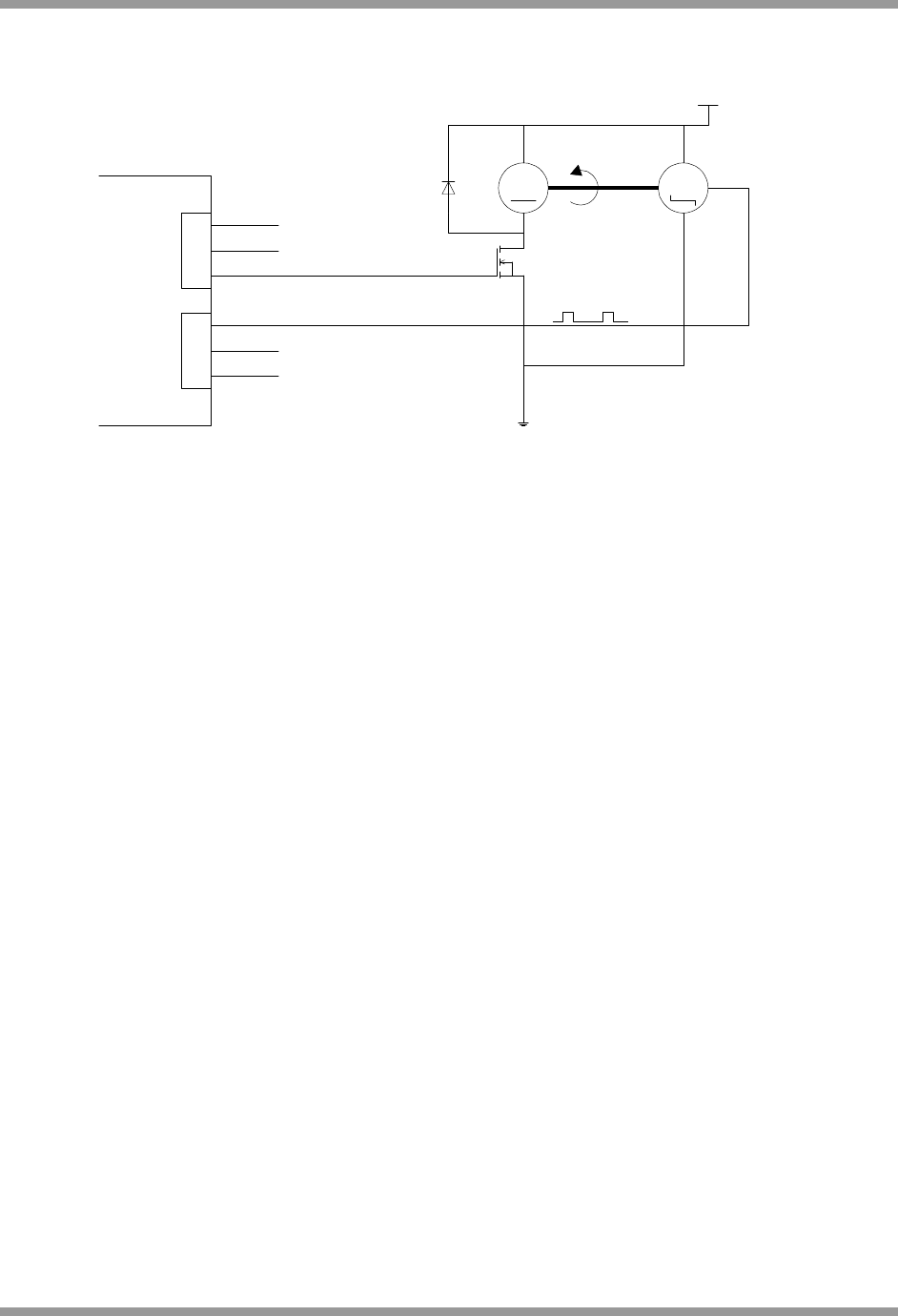
Jennic
JennicJennic
Jennic
38 JN-DS-JN5139 v1.5 © Jennic 2008
Timer 1 is configured to count the rising edge events on the clk/gate pin over a constant period. This converts the
tacho pulse stream output into a count proportional to the motor speed. This value is then used by the application
software executing the control algorithm.
JN5139
Timer 0
Timer 1
CLK/GATE
CLK/GATE
CAPTURE
CAPTURE
PWM
PWM
M
Tacho
48
50
52
53
54
1N4007
+12V
IRF521
51
1 pulse/rev
Figure 31: Closed Loop PWM Speed Control Using JN5139 Timers
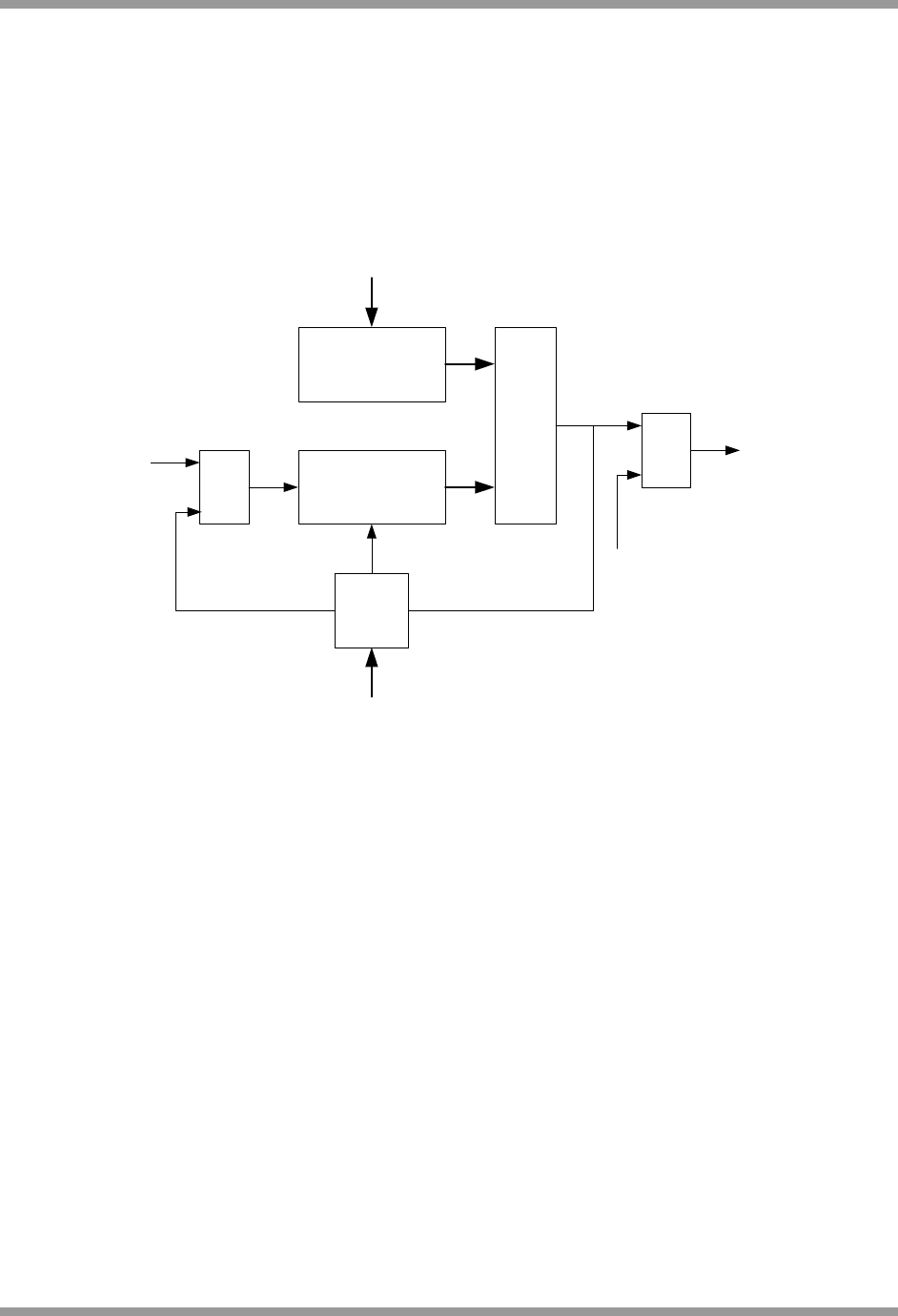
Jennic
JennicJennic
Jennic
© Jennic 2008 JN-DS-JN5139 v1.5 39
12.2 Tick Timer
The JN5139 contains a hardware timer that can be used for generating timing interrupts to software. It may be used
to implement regular events such as ticks for software timers or an operating system, as a high-precision timing
reference or can be used to implement system monitor timeouts as used in a watchdog timer. Features include:
•
32-bit counter
•
28-bit match value
•
Maskable timer interrupt
•
Single-shot, Restartable or Continuous modes of operation
Match Value
Counter
=
Mode
Control
&
&
SysClk
Run
Match
Int
Enable
Tick Timer
Interrupt
Reset
Mode
Figure 32: Tick Timer
The Tick Timer is clocked from the 16MHz CPU clock, which is fed to a 32-bit wide resettable up-counter, gated by a
signal from the mode control block. A match register allows comparison between the counter and a programmed
value. The match value, measured in 16MHz clock cycles is programmed through software, in the range 0 to
0x0FFFFFFF. The output of the comparison can be used to generate an interrupt if the interrupt is enabled and used
in controlling the counter in the different modes. Upon configuring the timer mode, the counter is also reset.
If the mode is programmed as single shot, the counter begins to count from zero until the match value is reached.
The match signal will be generated which will cause an interrupt if enabled, and the counter will stop counting. The
counter is restarted by reprogramming the mode.
If the mode is programmed as restartable, the operation of the counter is the same as for the single shot mode,
except that when the match value is reached the counter is reset and begins counting from zero. An interrupt will be
generated when the match value is reached if it is enabled.
Continuous mode operation is similar to restartable, except that when the match value is reached, the counter is not
reset but continues to count. An interrupt will be generated when the match value is reached if enabled.
In CPU doze mode the tick timer is not clocked and therefore cannot be used as a wakeup source.
12.3 Wakeup Timers
Two 32-bit wakeup timers driven from the 32kHz internal clock are available in the JN5139. They may run during
sleep periods when the majority of the rest of the device is powered down, to time sleep periods or other long period
timings that may be required by the application. The wakeup timers do not run during deep sleep and may optionally
be disabled in sleep mode through software control. When a wakeup timer expires it typically generates an interrupt,

Jennic
JennicJennic
Jennic
40 JN-DS-JN5139 v1.5 © Jennic 2008
if the device is asleep then the interrupt may be used as an event to end the sleep period. See Section 16 for further
details on how they are used during sleep periods. Features include:
•
32-bit down-counter
•
Optionally runs during sleep periods
•
Clocked from 32 kHz RC oscillator
A wakeup timer consists of a 32-bit down counter clocked from the 32 kHz internal clock. An interrupt or wakeup
event can be generated when the counter reaches zero. On reaching zero the counter will continue to count down
until stopped, which allows the latency in responding to the interrupt to be measured. If an interrupt or wakeup event
is required, the timer interrupt should be enabled before loading the count value for the period. Once the count value
is loaded and counter started, the counter begins to count down; the counter can be stopped at any time through
software control. The counter will remain at the value it contained when the timer was stopped and no interrupt will
be generated. The status of the timers can be read to indicate if the timers are running and/or have expired; this is
useful when the timer interrupts are masked. If a timer has expired then the expired status will be reset by the
function.
12.3.1 RC Oscillator Calibration
The RC oscillator used to time sleep periods is designed to require very little power to operate and be self-contained,
requiring no external timing components and hence is lower cost. As a consequence of using on-chip resistors and
capacitors, the inherent absolute accuracy and temperature coefficient is lower than that of a crystal oscillator, but
once calibrated the accuracy approaches that of a crystal oscillator. Sleep time periods should be as close to the
desired time as possible in order to allow the device to wake up in time for important events, for example beacon
transmissions in the IEEE802.15.4 protocol. If the sleep time is accurate, the device can be programmed to wake up
very close to the calculated time of the event and so keep current consumption to a minimum. If the sleep time
is less accurate, it will be necessary to wake up earlier in order to be certain the event will be captured. If the device
wakes earlier, it will be awake for longer and so reduce battery life.
In order to allow sleep time periods to be as close to the desired length as possible, the true frequency of the RC
oscillator needs to be determined to better than the initial 30% accuracy. The calibration factor can then be used to
calculate the true number of nominal 32kHz periods needed to make up a particular sleep time. A calibration
reference timer, clocked from the crystal oscillator, is provided to allow comparisons to be made between the RC
clock and the 16MHz crystal oscillator when the JN5139 is awake. Operation is as follows:
•
Wakeup timer0 is disabled and programmed with a number of 32kHz ticks
•
Timer0 event status must be cleared
•
Calibration mode is enabled which causes the Calibration Reference counter to be zeroed. Both counters
start counting, the wakeup timer decrementing and the calibration counter incrementing
•
When the wakeup timer reaches zero the Reference Counter is stopped, allowing software to read the
number of 16MHz clock ticks generated during the time represented by the number of 32kHz ticks
programmed in the wakeup timer. The true period of the 32kHz clock can thus be determined and used
when programming a wakeup timer to achieve a better accuracy and hence more accurate sleep periods
For a RC oscillator running at exactly 32kHz the value returned by the calibration procedure should be 10000, for a
calibration period of twenty 32kHz clock periods. If the oscillator is running faster than 32kHz the count will be less
than 10000, if running slower the value will be higher. For a calibration count of 9000, indicating that the RC oscillator
period is running at approximately 35kHz, to time for a period of 2 seconds the timer should be loaded with 71,111
((10000/9000) x (32000 x 2)) rather than 64000.
12.3.2 External 32kHz Clock Source
It is possible to change the source of the 32kHz clock used for the sleep timers to an externally supplied 32kHz
reference clock on the CLK32K input (DIO9). This mode could allow the timer clock to be sourced from a very stable
oscillator module, allowing more accurate sleep cycle timings. (See section 17.2.3 I/O Characteristics, DIO9 is a 3V
tolerant input)
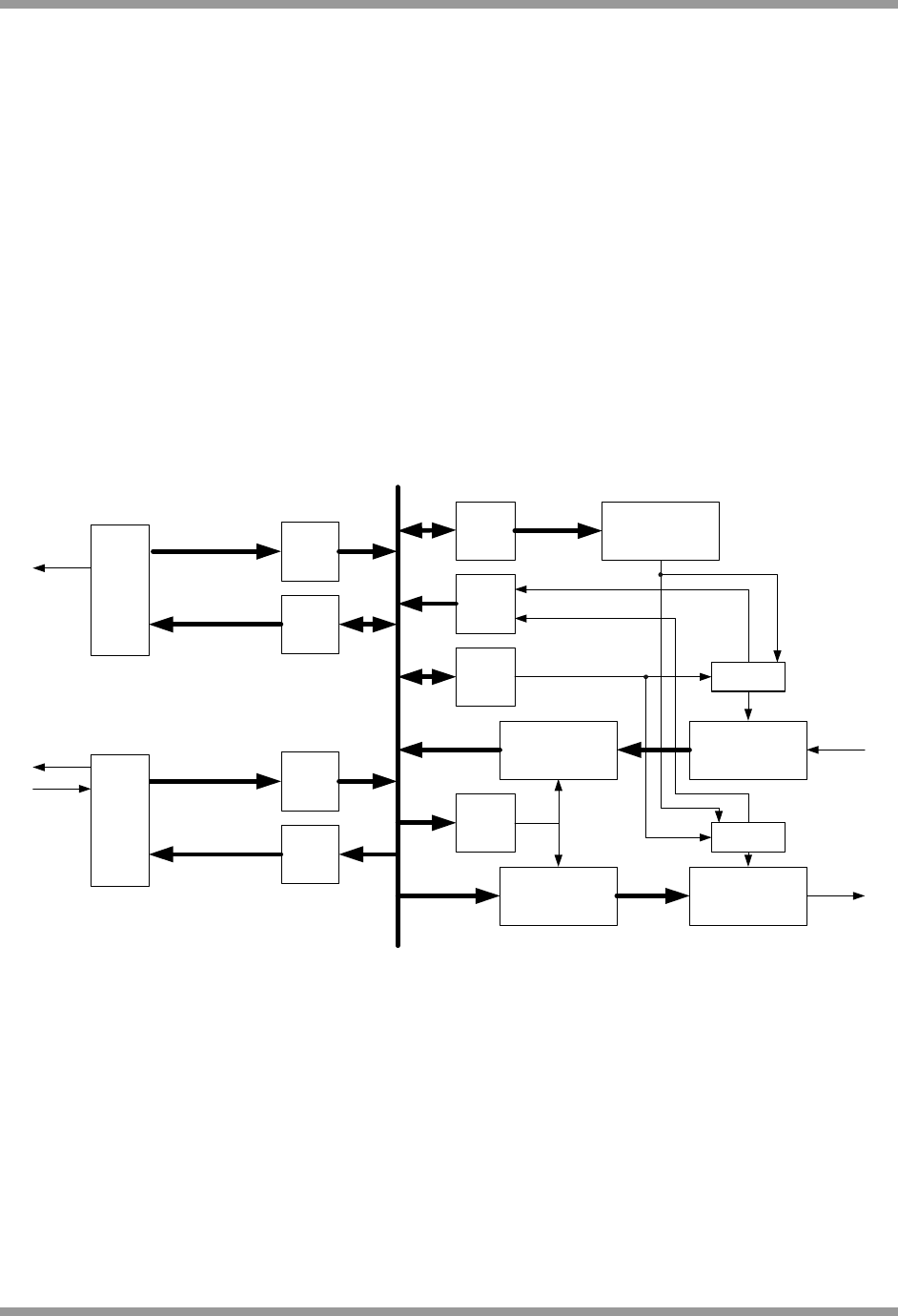
Jennic
JennicJennic
Jennic
© Jennic 2008 JN-DS-JN5139 v1.5 41
13 Serial Communications
The JN5139 has two independent Universal Asynchronous Receiver / Transmitter (UART) serial communication
interfaces. These provide similar operating features to the industry standard 16550A device operating in FIFO mode.
Each interface performs serial-to-parallel conversion on incoming serial data and parallel-to-serial conversion on
outgoing data from the CPU to external devices. In both directions, a 16-byte deep FIFO buffer allows the CPU to
read and write multiple characters on each transaction. This means that the CPU is freed from handling data on a
character-by-character basis, with the associated high processor overhead. The UARTs have the following features:
•
Emulates behaviour of industry standard NS16450 and NS16550A UARTs
•
16 byte transmit and receive FIFO buffers reduce interrupts to CPU, with direct access to fill levels of each
•
Adds / deletes standard start, stop and parity communication bits to or from the serial data
•
Independently controlled transmit, receive, status and data sent interrupts
•
Optional modem flow control signals CTS and RTS
•
Fully programmable data formats: baud rate, start, stop and parity settings
•
False start bit detection, parity, framing and FIFO overrun error detect and break indication
•
Internal diagnostic capabilities: loop-back controls for communications link fault isolation
•
Flow control by software or automatically by hardware
Processor Bus
Divisor
Latch
Register
s
Line
Status
Register
Line
Control
Register
FIFO
Control
Register
Receiver FIFO
Transmitter FIFO
Baud Generator
Logic
Transmitter Shift
Register
Receiver Shift
Register
Transmitter
Logic
Receiver
Logic
RXD
TXD
Modem
Control
Register
Modem
Status
Register
Modem
Signals
Logic
RTS
CTS
Interrupt
ID
Register
Interrupt
Enable
Register
Interrupt
Logic
Internal
Interrupt
Figure 33 UART Block Diagram
The serial interface contains programmable fields that can be used to set number of data bits (5, 6,7 or 8), even, odd,
set-at-1, set-at-0 or no-parity detection and generation of single or multiple stop bit, (for 5 bit data, multiple is 1.5 stop
bits; for 6, 7 or 8 data bits, multiple is 2 bits).
The baud rate is programmable up to 1Mbps, standard baud rates such as 4800, 9600, 19.2k, 38.4k etc. can be
configured.
Two hardware flow control signals are provided: Clear-To-Send (CTS) and Request-To-Send (RTS). CTS is an
indication sent by an external device to the UART that it is ready to receive data. RTS is an indication sent by the
UART to the external device that it is ready to receive data. RTS is controlled from software, while the value of CTS
can be read. Monitoring and control of CTS and RTS is a software activity, normally performed as part of interrupt
processing. The signals do not control parts of the UART hardware, but simply indicate to software the state of the
UART external interface. Alternatively, the Automatic Flow Control mode can be set where the hardware controls the
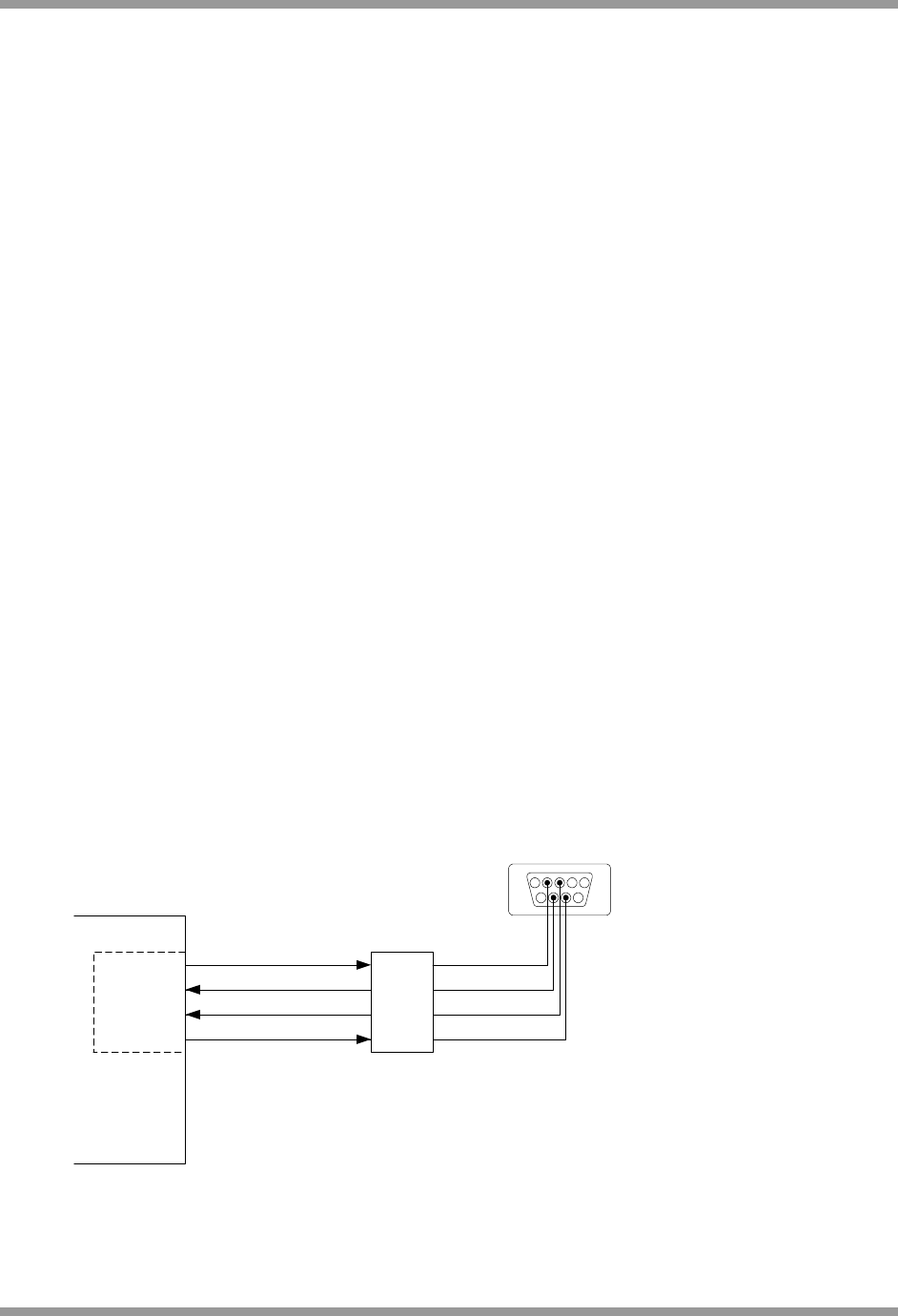
Jennic
JennicJennic
Jennic
42 JN-DS-JN5139 v1.5 © Jennic 2008
value of the generated RTS (negated if the receive FIFO fill level is 15 and another character starts to be received,
and asserted when the receive FIFO is read), and only transmits data when the incoming CTS is asserted.
Characters are read one byte at a time from the Receive FIFO and are written to the Transmit FIFO. The Transmit
and Receive FIFOs can be cleared and reset independently of each other. The status of the transmitter can be
checked to see if it is empty, and if there is a character being transmitted. The status of the receiver can also be
checked, indicating if conditions such as parity error, framing error or break indication have occurred. It also shows if
an overrun error occurred (receive buffer full and another character arrives) and if there is data held in the receive
FIFO.
UART 0 signals CTS, RTS, TXD and RXD are alternate functions of pins DIO4, 5, 6 and 7 respectively and UART 1
signals CTS, RTS, TXD and RXD are alternate functions of pins DIO17, 18, 19 and 20 respectively. If CTS and RTS
are not required on the devices external pins, then they may be disabled, this allows the alternate DIOx to be used
instead.
Note: The hardware flow control within the UART block negates RTS when the receive FIFO is about to become full,
this occurs when the UART has started receiving the last byte that it can accept. In some instances it has been
observed that remote devices that are transmitting data do not respond quickly enough to the de-asserted CTS and
continue to transmit data. In these instances the data will be lost in a receive FIFO overflow.
13.1 Interrupts
Interrupt generation can be controlled for the UART block, and is divided into four categories:
•
Received Data Available: Is set when data in the Rx FIFO queue reaches a particular level (the trigger level can
be configured as 1, 4, 8 or 14) or if no character has been received for 4 character times.
•
Transmit FIFO Empty: set when the last character from the Tx FIFO is read and starts to be transmitted.
•
Receiver Line Status: set when one of the following occur (1) Parity Error - the character at the head of the
receive FIFO has been received with a parity error, (2) Overrun Error - the Rx FIFO is full and another character
has been received at the Receiver shift register, (3) Framing Error - the character at the head of the receive
FIFO does not have a valid stop bit and (4) Break Interrupt – occurs when the RxD line has been held low for an
entire character.
•
Modem Status: Generated when the CTS (Clear To Send) input control line changes.
13.2 UART Application
The following example shows the UART connected to a 9-pin connector compatible with a PC. The software
developer kit uses such an interface as the debugger interface between the JN5139 and a PC. As the JN5139
device pins do not provide the RS232 line voltage a level shifter is used.
JN5139
RTS
CTS
TXD
RXD
UART0
RS232
Level
Shifter
1
2
3
4
5
6
7
8
9
CD
RD
TD
DTR
SG
DSR
RTS
CTS
RI
PC COM Port
Pin Signal
1 5
6 9
46
47
45
44
Figure 34 JN5139 Serial Communication Link
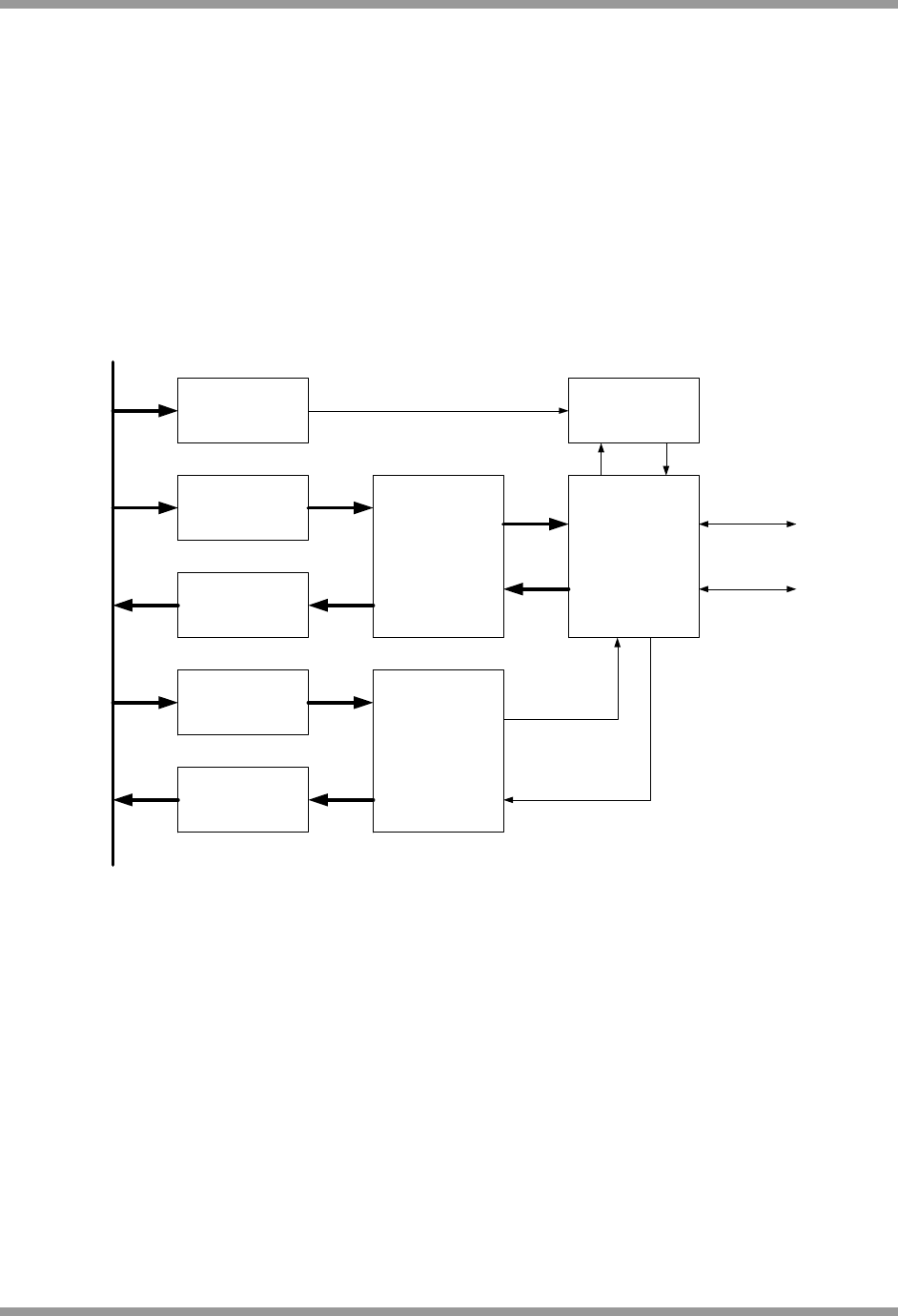
Jennic
JennicJennic
Jennic
© Jennic 2008 JN-DS-JN5139 v1.5 43
14 Two-Wire Serial interface
The JN5139 includes an industry standard two-wire synchronous serial interface (SIF) that provides a simple and
efficient method of data exchange between devices. The system uses a serial data line (SIF_D) and a serial clock
line (SIF_CLK) to perform bi-directional data transfers and includes the following features:
•
Compatible with both I
2
C and SMbus peripherals (master only mode)
•
Software programmable clock frequency
•
Clock stretching and wait state generation
•
Software programmable acknowledge bit
•
Interrupt or bit-polling driven byte-by-byte data-transfers
•
Bus busy detection
•
Support for 7 and 10 bit addressing modes
Prescale
Register
Receive
Register
Command
Register
Status
Register
Transmit
Register
Byte
Command
Controller
Data I/O
Shift
Register
Bit
Command
Controller
Clock
Generator
SIF_CLK
SIF_D
Processor Bus
Figure 35: SIF Block Diagram
The prescale register allows the interface to be configured to operate at up to 400kbit/s. The clock generator handles
the clock stretching required by some slave devices.
The Byte Command Controller handles traffic at the byte level. It takes data from the Command Register and
translates it into sequences based on the transmission of a single byte. By setting the start, stop, read, write and
acknowledge control bits in the command register it is possible to generate read or write sequences on the bus.
The data I/O shift register contains the data associated with the current transfer. During a read operation, data is
shifted into this register from the SIF_D line. When the read is complete the byte is copied into the receive register
and can be accessed.
During a write operation the contents of the transmit register are copied into the shift register and then onto the SIF_D
line. It is possible to generate an interrupt upon the completion of a byte transmission or reception. If interrupt-driven
communication is not desired it is possible to poll the status of the interface.
The first byte of data transferred by the device after a start bit is the slave address. The JN5139 supports both 7-bit
and 10-bit slave addresses by generating either one or two address transfers. Only the slave with a matching
address will respond by returning an acknowledge bit.
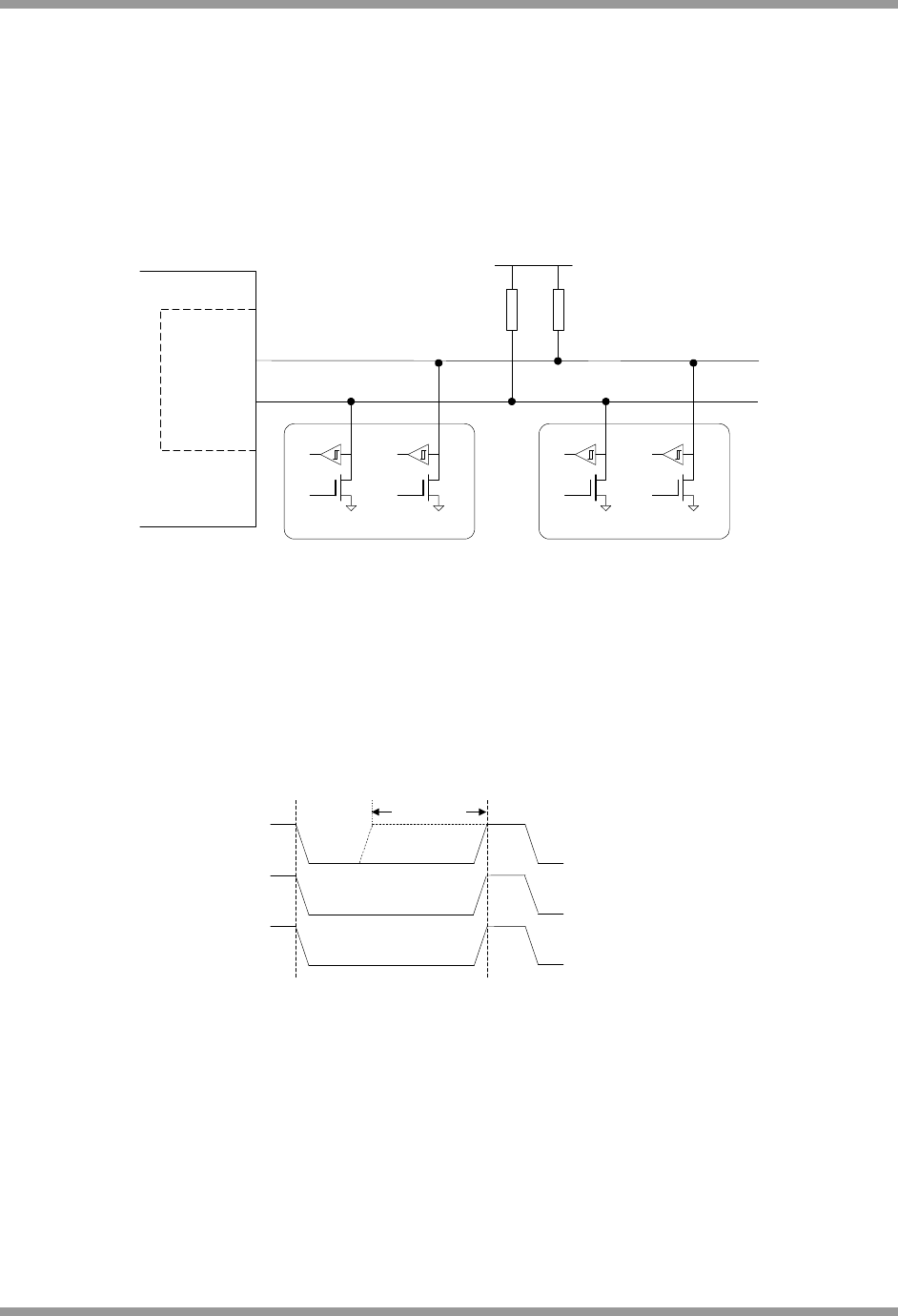
Jennic
JennicJennic
Jennic
44 JN-DS-JN5139 v1.5 © Jennic 2008
14.1 Connecting Devices
The clock and data lines, SIF_D and SIF_CLK, are alternate functions of DIO lines 15 and 14 respectively. The serial
interface function of these pins is selected when the interface is enabled. They are both bi-directional lines,
connected internally to the positive supply voltage via weak (45k
Ω
) programmable pull-up resistors. However, it is
recommended that external 4.7k
Ω
pull-ups be used for reliable operation at high bus speeds, as shown in Figure 36.
When the bus is free, both lines are HIGH. The output stages of devices connected to the bus must have an open-
drain or open-collector in order to perform the wired-AND function. The number of devices connected to the bus is
solely dependent on the bus capacitance limit of 400pF.
SIF_CLK
SIF_D
Vdd
D1_OUT
D1_IN CLK1_IN
CLK1_OUT
D2_IN CLK2_IN
CLK2_OUT
DEVICE 1 DEVICE 2
R
P
R
P
Pullup
Resistors
D2_OUT
JN5139
SIF
55
56
Figure 36: Connection Details
14.2 Clock Stretching
Slave devices can use clock stretching to slow down the transfer bit rate. After the master has driven SIF_CLK low,
the slave can drive SIF_CLK low for the required period and then release it. If the slave’s SIF_CLK low period is
greater than the master’s low period the resulting SIF_CLK bus signal low period is stretched thus inserting wait
states.
SIF_CLK
SIF_CLK
SIF_CLK
Master SIF_CLK
Slave SIF_CLK
Wired-AND SIF_CLK
Clock held low
by Slave
Figure 38: Clock Stretching
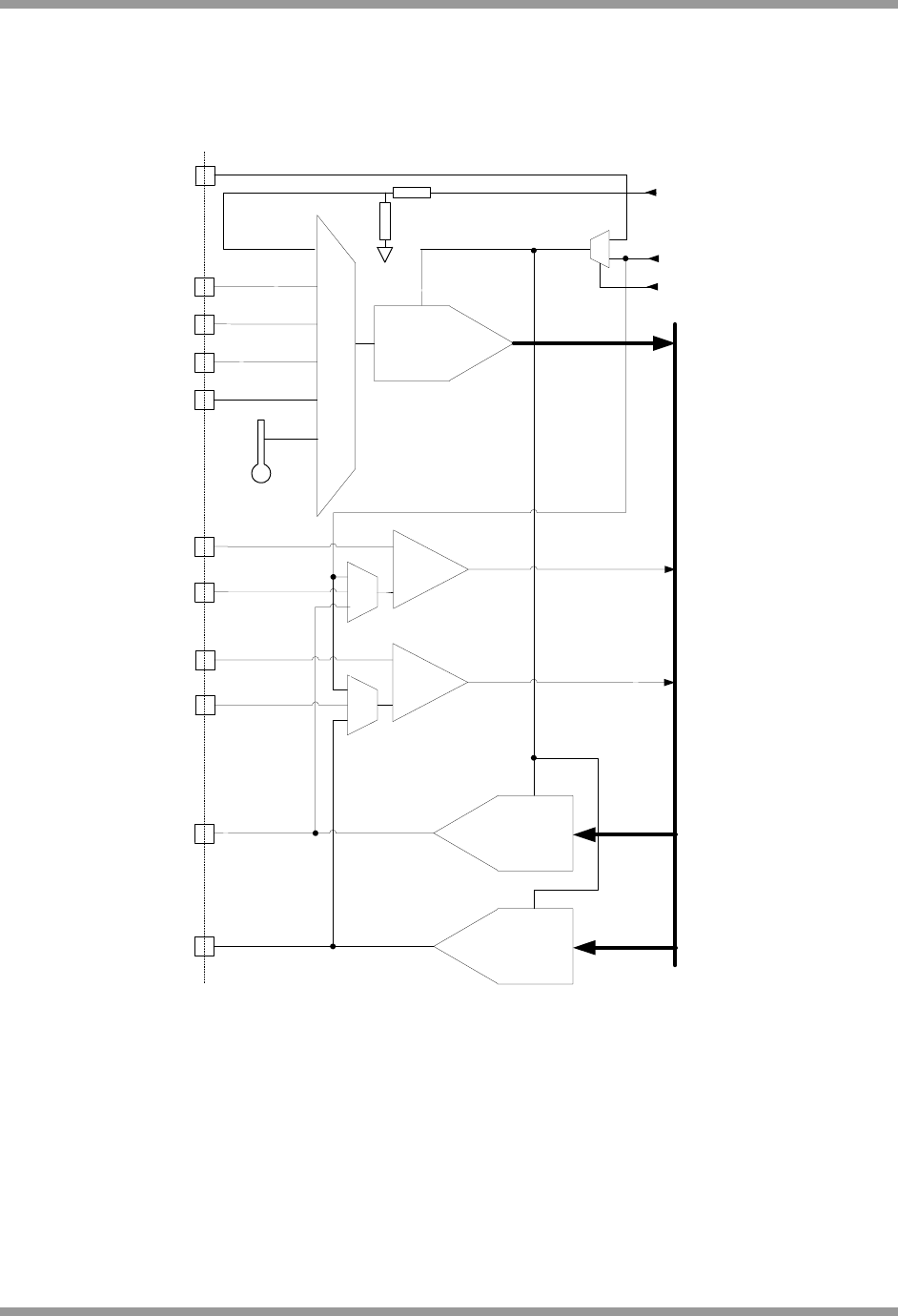
Jennic
JennicJennic
Jennic
© Jennic 2008 JN-DS-JN5139 v1.5 45
15 Analogue Peripherals
The JN5139 contains a number of analogue peripherals allowing the direct connection of a wide range of external
sensors, switches and actuators.
ADC
DAC1
DAC2
VREF
Chip
Boundary
Internal Reference
Processor Bus
Supply Voltage
(VDD1)
Vref select
Temp
Sensor
Comparator 2
Comparator 1
COMP2M
COMP1M
COMP1P
COMP2P
DAC1
DAC2
ADC1
ADC2
ADC3
ADC4
Vref
Figure 39: On-chip Analogue Peripherals
In order to provide good isolation from digital noise, the analogue peripherals are powered by a separate regulator,
supplied from the analogue supply VDD1 and referenced to analogue ground VSSA.
The ADC and DAC reference Vref can be selected between an internal bandgap reference or an external voltage
reference supplied to the VREF pin.
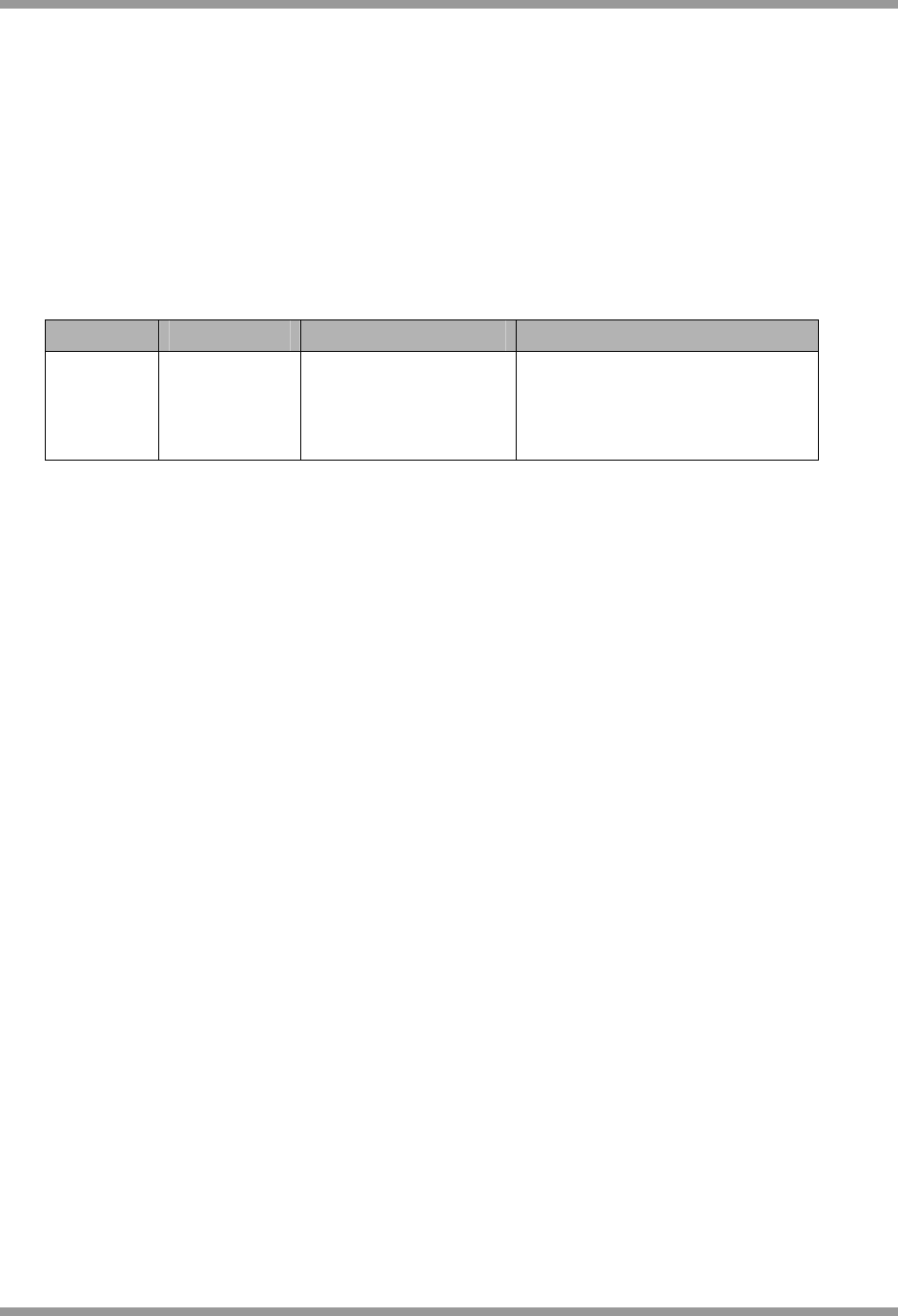
Jennic
JennicJennic
Jennic
46 JN-DS-JN5139 v1.5 © Jennic 2008
15.1 Analogue to Digital Converter
The 12-bit analogue to digital converter (ADC) uses a successive approximation design to perform high accuracy
conversions as typically required in wireless sensor network applications. It has six multiplexed single-ended input
channels: four available externally, one connected to an internal temperature sensor, and one connected to an
internal supply monitoring circuit.
15.1.1 Operation
The input range of the ADC can be set between 0V to either the reference voltage or twice the reference voltage.
The reference can be either taken from the internal voltage reference or from the external voltage applied to the
VREF pin. For example, an external reference of 1.2V supplied to VREF may be used to set the ADC range between
0V and 2.4V.
VREF Gain Setting Maximum Input Range Supply Voltage Range (VDD)
1.2V
1.6V
1.2V
1.6V
0
0
1
1
1.2V
1.6V
2.4V
3.2V
2.2V - 3.6V
2.2V - 3.6V
2.6V - 3.6V
3.4V - 3.6V
Table 5 ADC Reference and Gain Settings
The input clock to the ADC is 16MHz and is divided down to 500kHz. During an ADC conversion the selected input
channel is sampled for a fixed period and then held. This sampling period is defined as a number of ADC clock
periods and can be programmed to 2, 4, 6 or 8. The conversion rate is ((3 x Sample period) + 14) clock periods. For
example for 500KHz conversion with sample period of 2 will be (3 x 2) + 14 = 20 clock periods, 40usecs or 25KHz.
If the source resistance of the input voltage is 1kΩ or less, then the default sampling time of 2 clocks should be used.
The input to the ADC can be modelled as a resistor of 5kΩ to represent the on-resistance of the switches and the
sampling capacitor 8pF. The sampling time required can then be calculated, by adding the sensor source resistance
to the switch resistance, multiplying by the capacitance giving a time constant. Assuming normal exponential RC
charging, the number of time constants required to give an acceptable error can be calculated, 7 time constants gives
an error of 0.1%, so for 12-bit accuracy 10 time constants should be the target. For a source with zero resistance, 10
time constants is 800 nsecs, hence the smallest sampling window of 2 clock periods can be used.
The ADC sampling period, input range and mode (single shot or continuous) are controlled through software.
When the ADC conversion is complete, an interrupt is generated. Alternatively the conversion status can be polled.
When operating in continuous mode, it is recommended that the interrupt is used to signal the end of a conversion,
since conversion times may range from 36 to 60
µ
secs. Polling over this period would be wasteful of processor
bandwidth.
For detailed electrical specifications, see section 17.3.8.
15.1.2 Supply Monitor
The internal supply monitor allows the voltage on the analogue supply pin VDD1 to be measured. This is achieved
with a potential divider that reduces the voltage by a factor of 0.666, allowing it to fall inside the input range of the
ADC when set with an input range twice the internal voltage reference. The resistor chain that performs the voltage
reduction is disabled until the measurement is made to avoid a continuous drain on the supply.
15.1.3 Temperature Sensor
The on-chip temperature sensor can be used either to provide an absolute measure of the device temperature or to
detect changes in the ambient temperature. In common with most on-chip temperature sensors, it is not trimmed and
so the absolute accuracy variation is large; the user may wish to calibrate the sensor prior to use. The sensor forces
a constant current through a forward biased diode to provide a voltage output proportional to the chip die temperature
which can then be measured using the ADC. The measured voltage has a linear relationship to temperature as
described in section 17.3.11.

Jennic
JennicJennic
Jennic
© Jennic 2008 JN-DS-JN5139 v1.5 47
Because this sensor is on-chip, any measurements taken must account for the thermal time constants. For example
if the device recently came out of sleep mode the user application should wait until the temperature has stabilized
before taking a measurement.
15.2 Digital to Analogue Converter
The Digital to Analogue Converter (DAC) provides two output channels and is capable of producing voltages of 0 to
Vref or 0 to 2Vref where Vref is selected between the internal reference and the VREF pin, with a resolution of 11 bits
and a minimum conversion time of 9
µ
secs (2MHz clock).
15.2.1 Operation
The output range of each DAC can be set independently to swing between 0V to either the reference voltage or twice
the reference voltage. The reference voltage is selected from the internal reference or the VREF pin. For example,
an external reference of 0.8V supplied to VREF may be used to set DAC1 maximum output of 0.8V and DAC2
maximum output of 1.6V.
The DAC output amplifier is capable of driving a capacitive load up to that specified in section 17.3.9.
Programmable clock periods allow a trade-off between conversion speed and resolution. The full 11-bit resolution is
achieved with the 250kHz clock rate. See section 17.3.8, electrical characteristics, for more details.
The conversion period of the DACs are given by the same formula as the ADC conversion time and so can vary
between 9 and 120uS. The DAC values may be updated at the same time as the ADC is active.
The clock divider ratio, interrupt enable and reference voltage select are all controlled through software, options
common to both the ADC and DAC. The DAC output range and initial value can be set and the subsequent updates
provided by updating only the DAC value. Polling is available to determine if a DAC channel is busy performing a
conversion. The DAC can be disabled which will power down the DAC cell.
Simultaneous conversions with DAC1 and DAC2 is not possible. To use both DACs at the same time it is necessary
to interleave the conversions. This is achieved by firstly setting the DAC1 and DAC2 retain bits, which holds the DAC
outputs stable. Conversion on either channel can then be performed by disabling the unused channel and enabling
the channel to be updated.
15.3 Comparators
The JN5139 contains two analogue comparators COMP1 and COMP2 that are designed to have true rail-to-rail
inputs and operate over the full voltage range of the analogue supply VDD1. The hysteresis level (common to both
comparators) can be set to a nominal value of 0mV, 10mV, 20mV or 40mV. In addition, the source of the negative
input signal for each comparator (COMP1M and COMP2M) can be set to one of the internal voltage reference, the
output of DAC1 or DAC2 (COMP1 or COMP2 respectively) or the external pin. The comparator outputs are routed to
internal registers and can be polled, or can be used to generate interrupts. The comparators can be disabled to
reduce power consumption.
The comparators have a low power mode where the response time of the comparator is slower than normal and is
specified in section 17.3.10. This mode may be used during non-sleep operation however it is particularly useful in
sleep mode to wake up the JN5139 from sleep where low current consumption is important. The wakeup action and
the configuration for which edge of the comparator output will be active are controlled through software. In sleep
mode the negative input signal source defaults to the external pins.

Jennic
JennicJennic
Jennic
48 JN-DS-JN5139 v1.5 © Jennic 2008
16 Power Management and Sleep Modes
16.1 Operating Modes
Three operating modes are provided in the JN5139 that enable the system power consumption to be controlled
carefully to maximise battery life.
•
Active Processing Mode
•
Sleep Mode
•
Deep Sleep Mode
The variation in power consumption of the three modes is a result of having a series of power domains within the chip
that may be selectably powered on or off.
16.1.1 Power Domains
The JN5139 has the following power domains:
•
VDD Supply Domain: supplies the wake-up timers and controller, DIO blocks, Comparators and 32kHz RC
oscillator. This domain is driven from the external supply (battery) and is always powered. The wake-up timers
and controller, and the 32kHz RC oscillator may be powered on or off in sleep mode through software control.
•
Digital Logic Domain: supplies the SPI interface, CPU, ROM, Baseband controller, Modem and Encryption
processor. It is powered off during sleep mode.
•
Analogue Domain: supplies the ADC, DACs and the temperature sensor. It is powered off during sleep mode
and may be powered on or off in active processing mode through software control.
•
RAM Domain: supplies the RAM during sleep mode to retain the memory contents. It may be powered on or off
for sleep mode through software control.
•
Radio Domain: supplies the radio interface. It is powered during transmit and receive and controlled by the
baseband processor.
16.2 Active Processing Mode
Active processing mode in the JN5139 is where all of the application processing takes place. All of the peripherals
are available to the application as are options to actively enable or disable them to control power consumption; see
specific peripheral sections for details.
Whilst in Active processing mode there is the option to doze the CPU but keep the rest of the chip active; this is
particularly useful for radio transmit and receive operations, where the CPU operation is not required.
16.2.1 CPU Doze
Whilst in doze mode, CPU operation is stopped but the chip remains powered and the digital peripherals continue to
run. Doze mode is entered through software and is terminated by any interrupt request. Once the interrupt service
routine has been executed, normal program execution resumes. Doze mode uses more power than sleep and deep
sleep modes but requires less time to restart and can therefore be used as a low power alternative to an idle loop.
16.3 Sleep Mode
The JN5139 enters sleep mode through software control. In this mode many of the internal chip functions are
shutdown to save power, however the state of DIO pins are retained, including the output values and pull-up enables,
and this therefore preserves any interface to the outside world. The DAC outputs are placed into a high impedance
state.

Jennic
JennicJennic
Jennic
© Jennic 2008 JN-DS-JN5139 v1.5 49
When entering into sleep mode, there is an option to retain the RAM contents throughout the sleep period. If wakeup
timers or comparator event are not to be used for a wakeup event, then power can be saved by switching off the
32kHz oscillator through software control.
Whilst in sleep mode one of three possible events can cause a wakeup to occur: transitions on DIO inputs, expiry of
wakeup timers or comparator events. If any of these events occur, an interrupt is generated that will cause a wakeup
from sleep. It is possible for multiple wakeup sources to trigger an event at the same instant and only one of them
will be accountable for the wakeup period. It is therefore necessary in software to remove all other pending wakeup
events prior to requesting entry back into sleep mode; otherwise, the device will re-awaken immediately.
When wakeup occurs, a similar sequence of events to the reset process described in section 6.1 happens. The
16MHz oscillator is started up, once stable the power to CPU system is enabled and the reset is removed. Software
determines that this is a reset from sleep and so commences with the wakeup process. If RAM contents were held
through sleep, wakeup is quicker as the application program does not have to be reloaded from Flash memory.
16.3.1 Wakeup Timer Event
The JN5139 contains two 32-bit wakeup timers that are counters clocked from the 32kHz oscillator, and can be
programmed to generate a wake-up event. Following a wakeup event, the timers continue to run. These timers are
described in section 12.3.
Timer events can be generated from both of the two timers; one is intended for use by the 802.15.4 protocol, the
other being available for use by the Application running on the CPU. These timers are available to run at any time,
even during sleep mode.
16.3.2 DIO Event
Any DIO pin when used as an input has the capability, by detecting a transition, to generate a wake-up event. Once
this feature has been enabled the type of transition can be specified (rising or falling edge). Even when groups of
DIO lines are configured as alternative functions such as the UARTs or Timers etc, any input line in the group can still
be used to provide a wakeup event. This means that an external device communicating over the UART can wakeup
a sleeping device by asserting its RTS signal pin (which is the CTS input of the JN5139).
16.3.3 Comparator Event
The comparator can generate a wakeup interrupt when a change in the relative levels of the positive and negative
inputs occurs, the negative input being selectable between the external pin COMPxN or the internal voltage
reference. The ability to wakeup when continuously monitoring analogue signals is useful in ultra-low power
applications. For example, the JN5139 can remain in sleep mode until the voltage drops below a threshold and then
be woken up to deal with the alarm condition.
16.4 Deep Sleep Mode
Deep sleep mode gives the lowest power consumption. All switchable power domains are off and certain functions in
the VDD supply power domain, including the 32kHz oscillator are stopped. This mode can be exited by a power
down, a hardware reset on the RESETN pin, or a DIO event. The DIO event in this mode causes a chip reset to
occur.
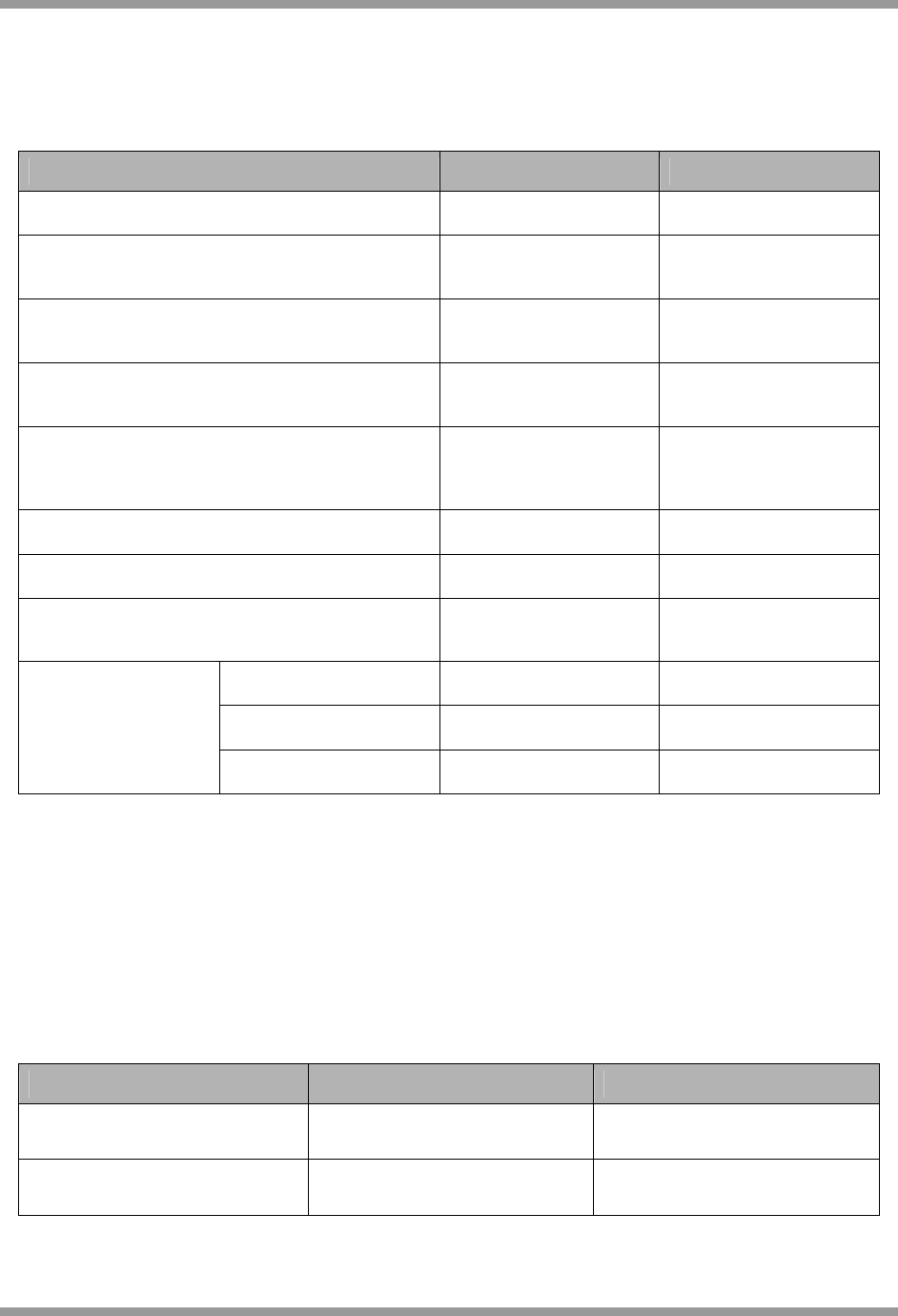
Jennic
JennicJennic
Jennic
50 JN-DS-JN5139 v1.5 © Jennic 2008
17 Electrical Characteristics
17.1 Maximum ratings
Exceeding these conditions may result in damage to the device.
Parameter Min Max
Device supply voltage VDD1, VDD2 -0.3V 3.6V
Supply voltage at voltage regulator bypass pins
VB_xxx
-0.3V 1.98V
Voltage on analogue pins XTALOUT, XTALIN,
VCOTUNE, RFP, RFM,
-0.3V VB_xxx + 0.3V
Voltage on analogue pins VREF, ADC1-4, DAC1-2,
COMP1M, COMP1P, COMP2M, COMP2P, IBIAS,
-0.3V VDD1 + 0.3V
Voltage on 5v tolerant digital pins SPICLK,
SPIMOSI, SPIMISO, SPISEL0, DIO0-DIO8, DIO11-
DIO20, RESETN
-0.3V Lower of (VDD2 + 2V)
and 5.5V
Voltage on 3v tolerant digital pins DIO9, DIO10 -0.3V VDD2 + 0.3V
Storage temperature -40ºC 150ºC
Reflow soldering temperature according to
IPC/JEDEC J-STD-020C
260ºC
Human Body Model
1
2.0kV
Machine Model
2
200V
ESD rating
Charged Device Model
3
500V
1) Testing for Human Body Model discharge is performed as specified in JEDEC Standard JESD22-A114.
2) Testing for Machine Model discharge is performed as specified in JEDEC Standard JESD11-A115.
3) Testing for Charged Device Model discharge is performed as specified in JEDEC Standard JESD22-C101.
17.2 DC Electrical Characteristics
17.2.1 Operating Conditions
Supply Min Max
VDD1, VDD2 2.2V 3.6V
Ambient temperature range -40ºC 85ºC
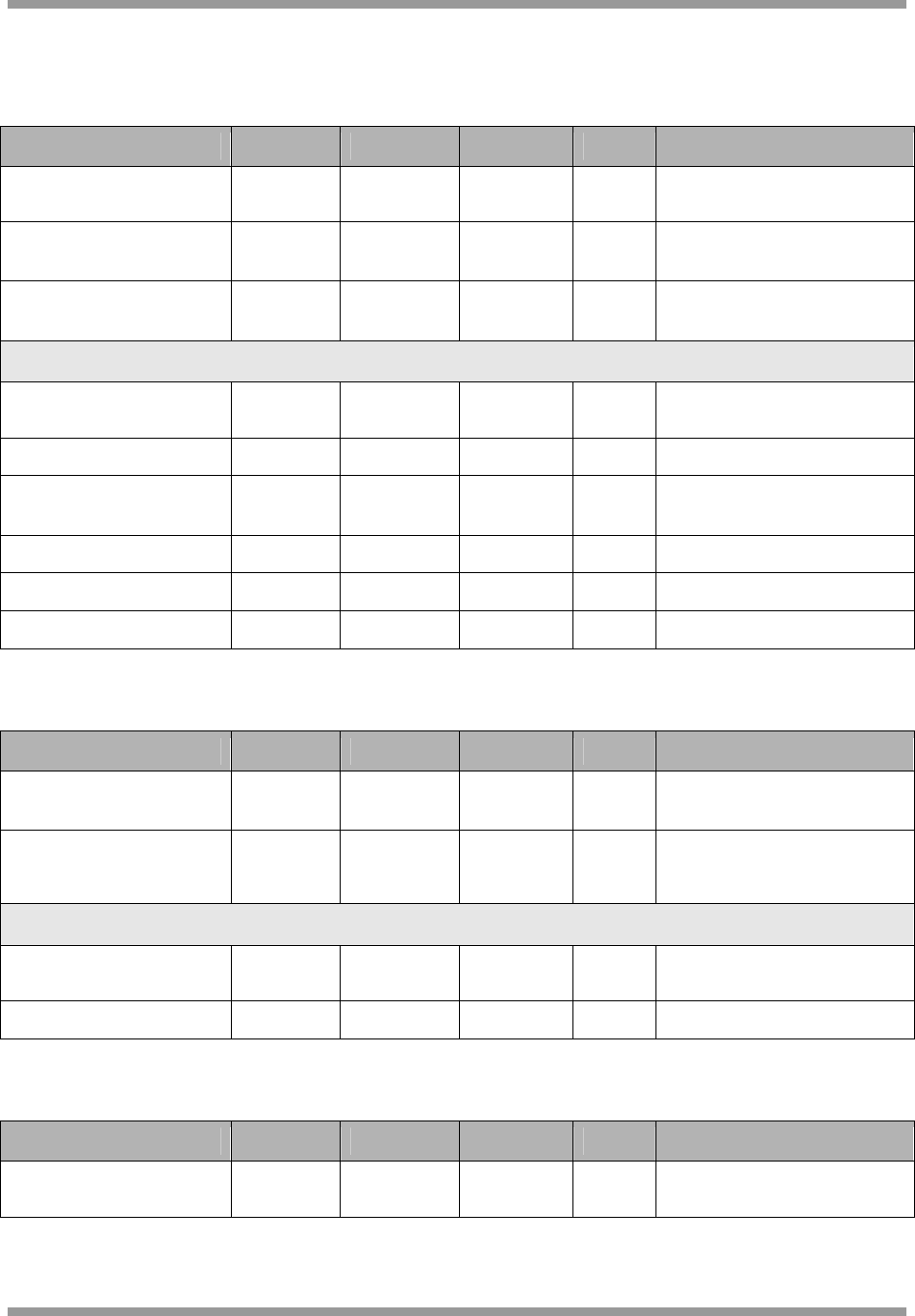
Jennic
JennicJennic
Jennic
© Jennic 2008 JN-DS-JN5139 v1.5 51
17.2.2 DC Current Consumption
VDD = 2.2 to 3.6V, -40 to +85º C
17.2.2.1 Active Processing
Mode: Min Typ Max Unit Notes
CPU processing 2.85 +
0.295/MHz
4.5 +
0.480/MHz
mA SPI, DIOs enabled
Radio transmit
[boost mode]
38
[42]
50
[55]
mA CPU in software doze – radio
transmitting
Radio receive
[boost mode]
37
[40]
48
[53]
mA CPU in software doze – radio in
receive mode
The following current figures should be added to those above if the feature is being used
ADC 655 µA Temperature sensor and battery
measurements require ADC
DAC 215 / 235 µA One / both
Comparator 67.5
[1.2]
µA Fast response time
[low-power]
UART 95 µA For each UART
Timer 65 µA For each Timer
2-wire serial interface 75 µA
17.2.2.2 Sleep Mode
Mode: Min Typ Max Unit Notes
Sleep mode with I/O wakeup
(Waiting on I/O event)
0.1
µA
Sleep mode with I/O and timer
wakeup – measured at 25ºC
1.2 2.5 µA As above but also waiting on timer
event. If both wakeup timers are
enabled then add another 0.3µA
The following current figures should be added to those above if the feature is being used
RAM retention – measured at
25ºC
2.4 10 µA For full 96kB retained.
Comparator (low-power mode) 1.2 µA Reduced response time.
17.2.2.3 Deep Sleep Mode
Mode: Min Typ Max Unit Notes
Deep sleep mode – measured
at 25ºC
60 250 nA Waiting on chip RESET or I/O
event.
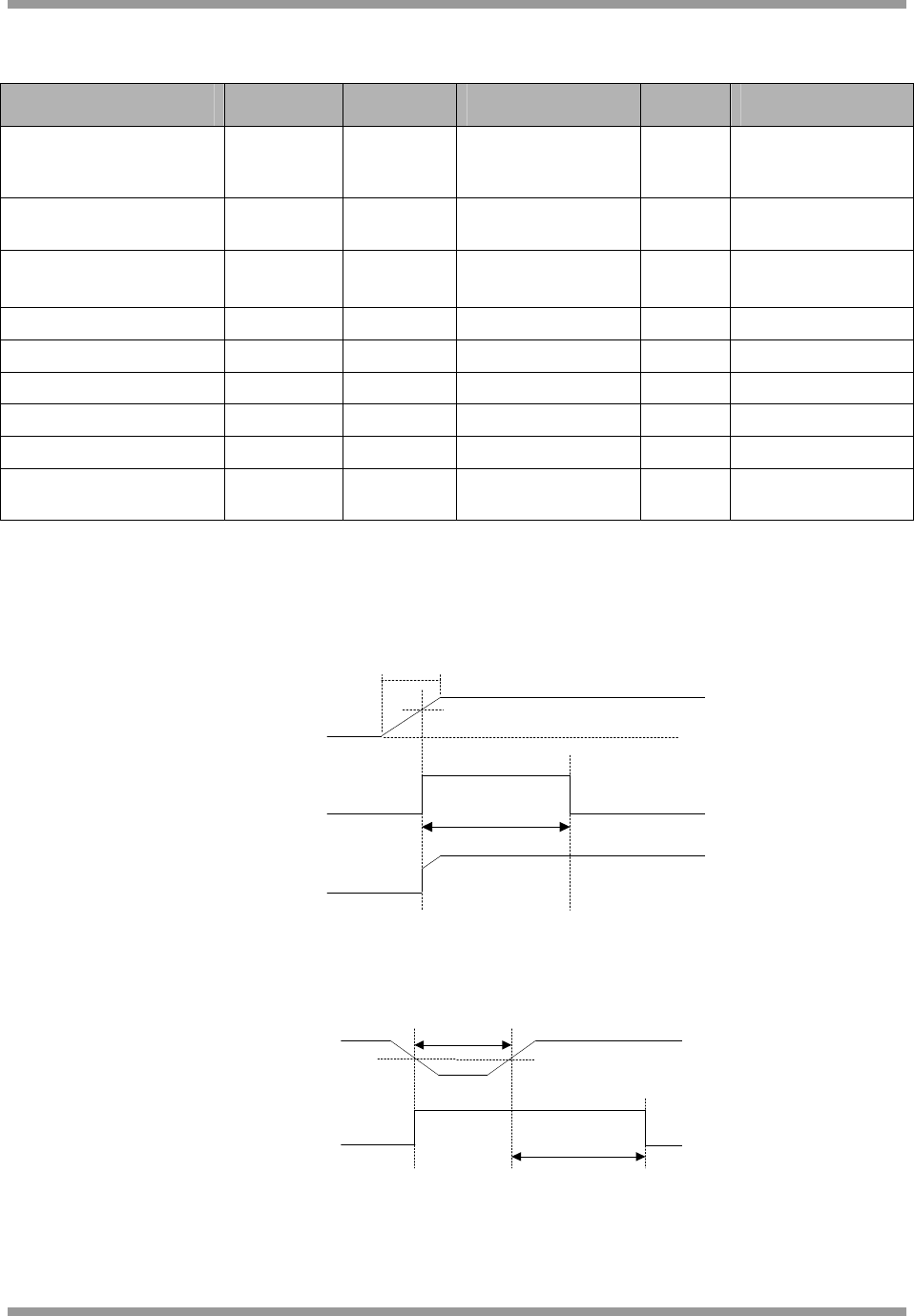
Jennic
JennicJennic
Jennic
52 JN-DS-JN5139 v1.5 © Jennic 2008
17.2.3 I/O Characteristics
VDD = 2.2 to 3.6V, -40 to +85º C
Parameter Min Typ Max Unit Notes
Internal DIO pull – up
resistors
22
24
31
34
40
56
53
63
92
k
Ω
VDD2 = 3.6V
VDD2 = 3.0V
VDD2 = 2.2V
Digital I/O High Input
(exception DIO9, DIO10)
VDD2 x 0.7 Lower of (VDD2 + 2V)
and 5.5V
V 5V Tolerant I/O only
Digital I/O low Input
(exception DIO9, DIO10)
-0.3 VDD x 0.27 V 5V Tolerant I/O only
Digital I/O input hysteresis 140 230 310 mV
DIO High O/P (2.7-3.6V) VDD2 x 0.8 VDD2 V With 4mA load
DIO Low O/P (2.7-3.6V) 0 0.4V V With 4mA load
DIO High O/P (2.2-2.7V) VDD2 x 0.8 VDD2 V With 3mA load
DIO Low O/P (2.2-2.7V) 0 0.4V V With 3mA load
Current sink/source
capability
4
3
mA VDD2 = 2.7V to 3.6V
VDD2 = 2.2V to 2.7V
17.3 AC Characteristics
17.3.1 Reset
RESETN
Internal RESET
VDD
V
POT
t
STAB
t
RISE
0V
Figure 40: Power-on Reset
Internal RESET
RESETN V
RST
t
STAB
t
RST
Figure 41: External Reset
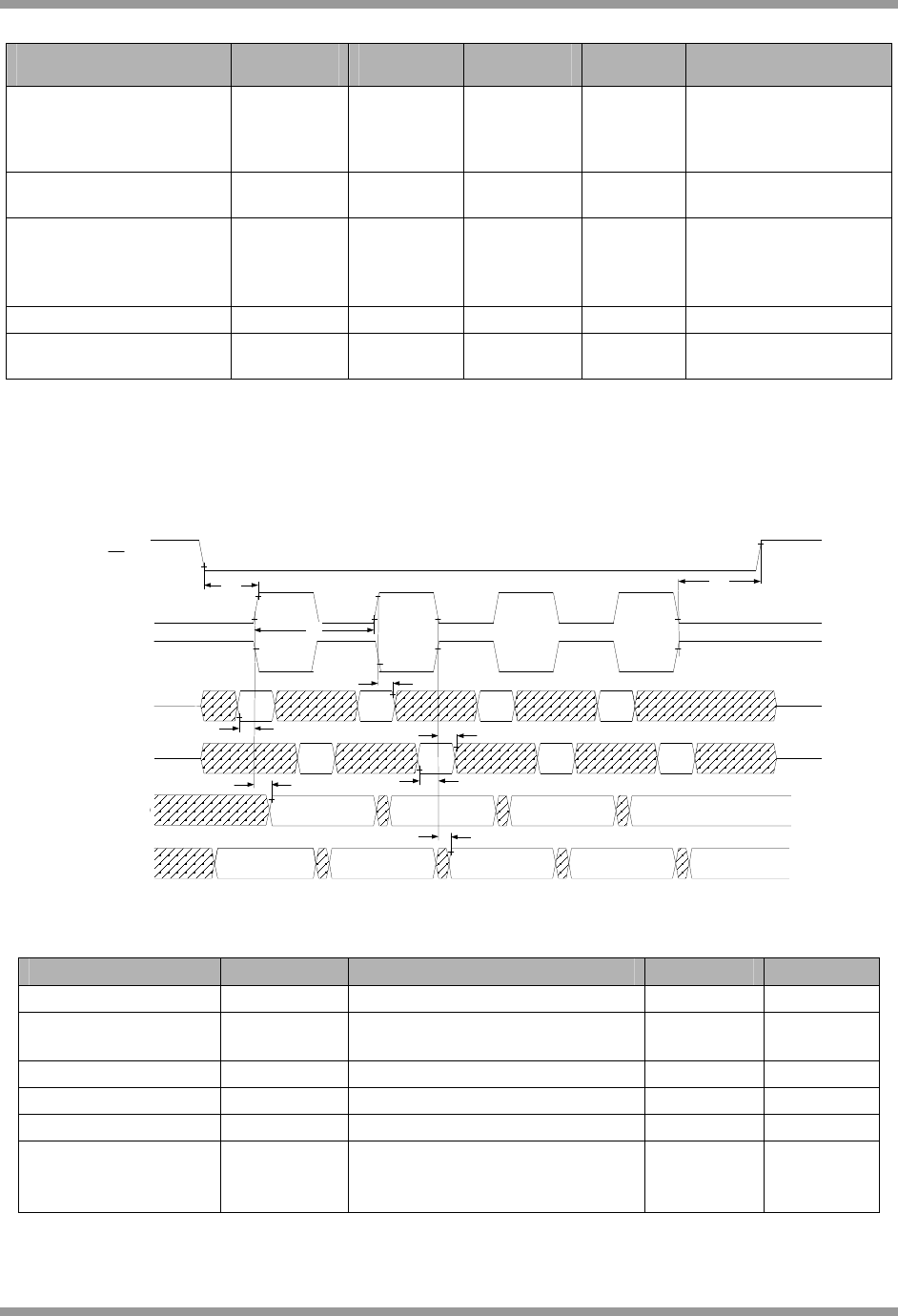
Jennic
JennicJennic
Jennic
© Jennic 2008 JN-DS-JN5139 v1.5 53
Parameter Min Typ Max Unit Notes
External Reset pulse width
(t
RST
)
1
µs Assumes internal pullup
resistor value of 100K
worst case and ~5pF
external capacitance
External Reset threshold
voltage (V
RST
)
VDD2 x 0.7 V Minimum voltage to
avoid being reset
Internal Power-on Reset
threshold voltage (V
POT
)
1.90
1.95
2.00
V VDD2 = 2.2V
VDD2 = 3.0V
VDD2 = 3.6V
Note 1
Reset rise time (t
RISE
) 1 ms
Reset stabilisation time
(t
STAB
)
2.5 ms Note 2
1
VDD rise time of 1ms.
2
Time from release of reset to start of executing ROM code. Loading program from Flash occurs in addition to this.
17.3.2 SPI Timing
t
SSH
t
SSS
t
CK
t
SI
t
HI
MOSI
(mode=1,3)
SS
MOSI
(mode=0,2)
MISO
(mode=0,2)
MISO
(mode=1,3)
t
VO
t
VO
CLK
(mode=0,1)
t
SI
t
HI
CLK
(mode=2,3)
Figure 42: SPI Timing (Master)
Parameter Symbol Min Max Unit
Clock period t
CK
62.5 - ns
Data setup time t
SI
15.3 @ 2.7-3.6V
30.5 @ 2.2-3.6V
- ns
Data hold time t
HI
0 ns
Data invalid period t
VO
- 15 ns
Select set-up period t
SSS
60 - ns
Select hold period t
SSH
30 (SPICLK = 16MHz)
0 (SPICLK<16MHz, mode=0 or 2)
60 (SPICLK<16MHz, mode=1 or 3)
- ns
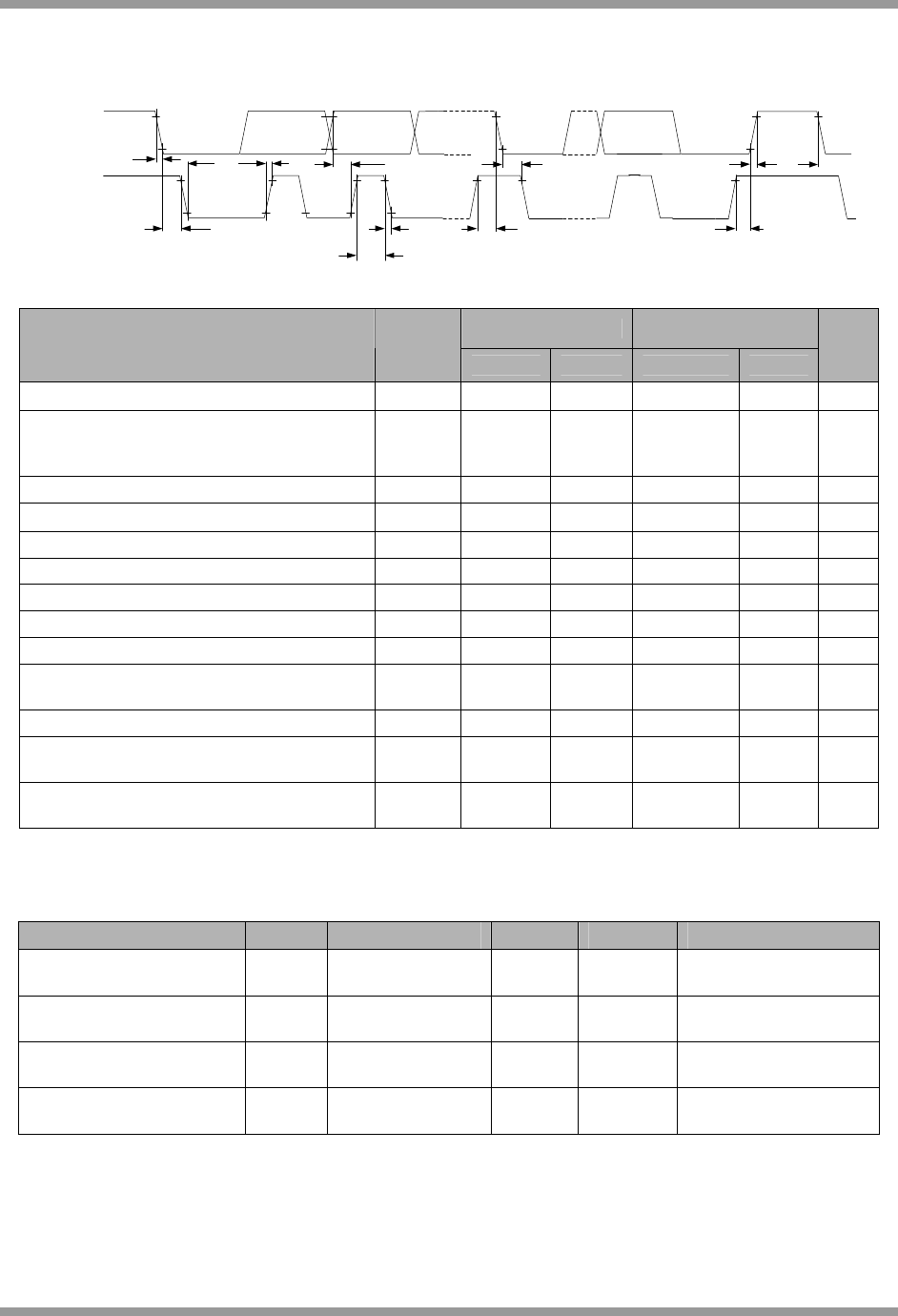
Jennic
JennicJennic
Jennic
54 JN-DS-JN5139 v1.5 © Jennic 2008
17.3.3 Two-wire serial interface
tBUF
tLOW
tHD;STA
tFtR
tHIGH
tSU;DAT
tSU;STA
tHD;STA
tSU;STO
tR
tF
SIF_D
SIF_CLK
Figure 43: Two-wire serial Interface Timing
Standard Mode Fast Mode
Parameter Symbol
Min Max Min Max
Unit
SIF_CLK clock frequency
f
SCL
0 100 0 400 kHz
Hold time (repeated) START condition.
After this period, the first clock pulse is
generated
t
HD:STA
4 - 0.6 - µs
LOW period of the SIF_CLK clock
t
LOW
4.7 - 1.3 - µs
HIGH period of the SIF_CLK clock
t
HIGH
4 - 0.6 - µs
Set-up time for repeated START condition t
SU:STA
2 - 0.5 - µs
Data setup time SIF_D t
SU:DAT
0.25 - 0.1 - µs
Rise Time SIF_D and SIF_CLK t
R
- 1000 20+0.1Cb 300 ns
Fall Time SIF_D and SIF_CLK t
F
- 300 20+0.1Cb 300 ns
Set-up time for STOP condition t
SU:STO
4 - 0.6 - µs
Bus free time between a STOP and START
condition
t
BUF
4.7 - 1.3 - µs
Capacitive load for each bus line C
b
- 400 - 400 pF
Noise margin at the LOW level for each
connected device (including hysteresis)
V
nl
0.1VDD - 0.1VDD - V
Noise margin at the HIGH level for each
connected device (including hysteresis)
V
nh
0.2VDD - 0.2VDD - V
17.3.4 Power Down and Wake-Up timings
Parameter Min Typ Max Unit Notes
Wake up from Deep Sleep
(or reset)
2.5 + 0.5* program
size in kBytes
ms Assumes SPI clock to
external Flash is16MHz
Wake up from Sleep
(memory not held)
2.5 + 0.5* program
size in kBytes
ms Assumes SPI clock to
external Flash is16MHz
Wake up from Sleep
(Memory held)
2.5 ms
Wake up from CPU Doze
mode
0.2 µs
Note: The 2.5ms time is from release of reset wakeup event to the CPU executing code. At this point if the Flash is
read there is an additional startup delay, as shown in the table.

Jennic
JennicJennic
Jennic
© Jennic 2008 JN-DS-JN5139 v1.5 55
17.3.5 32kHz Oscillator
VDD = 2.2 to 3.6V, -40 to +85 ºC
Parameter Min Typ Max Unit Notes
Current consumption of cell
and counter logic
1.2
1.0
0.8
µA 3.6V
3.0V
2.2V
32kHz clock native
accuracy
-30% 32kHz +30% At 3.0V 25
°
C
Calibrated 32kHz accuracy ±330 ppm For a 1 second sleep
period calibrating over
100 x 32kHz clock
periods
Variation with temperature +0.008 %/°C
Variation with VDD2 -5 %/V
17.3.6 16MHz Crystal Oscillator
VDD = 2.2 to 3.6V, -40 to +85ºC
Parameter Min Typ Max Unit Notes
Current consumption 80 215 350 µA Including bandgap ref.
Start – up time 2.5 ms Assuming xtal with ESR of
40ohms and CL= 9pF
External caps = 15pF
(150mV pk-pk) see
Appendix B
Input capacitance 1.4 pF Bondpad and package,
guaranteed by design
Transconductance 1.05 1.3 1.7 mA/V
DC voltages, XTALIN,
XTALOUT
300 390 480 mV
External Capacitors 15 pF Total external capacitance
needs to be 2*CL, allowing
for stray capacitance from
chip, package and PCB

Jennic
JennicJennic
Jennic
56 JN-DS-JN5139 v1.5 © Jennic 2008
17.3.7 Bandgap Reference
VDD = 2.2 to 3.6V, -40 to +85ºC
Parameter Min Typ Max Unit Notes
Voltage 1.134 1.176 1.217
V
DC power supply rejection -58 DB at 25ºC
Temperature coefficient -82
+40
ppm/°C 0 to 85ºC
-40ºC to 0ºC
Point of inflexion 0 ºC
17.3.8 Analogue to Digital Converters
VDD = 3.0V, VREF = 1.2V, -40 to +85ºC
Parameter Min Typ Max Unit Notes
Resolution 12
bits 500kHz Clock
Current consumption 655 µA
Integral nonlinearity ± 2 LSB
Differential nonlinearity -1 +2 LSB Guaranteed monotonic
Offset error ± 10 mV
Gain error ± 20 mV
Internal clock 500 kHz 16MHz input clock,
÷
32
No. internal clock periods
to sample input
2, 4, 6 or 8 Programmable
Conversion time 40 µs 500KHz Clock with
sample period of 2
Input voltage range 0 to Vref
or 0 to
2*Vref
V Switchable
Vref (Internal) See Section 17.3.7 Bandgap Reference
Vref (External) 1.15 1.2 1.6 V Allowable range into
VREF pin
Input capacitance 8 pF In series with 5K ohms

Jennic
JennicJennic
Jennic
© Jennic 2008 JN-DS-JN5139 v1.5 57
17.3.9 Digital to Analogue Converters
VDD = 3.0V, VREF = 1.2V, -40 to +85ºC
Parameter Min Typ Max Unit Notes
Resolution 11 bits
Current consumption 215 (single)
235 (both)
µA
Integral nonlinearity ± 2 LSB
Differential nonlinearity -1 +1 LSB Guaranteed monotonic
Offset error -10 mV
Gain error -30 mV
Internal clock 2MHz,
1MHz,
500kHz,
250kHz
16MHz input clock,
programmable
prescaler
Output settling time to
0.5LSB
5 µs With 10k ohms & 20pF
load
Minimum Update time 9 µs 2MHz Clock with
sample period of 8
Output voltage swing 0 Lower of
Vdd-1.2 and
Vref
V Gain =1 Output voltage swing
Output voltage swing 0 Lower of
2x(Vdd-1.2 )
and Vdd-0.2
and 2xVref
V Gain =2 Output voltage swing
Vref (Internal) See Section 17.3.7 Bandgap Reference
VREF (External) 0.8 1.2 1.6 V Allowable range into
VREF pin
Resistive load 10kΩ To ground
Capacitive load 20 pF
Digital input coding Binary
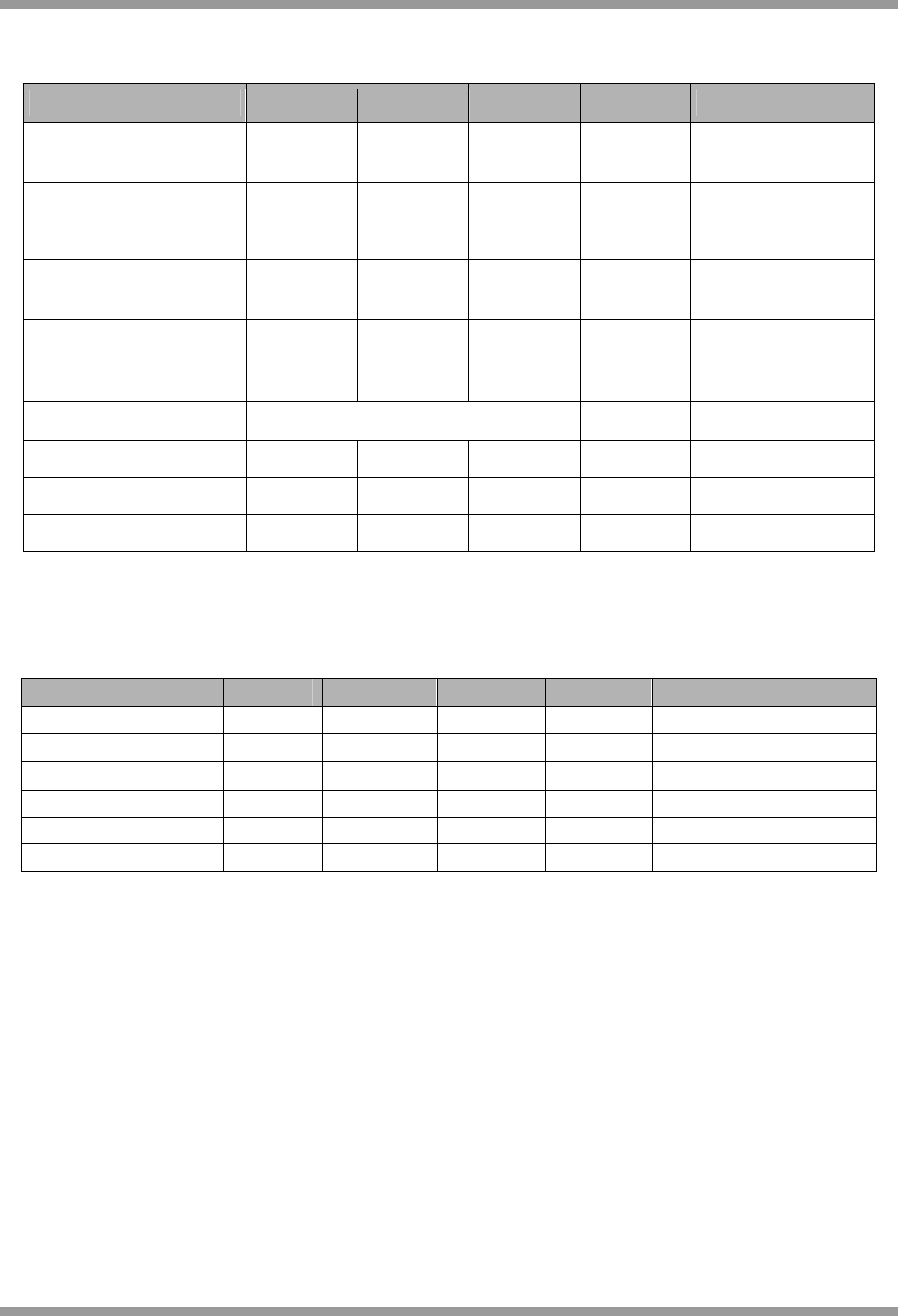
Jennic
JennicJennic
Jennic
58 JN-DS-JN5139 v1.5 © Jennic 2008
17.3.10 Comparators
VDD = 2.2 to 3.6V -40 to +85ºC
Parameter Min Typ Max Unit Notes
Analogue response time
(normal)
105 140 ns +/- 250mV overdrive
10pF load
Total response time
(normal) including delay to
Interrupt controller
105 + 125 ns Digital delay can be
up to a max. of two
16MHz clock periods
Analogue response time
(low power)
2.4
µs +/- 250mV overdrive
No digital delay
Hysteresis 4
12
28
10
20
40
16
26
50
mV Programmable in 3
steps and zero.
Vref (Internal) See Section 17.3.7 Bandgap Reference V
Common Mode input range
0 Vdd V
Current (normal mode) 40 67.5 90 µA
Current (low power mode) 1.2 µA
17.3.11 Temperature Sensor
Parameter Min Typ Max Unit Notes
Operating Range -40 - 85
°
C
Sensor Gain -1.44 -1.55 -1.66 mV/
°
C
Accuracy - -
±
10
°
C
Non-linearity - - 2.5
°
C
Output Voltage Range 630 745 855 mV
Resolution 0.154 0.182 0.209
°
C/LSB 0 to Vref ADC I/P Range

Jennic
JennicJennic
Jennic
© Jennic 2008 JN-DS-JN5139 v1.5 59
17.3.12 Radio Transceiver
This JN5139 meets all the requirements of the IEEE802.15.4 standard over 2.2 - 3.6V and offers the following
improved RF characteristics. All RF characteristics are measured single ended and include the losses of a ceramic
balun.
Parameter Min Typical Max Notes
RF Port Characteristics
Type Differential
Impedance 200ohm 2.4-2.5GHz
Frequency range 2.4 GHz 2.4835GHz

Jennic
JennicJennic
Jennic
60 JN-DS-JN5139 v1.5 © Jennic 2008
17.3.12.1 Radio parameters: 2.2-3.6V, +25ºC
Parameter Min Typical Max Unit Notes
Receiver Characteristics
Receive sensitivity -89 -96 dBm Nominal for 1% PER, as per
802.15.4 section 6.5.3.3
Receive sensitivity
(boost)
-91 -96.5 dBm Nominal for 1% PER, as per
802.15.4 section 6.5.3.3
Maximum input signal 0 dBm For 1% PER, measured as
sensitivity
Adjacent channel
rejection
-1 channel / +1 channel
[CW Interferer]
31 / 35
[35 / 38]
dB For 1% PER with wanted signal
3dB above sensitivity, as per
802.15.4 section 6.5.3.4
(modulated interferer)
Alternate channel
rejection
[CW Interferer]
41
[45]
dB For 1% PER with wanted signal
3dB above sensitivity, as per
802.15.4 section 6.5.3.4
(modulated interferer)
Other in band rejection
2.4 to 2.4835 GHz,
excluding adj channels
50 dB For 1% PER with wanted signal
3dB above sensitivity, measured as
per 802.15.4 section 6.5.3.4
Out of band rejection 43 dB
Spurious emissions
(RX)
-60
-53
-57
-47
dBm 30MHz to 1GHz
1GHz to 12GHz
Intermodulation
protection
50 dB For 1% PER at with wanted signal
3dB above sensitivity. Modulated
Interferers at 2 & 4 channel
separation
RSSI linearity -4 +4 dB -95 to -10dBm
Transmitter Characteristics
Transmit power +1.5 dBm
Transmit power (boost) 0 +2.7 dBm
Output power control
range
-30.1 dB in 5 6dB steps
Spurious emissions
(TX)
-59
-47
-36
-43
-47
dBm 30MHz to 1GHz,
1GHz to12.5GHz,
The following exceptions apply
1.8 to 1.9GHz & 5.15 to 5.3GHz
EVM [offset] 15 [4.5] 25 % At maximum output power
Transmit Power
Spectral Density
-37 -20 dBc At greater than 3.5MHz offset, as
per 802.15.4, section 6.5.3.1

Jennic
JennicJennic
Jennic
© Jennic 2008 JN-DS-JN5139 v1.5 61
17.3.12.2 Radio parameters: 2.2-3.6V, -40ºC
Parameter Min Typical Max Unit Notes
Receiver Characteristics
Receive sensitivity -97 dBm Nominal for 1% PER, as per
802.15.4 section 6.5.3.3
Maximum input signal 0 dBm For 1% PER, measured as
sensitivity
Adjacent channel
rejection
-1 channel / +1 channel
31 / 35 dB For 1% PER with wanted signal
3dB above sensitivity, as per
802.15.4 section 6.5.3.4
Alternate channel
rejection
42 dB For 1% PER with wanted signal
3dB above sensitivity, as per
802.15.4 section 6.5.3.4
Other in band rejection 40 dB 2.4 to 2.4835 GHz, excluding
adjacent channels
For 1% PER with wanted signal
3dB above sensitivity, measured
as per 802.15.4 section 6.5.3.4
Out of band rejection 40 dB
Spurious emissions
(RX)
-60
-53
-57
-47
dBm 30MHz to 1GHz
1 to 12GHz
Intermodulation
protection
50 dB For 1% PER at with wanted signal
3dB above sensitivity. Modulated
Interferers at 2 & 4 channel
separation
RSSI linearity -4 +4 dB -95 to -10dBm
Transmitter Characteristics
Transmit power -1 +2 dBm
Transmit power (boost) +3 dBm
Output power control
range
-29.3 dB in 5 6dB steps
Spurious emissions
(TX)
-59
-46
-36
-43
-47
dBm 30MHz to 1GHz,
1GHz to12.5GHz,
The following exceptions apply
1.8 to 1.9GHz &
5.15 to 5.3GHz
EVM [offset] 20 [6.2] 30 % At maximum output power
Transmit Power
Spectral Density
-36 -20 dBc At greater than 3.5MHz offset, as
per 802.15.4, section 6.5.3.1

Jennic
JennicJennic
Jennic
62 JN-DS-JN5139 v1.5 © Jennic 2008
17.3.12.3 Radio parameters: 2.2-3.6V, +85ºC
Parameter Min Typical Max Unit Notes
Receiver Characteristics
Receive sensitivity -94 dBm Nominal for 1% PER, as per
802.15.4 section 6.5.3.3
Maximum input signal 0 dBm For 1% PER, measured as
sensitivity
Adjacent channel
rejection
-1 channel / +1 channel
27 / 35 dB For 1% PER with wanted signal
3dB above sensitivity, as per
802.15.4 section 6.5.3.4
Alternate channel
rejection
44 dB For 1% PER with wanted signal
3dB above sensitivity, as per
802.15.4 section 6.5.3.4
Other in band rejection 44 dB 2.4 to 2.4835 GHz, excluding
adjacent channels
For 1% PER with wanted signal
3dB above sensitivity, measured
as per 802.15.4 section 6.5.3.4
Out of band rejection 44 dB
Spurious emissions
(RX)
-60
-54
-57
-47
dBm 30MHz to 1GHz
1GHz to 12GHz
Intermodulation
protection
51 dB For 1% PER at with wanted
signal 3dB above sensitivity.
Modulated Interferers at 2 & 4
channel separation
RSSI linearity -4 +4 dB -95 to -10dBm
Transmitter Characteristics
Transmit power -1.3 dBm
Transmit power (boost) +0.6 dBm
Output power control
range
-35 dB in 5 steps of 6dB
Spurious emissions
(TX)
-59
-50
-36
-43
-47
dBm 30MHz to 1GHz,
1GHz to12.5GHz,
The following exceptions apply
1.8 to 1.9GHz &
5.15 to 5.3GHz
EVM [offset] 12 [3.6] 25 % At maximum output power
Transmit Power
Spectral Density
-38 -20 dBc At greater than 3.5MHz offset, as
per 802.15.4, section 6.5.3.1
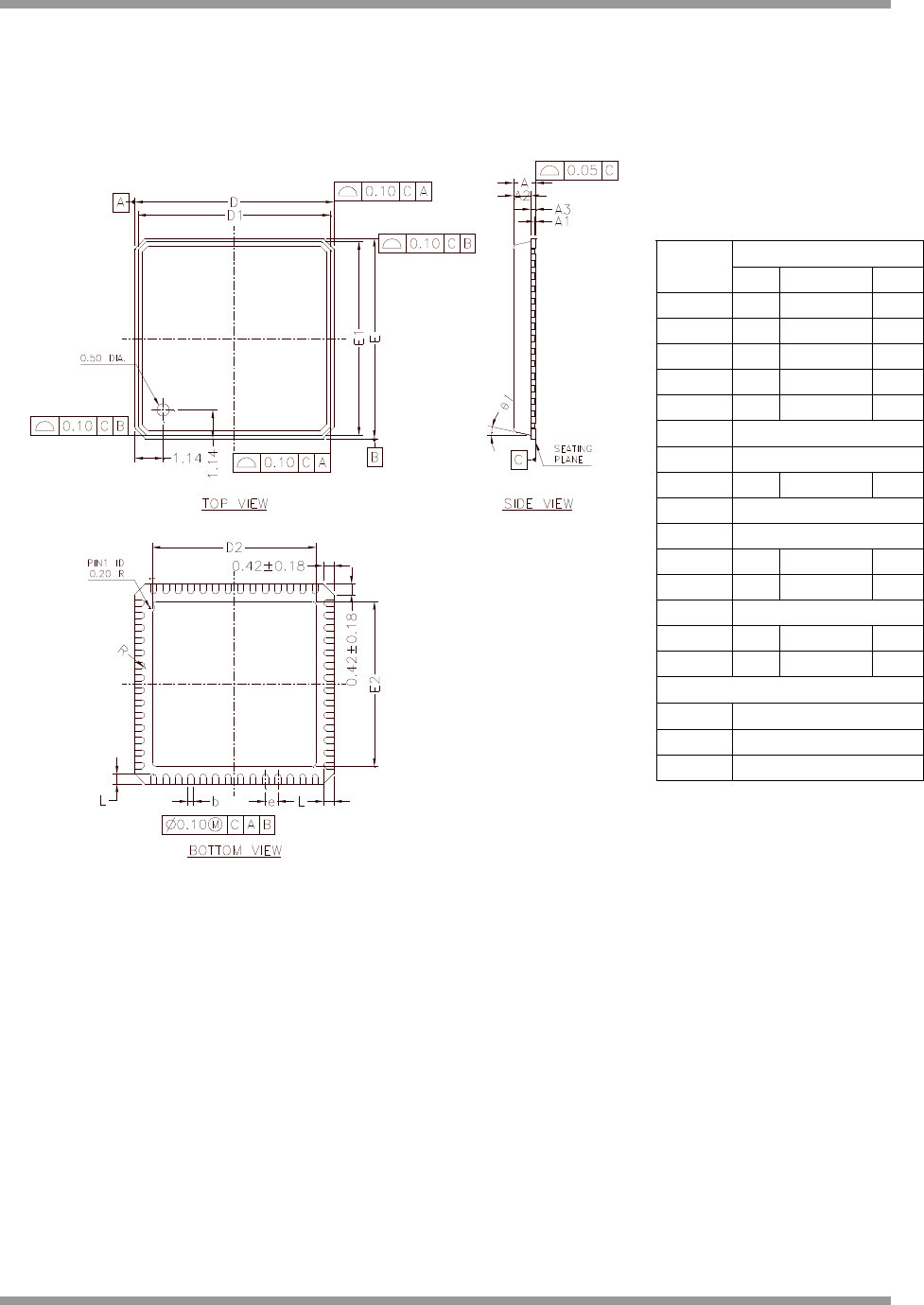
Jennic
JennicJennic
Jennic
© Jennic 2008 JN-DS-JN5139 v1.5 63
Appendix A Mechanical and Ordering Information
A.1 56pin QFN Package Drawing
Controlling Dimension: mm
millimetres
Symbol Min.
Nom. Max.
A ------
------ 0.9
A1 0.00
0.01 0.05
A2 ------
0.65 0.7
A3 0.20 Ref.
b 0.2 0.25 0.3
D 8.00 bsc
D1 7.75 bsc
D2 6.20
6.40 6.60
E 8.00 bsc
E1 7.75 bsc
E2 6.20
6.40 6.60
L 0.30
0.40 0.50
e 0.50 bsc
υ
1
0° ------ 12°
R 0.09
------ ------
Tolerances of Form and Position
aaa 0.10
bbb 0.10
ccc 0.05
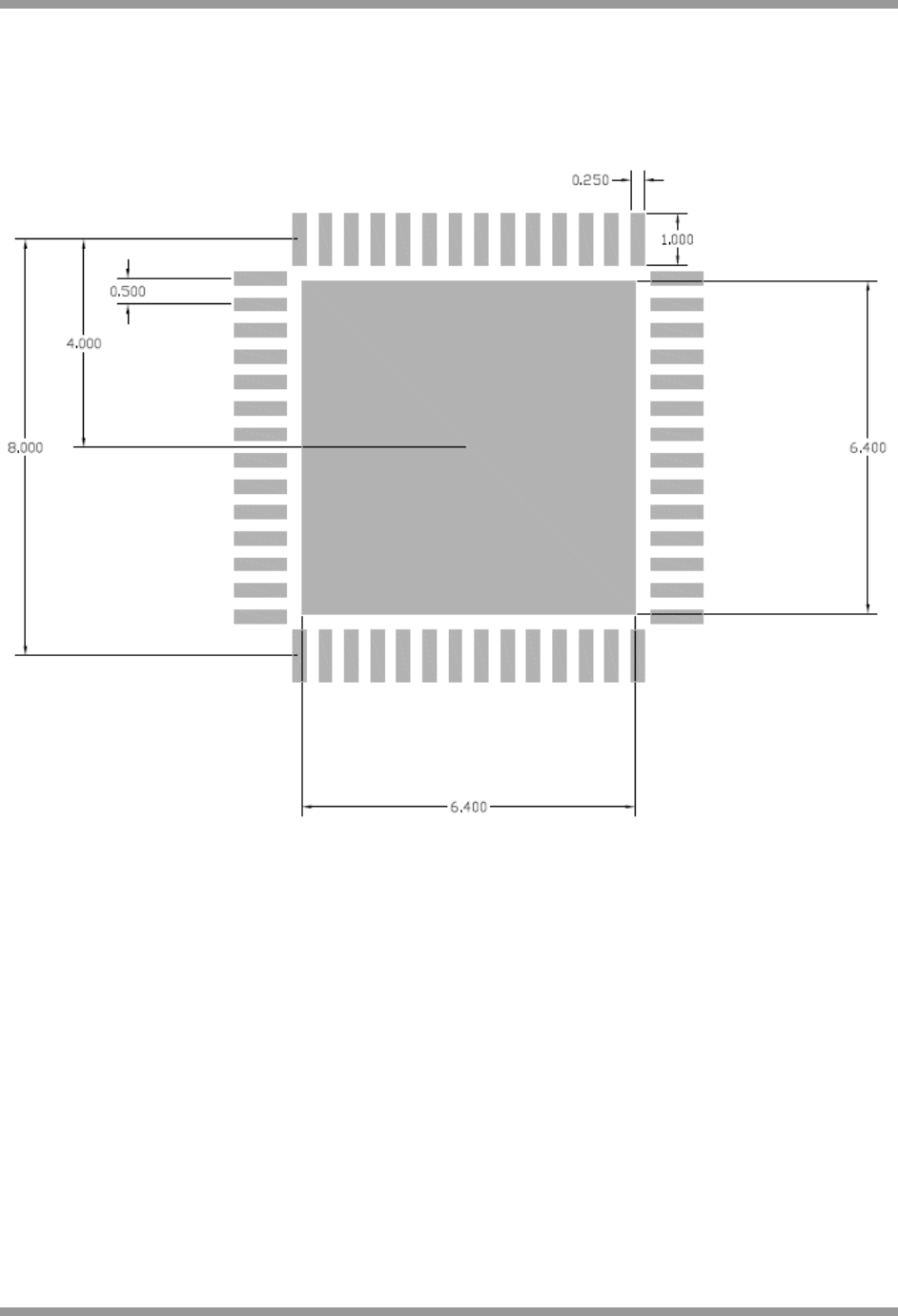
Jennic
JennicJennic
Jennic
64 JN-DS-JN5139 v1.5 © Jennic 2008
A.2 PCB Decal
The following PCB decal is recommended; all dimensions are in millimetres (mm).

Jennic
JennicJennic
Jennic
© Jennic 2008 JN-DS-JN5139 v1.5 65
A.3 Ordering Information
The standard qualification for the JN5139 is Industrial Specification: -40ºC to +85ºC, packaged in a punched 56-pin
QFN (Quad Flat No-leads) package.
Ordering Format:
JN5139 - XXX - Y
1
Part Numbers:
JN5139 Wireless microcontroller - 96kB RAM
XXX: ROM Variant:
001 IEEE802.15.4 stack
Z01 ZigBee stack
Y
1
: Shipping:
T Tape mounted 2500 devices on a 13” reel
V Tape mounted 1000 devices on a 13” reel
X Tape mounted 500 devices on a 7” reel
Y Tape mounted up to 500 devices (no reel)
Ordering Examples:
Part Number Description
JN5139-001-X JN5139 IEEE802.15.4 Wireless Microcontroller – 500 devices on a 7” reel
JN5139-Z01-V JN5139 ZigBee Wireless Microcontroller - 1000 devices on a 13” reel

Jennic
JennicJennic
Jennic
66 JN-DS-JN5139 v1.5 © Jennic 2008
A.4 Device Package Marking
The diagram below shows the package markings for JN5139 devices. The package on the left along with the legend
information below it, shows the general format of package marking. The package on the right shows the specific
markings for a JN5139-Z01 device, that came from assembly build number 1000004 and was manufactured week 4
of 2007.
Jennic
JNXXXX-SSS
FFFFFFF
YYWW
Jennic
JN5139-Z01
1000004
0704
Legend:
JN Jennic
XXXX 4 digit part number, for example 5139
SSS 3 digit software ROM identifier
FFFFFFF 7 digit assembly build number
YY 2 digit year number
WW 2 digit week number
Where this Data Sheet is denoted as “Advanced” or “Preliminary”, devices will be either Engineering or Prototype
Samples. Devices of this status have an R suffix after the software ROM identifier, for example JN5139-Z01
R
.
Devices may also have an additional digit immediately after the R suffix, for example R
1
, R
2
, R
3
etc. This additional
digit is use to identify different revisions of engineering or prototype silicon during these product phases.
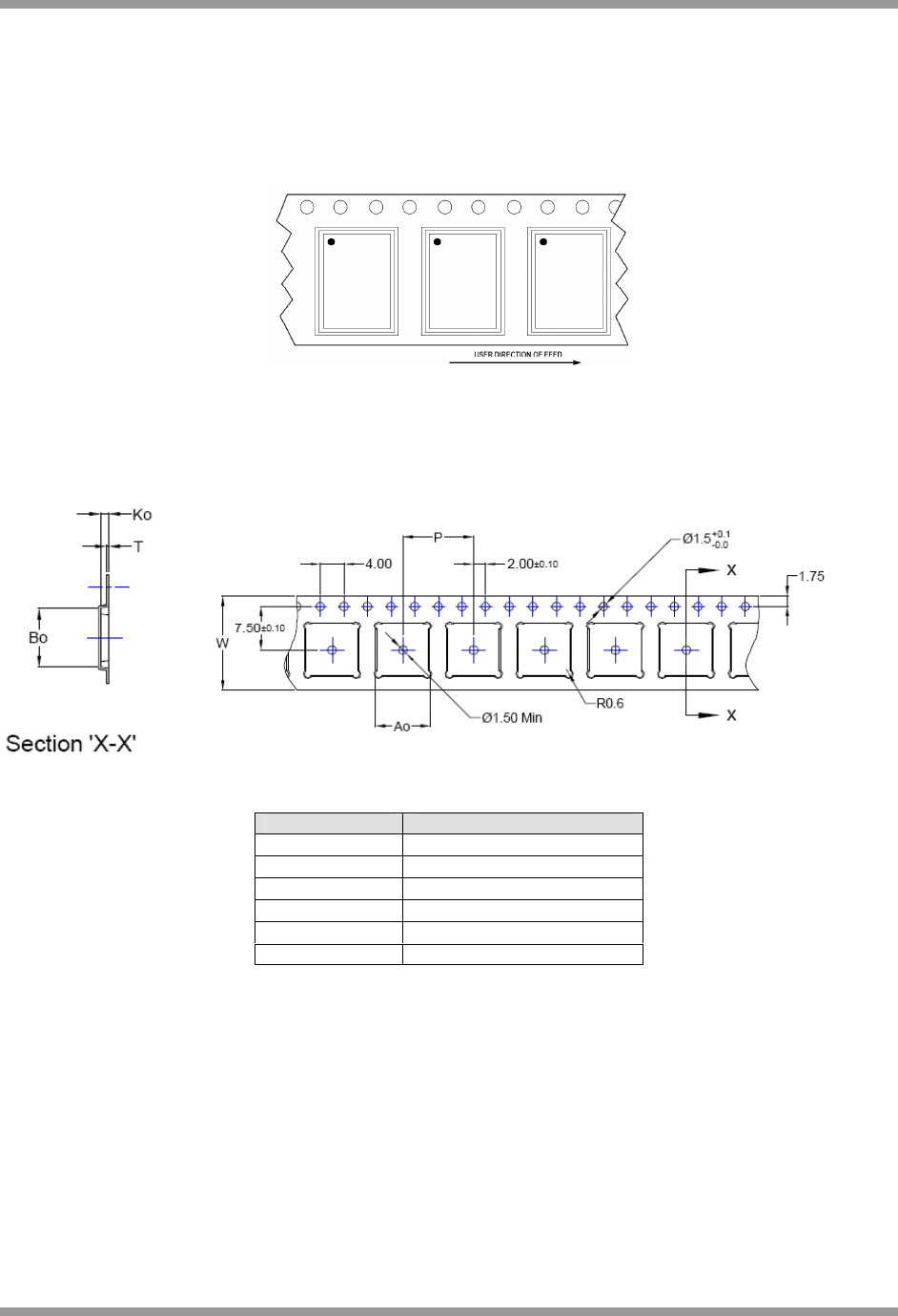
Jennic
JennicJennic
Jennic
© Jennic 2008 JN-DS-JN5139 v1.5 67
A.5 Tape and Reel Information
A.5.1 Tape Orientation and Dimensions
The general orientation of the 56QFN package in the tape is as shown in Figure 42.
Figure 44: Tape and Reel orientation
Figure 43 shows the detailed dimensions of the tape used for 8x8mm 56QFN devices.
Figure 45: Tape Dimensions
Reference Dimensions (mm)
A
o
8.30
±
0.10
B
o
8.30
±
0.10
K
o
1.10
±
0.10
P 12.00
±
0.10
T 0.30
±
0.10
W 16.00 +0.30/-0.10
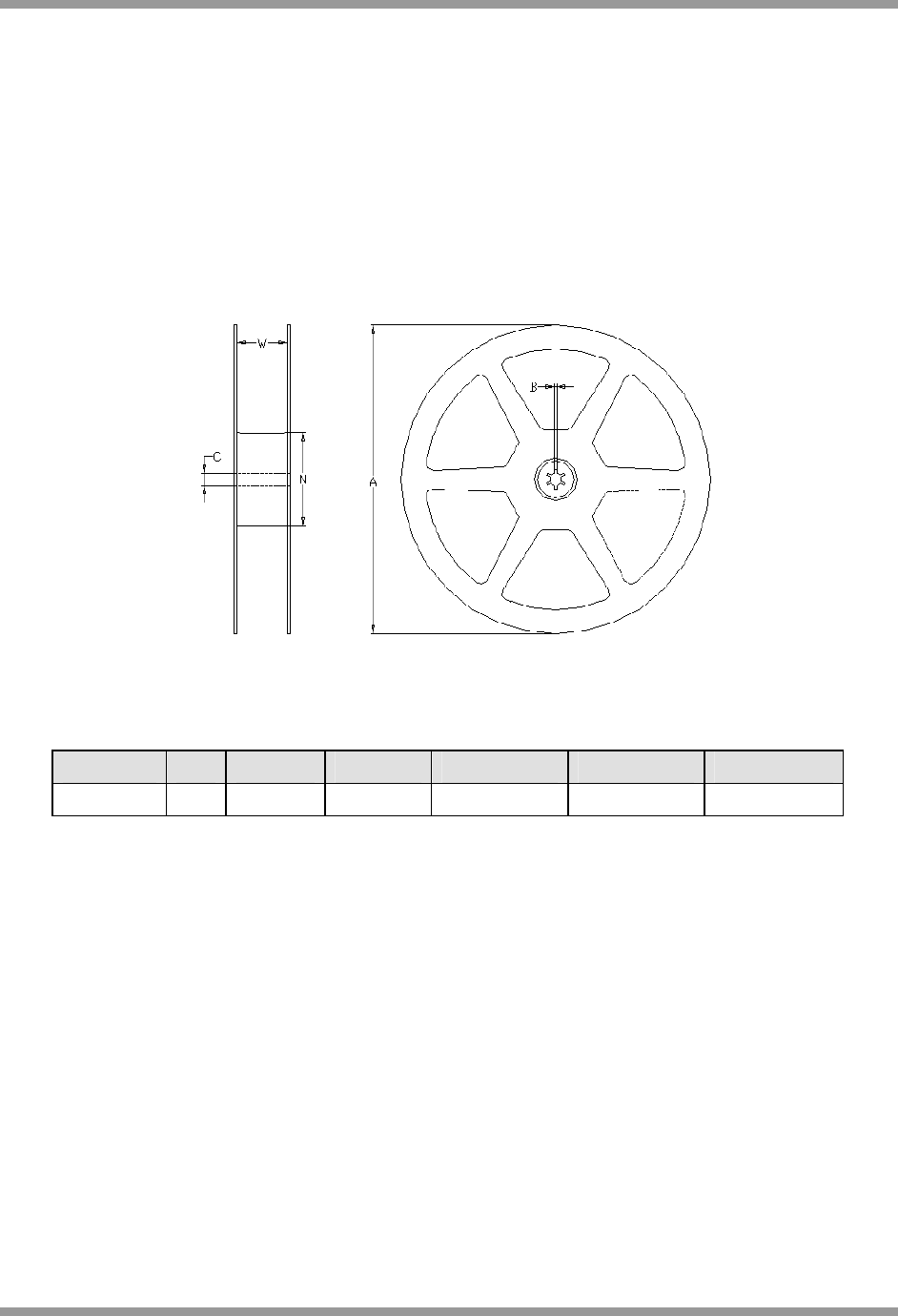
Jennic
JennicJennic
Jennic
68 JN-DS-JN5139 v1.5 © Jennic 2008
A.5.2 Reel Information: 7” Reel
Surface Resistivity Between 10e
9
– 10e
11
Ohms Square
Material High Impact Polystyrene, environmentally friendly, recyclable
All dimensions and tolerances are fully compliant with EIA-481-B and are specified in millimetres.
6 window design with one window on each side blanked to allow adequate labelling space.
Tape Width A B (min) C N W (min) W (max)
16 180 1.5min 13 ±0.2 60 +0.1 –0.0 16.40 17.90
Figure 46: Reel Dimensions
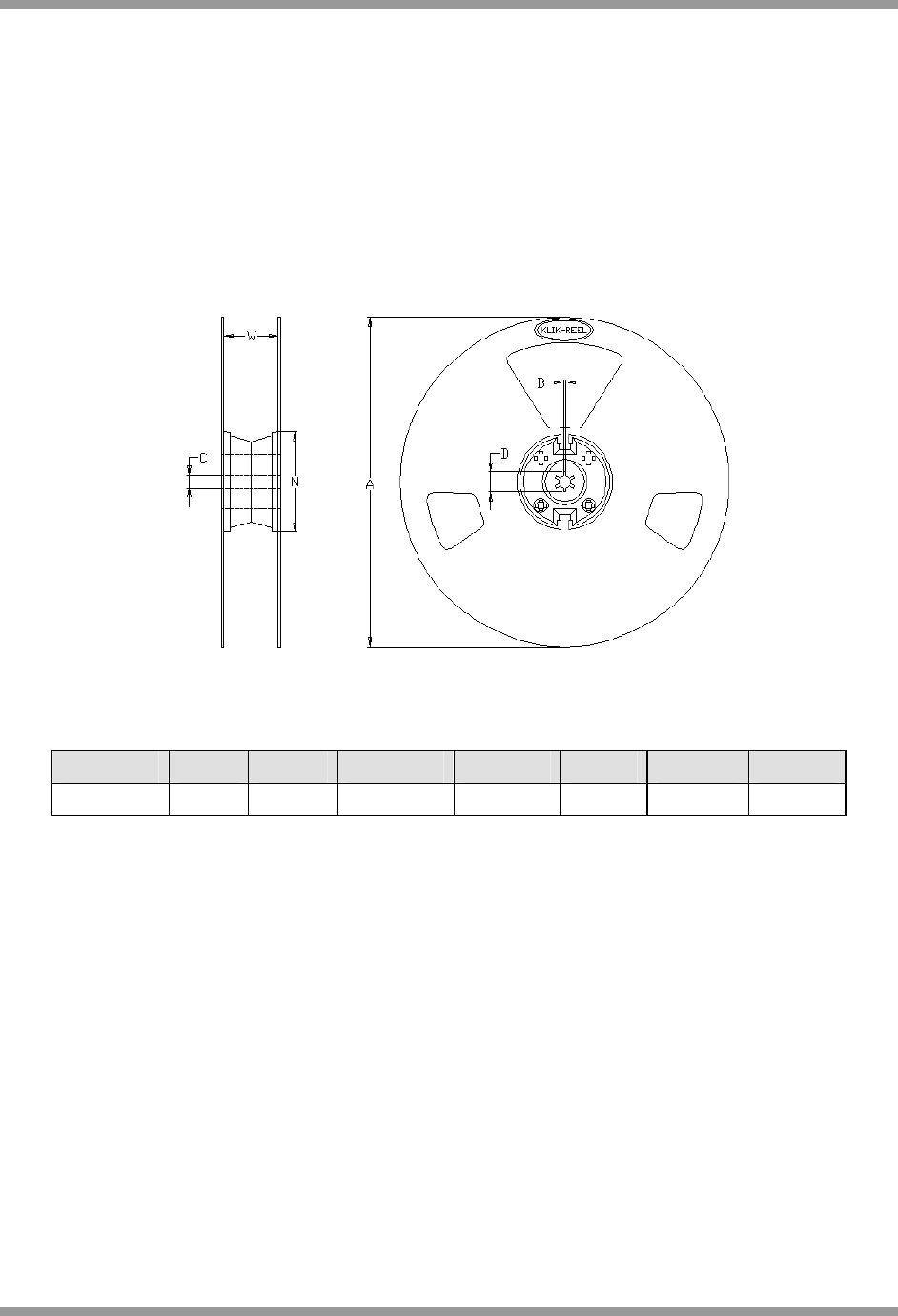
Jennic
JennicJennic
Jennic
© Jennic 2008 JN-DS-JN5139 v1.5 69
A.5.3 Reel Information: 13” Reel
Surface Resistivity Between 10e
9
– 10e
11
Ohms Square
Material High Impact Polystyrene with Antistatic Additive
All dimensions and tolerances are fully compliant with EIA-481-B and are specified in millimetres.
3 window design to allow adequate labelling space.
Tape Width A B (min) C D (min) N (min) W (min) W (max)
16 330 1.5 13 +0.5 -0.2 20.2 100 15.90 19.40
Figure 47: Reel Dimensions
A.5.4
Dry Pack Requirement for Moisture Sensitive Material
Moisture sensitive material, as classified by JEDEC standard J-STD-033, must be dry packed. The 56 lead QFN
package is MSL2A/260
°
C, and is dried before sealing in a moisture barrier bag (MBB) with desiccant bag weighing at
67.5 grams of activated clay and a 6 spot humidity indicator card (HIC) meeting MIL-L-8835 specification. The MBB
has a moisture-sensitivity caution label to indicate the moisture-sensitive classification of the enclosed devices.
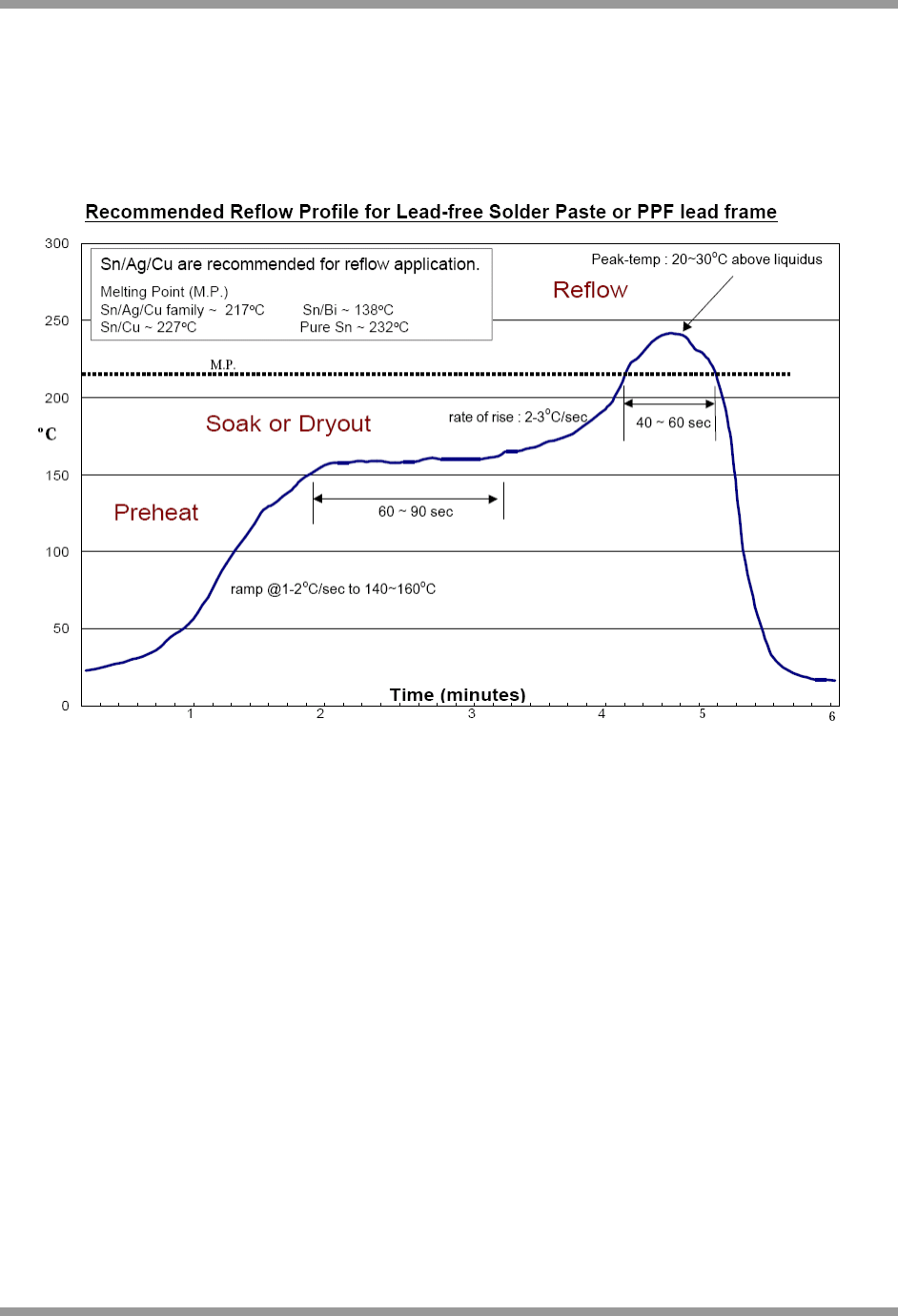
Jennic
JennicJennic
Jennic
70 JN-DS-JN5139 v1.5 © Jennic 2008
A.6 PCB Design and Reflow Profile
PCB and land pattern designs are key to board level reliability, and Jennic strongly recommends that users follow the
design rules listed in IPC-SM-782. For reflow profiles, it is recommended to follow the reflow profile in Figure 48 as a
guide, as well as the paste manufacturers guidelines on peak flow temperature, soak times, time above liquidus and
ramp rates.
Figure 48: Reflow Profile
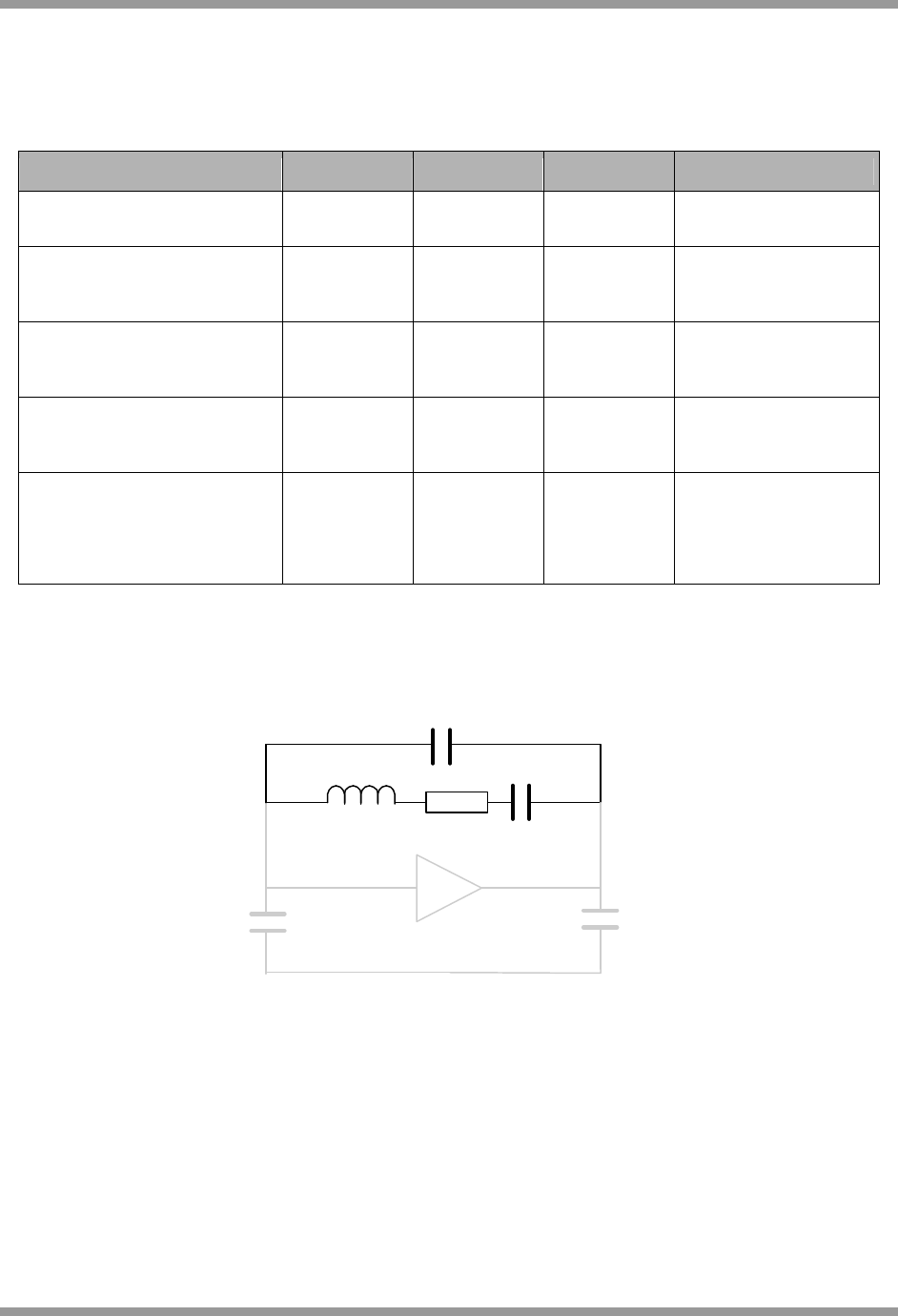
Jennic
JennicJennic
Jennic
© Jennic 2008 JN-DS-JN5139 v1.5 71
Appendix B Development Support
B.1 Crystal Oscillator
16MHz Crystal Requirements
Parameter Min Typ Max Notes
Crystal Frequency 16MHz
Crystal Tolerance 40ppm Including temperature
and ageing
Crystal ESR (Rm)
1
20
Ω
60
Ω
See below for more
details
Crystal Load Capacitance (CL) 9pF See below for more
details
External Capacitors (C1 & C2) 15pF Total external
capacitance needs to be
2*CL. , allowing for stray
capacitance from chip,
package and PCB
B.1.1 Crystal Equivalent Circuit
Cs
Lm Cm
Rm
C2C1
Where
m
C
is the motional capacitance
m
L
is the motional inductance. This together with
m
C
defines the oscillation frequency (series)
m
R
is the equivalent series resistance ( ESR ).
S
C
is the shunt or package capacitance and this is a parasitic

Jennic
JennicJennic
Jennic
72 JN-DS-JN5139 v1.5 © Jennic 2008
B.1.2 Crystal Load Capacitance
The crystal load capacitance is the total capacitance seen at the crystal pins, from all sources. As the load
capacitance (CL) affects the oscillation frequency by a process known as ‘pulling’, crystal manufacturers specify the
frequency for a given load capacitance only. A typical pulling coefficient is 15ppm/pF, to put this into context the
maximum frequency error in the IEEE802.15.4 specification is +/-40ppm for the transmitted signal. Therefore, it is
important for resonance at 16MHz exactly, that the specified load capacitance is provided.
The load capacitance can be calculated using:
CL
=
21
21
TT
TT
C
C
CC
+
×
Total capacitance
inPT
CCCC
1111
+
+
=
Where
1
C
is the capacitor component
P
C
1
is the PCB parasitic capacitance. With the recommended layout this is about 1.6pF
in
C
1
is the on-chip parasitic capacitance and is about 1.4pF typically.
Similarly for
2T
C
Hence for a 9pF load capacitance, and a tight layout the external capacitors should be 15pF
B.1.3 Crystal ESR and Required Transconductance
The resistor in the crystal equivalent circuit represents the energy lost. To maintain oscillation, power must be
supplied by the amplifier, but how much? Firstly, the Pi connected capacitors C
1
and C
2
with C
S
from the crystal,
apply an impedance transformation to Rm, when viewed from the amplifier. This new value is given by:
2
ˆ
+
=
L
LS
mm
C
CC
RR
The amplifier is a transconductance amplifier, which takes a voltage and produces an output current. The amplifier
together with the capacitors C1 and C2, form a circuit, which provides a negative resistance, when viewed from the
crystal. The value of which is given by:
2
21
ω
××
=
TT
m
NEG
C
C
g
R
Where
m
g
is the transconductance
ω
is the frequency in rad/s
Derivations of these formulas can be easily found in textbooks.
In order to give quick and reliable oscillator start-up, a common rule of thumb is to set the amplifier negative
resistance to be a minimum of 4 times the effective crystal resistance. This gives
2
21
ω
××
TT
m
C
C
g
≥
2
4
+
L
LS
m
C
CC
R
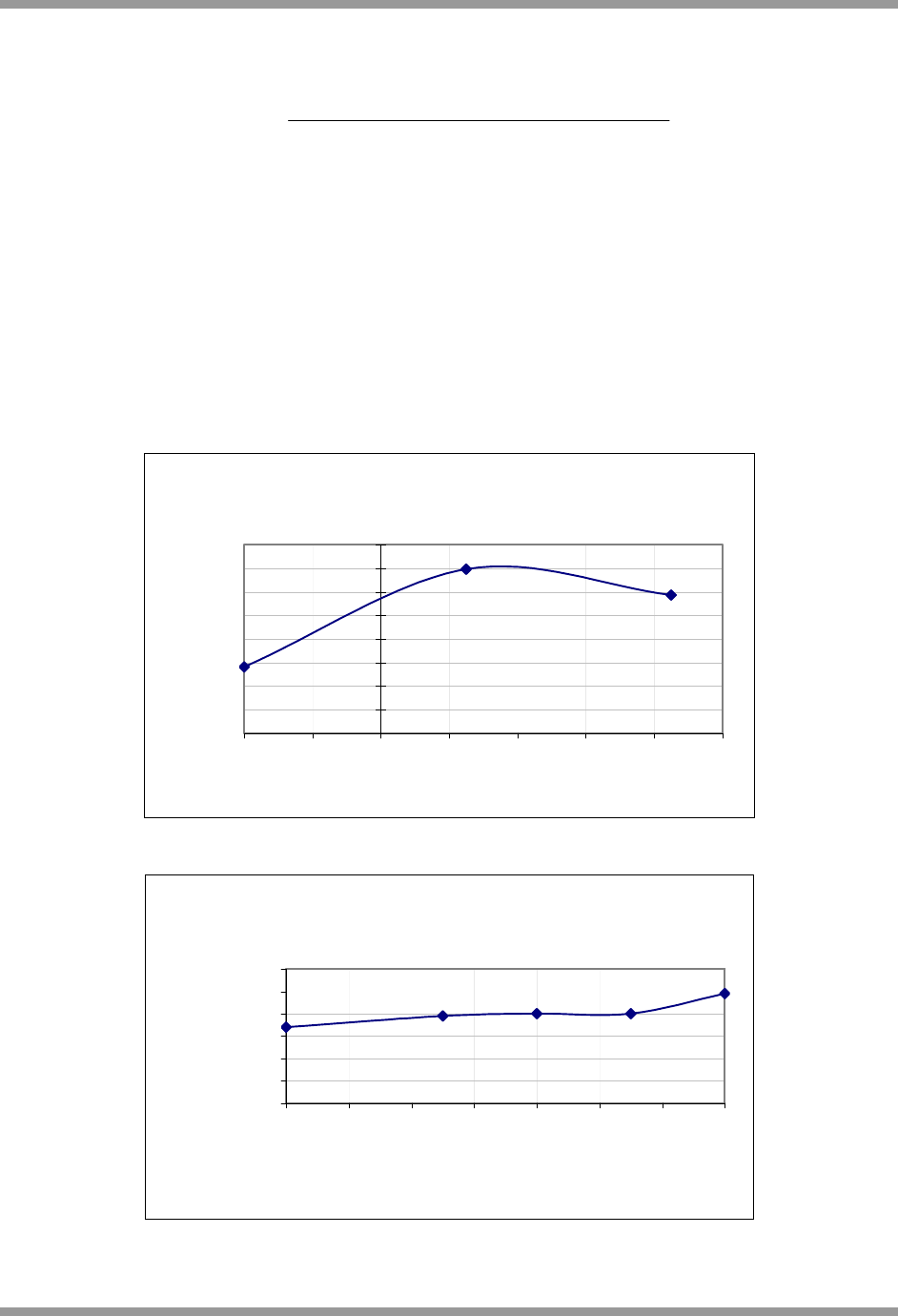
Jennic
JennicJennic
Jennic
© Jennic 2008 JN-DS-JN5139 v1.5 73
This can be used to give an equation for the required transconductance
.
21
2
2121
2
]
)
(
[
4
TT
TTTTSm
m
C
C
C
C
C
C
C
R
g×
×
+
+
×
≥
ω
Example: Using typical parameters of
m
R
=40
Ω
,
S
C
=1pF and
1T
C
=
2T
C
=18pF ( for a load capacitance of 9pF), the
equation above gives the required transconductance (
m
g
) as 647uA/V. The JN5139 has a typical value for
transconductance of 1.25mA/V
The example and equation illustrate the trade-off that exists between the load capacitance and crystal ESR. For
example, a crystal with a higher load capacitance can be used, but the value of max. ESR that can be tolerated is
reduced. Also note, that the circuit sensitivity to external capacitance [ C
1
, C
2
] is a square law.
Below is measurement data showing the variation of the crystal oscillator amplifier transconductance with
temperature and supply voltage, notice how small the variation is. Circuit techniques have been used to apply
compensation, such that the user need only design for nominal conditions.
Crystal Oscillator Transconductance Versus Temperature
(VDD=3V)
1.245
1.25
1.255
1.26
1.265
1.27
1.275
1.28
1.285
-40 -20 0 20 40 60 80 100
Temperature (C)
Transconductance (mA/V)
Crystal Oscillator Transconductance Versus Supply Voltage
(Temp=25C)
1.2
1.22
1.24
1.26
1.28
1.3
1.32
2.2 2.4 2.6 2.8 3.0 3.2 3.4 3.6
Supply Voltage (VDD)
Transconductance (mA/V)
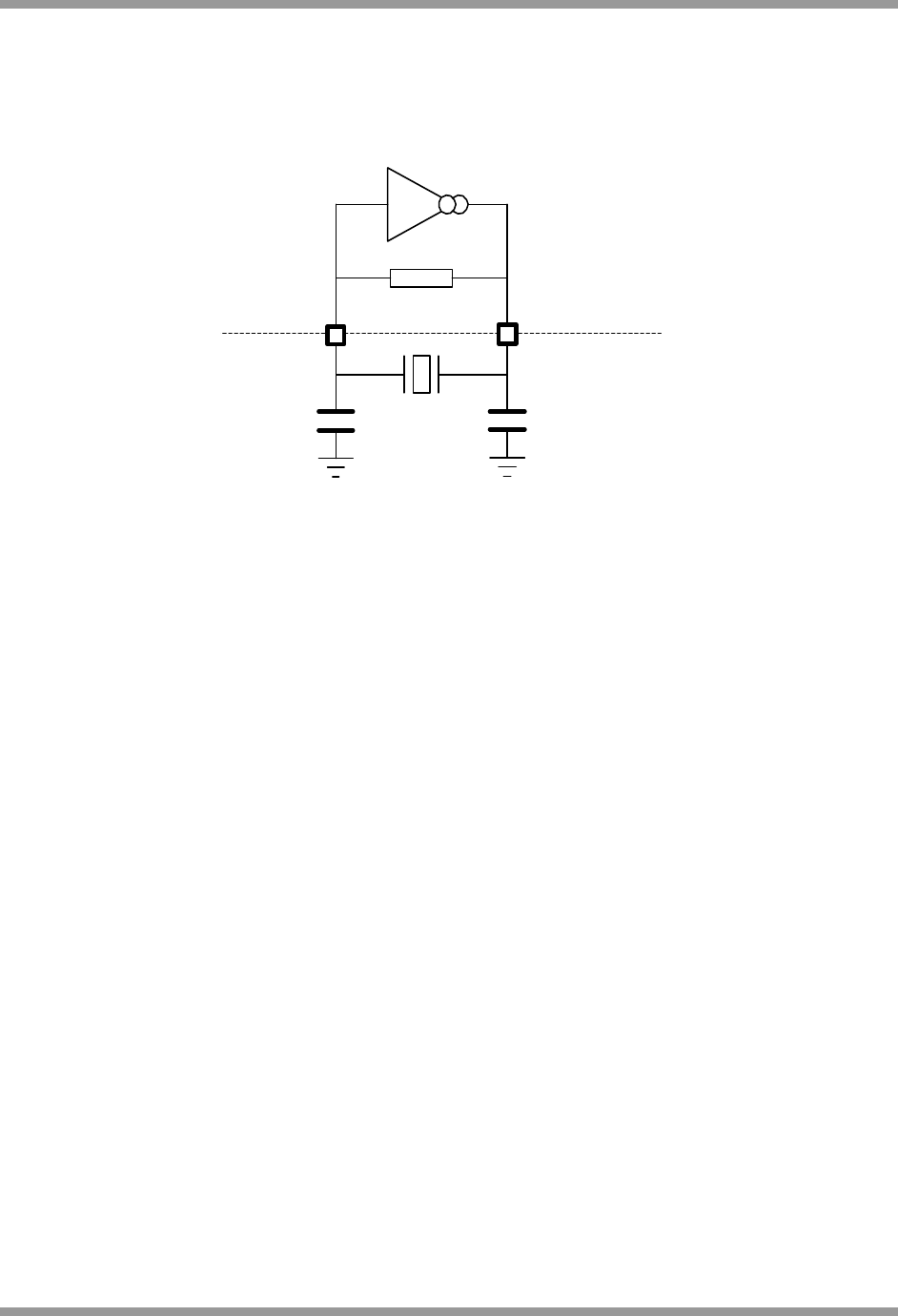
Jennic
JennicJennic
Jennic
74 JN-DS-JN5139 v1.5 © Jennic 2008
B.2 16MHz Oscillator
The JN5139 contains the necessary on-chip components to build a 16 MHz reference oscillator with the addition of
an external crystal resonator and two tuning capacitors. The schematic of these components are shown in Figure 49.
The two capacitors, C1 and C2, should be 15pF ±5% and use a COG dielectric. For a detailed specification of the
crystal required see Appendix B.1.
XTALOUT
C2
C1
R1
XTALIN
JN5139
Figure 49: Crystal oscillator connections
The clock generated by this oscillator provides the reference for most of the JN5139 subsystems, including the
transceiver, processor, memory and digital and analogue peripherals.
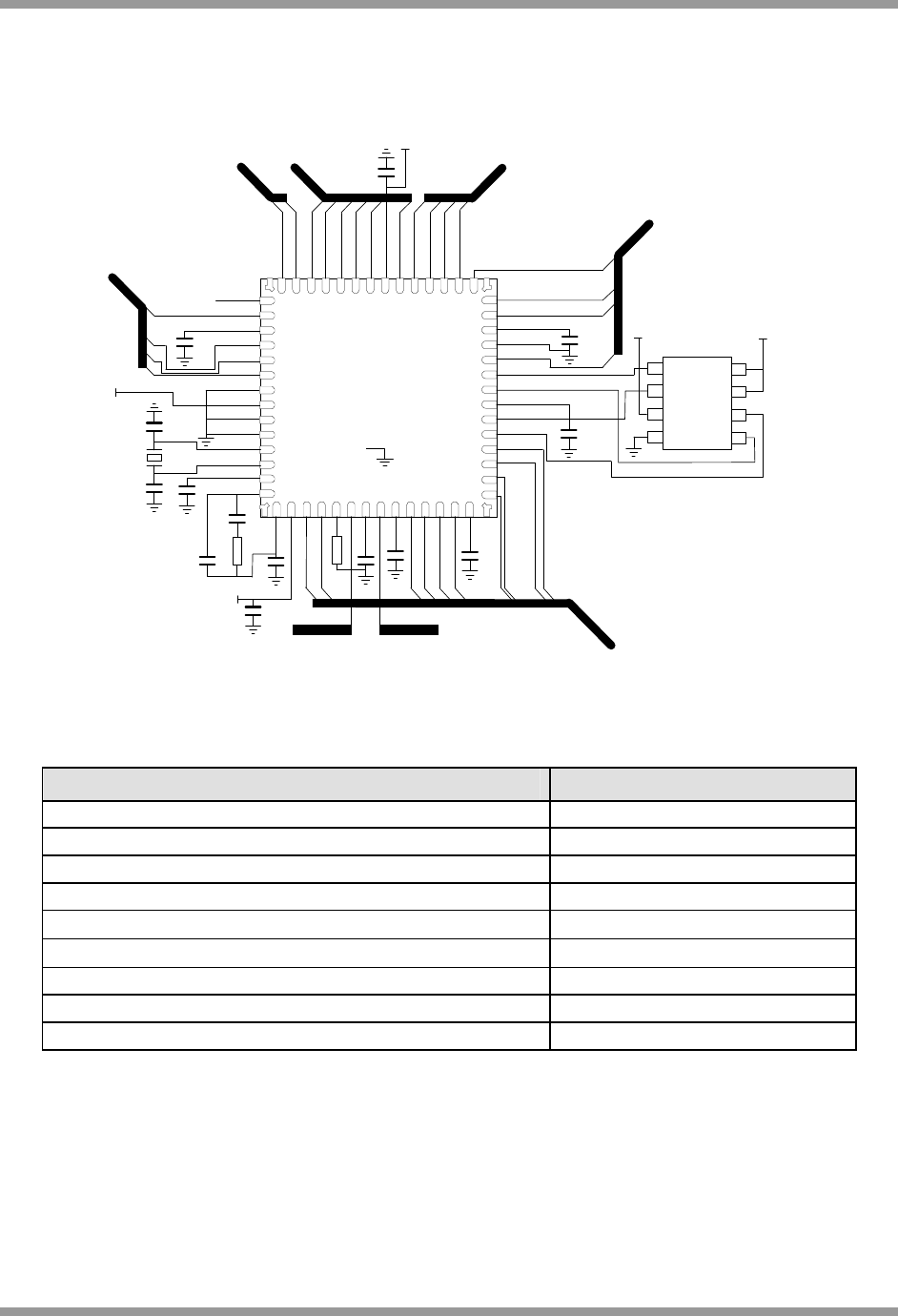
Jennic
JennicJennic
Jennic
© Jennic 2008 JN-DS-JN5139 v1.5 75
B.3 Applications Information
B.3.1 Typical Application Schematic
43
CTS1
VB_DIG2
1
RTS1
TXD1
RXD1
VSS2
RESETN
VSSS
XTALOUT
I/O Line
XTALIN
VB_SYN
VB_DIG1
ADC2
RFP
VB_RF
RFM
VREF
ADC1
ADC4
VB_A
DAC1
29
15
ADC3
VSS3
IBIAS
MOSI
SPISEL0
SPISEL1
VSS1
VB_MEM
SPISEL2
SPISEL3
VCOTUNE
MISO
VB_VCO
VDD1
COMP1M
COMP1P
DAC2
COMP2P
COMP2M
SPICLK
TIM0CK_GT
VDD2
TIM1CK_GT
TIM1CAP
TIM1OUT
SIF_CLK
SIF_D
SPISEL4
CTS0
RTS0
TXD0
RXD0
TIM0OUT
TIM0CAP
Jennic
IC1: JN5139
Vcc
UART 0
Timers
8
7
6
5
1
2
3
4
Vcc
Vcc
UART 1
RESET
Two Wire
Serial Port
SPI Selects
Analogue IO
SS
SDO
WP
Vss
Vcc
HOLD
CLK
SDI
Printed Antenna
C2
C9
C8
R4
R9 C3 C1
C4
C5
C6
C15
C11
C10
C7
Y1
C12
C13
IC2
Serial
Flash
Memory
Vcc
PADDLE
NOTES:
1) VB_SYN and VB_REF should have an
additional 47pF capacitor to ground.
2) A 10uF tantalum capacitor is reuiired
between VCC and ground.
Figure 50: Application Schematic
Table 6: Bill of Materials
Components Values
C1, C2, C3, C4, C5, C6, C7, C12, C13, C15 100nF
C10, C11 15pF (COG)
C9 3n3F
C8 330pF (COG)
R4 4k7
Ω
R9 43k
Ω
Y1 TSX-10A 16MHz Crystal TN4-25820
IC1 JN5139
IC2 128kB Serial Flash
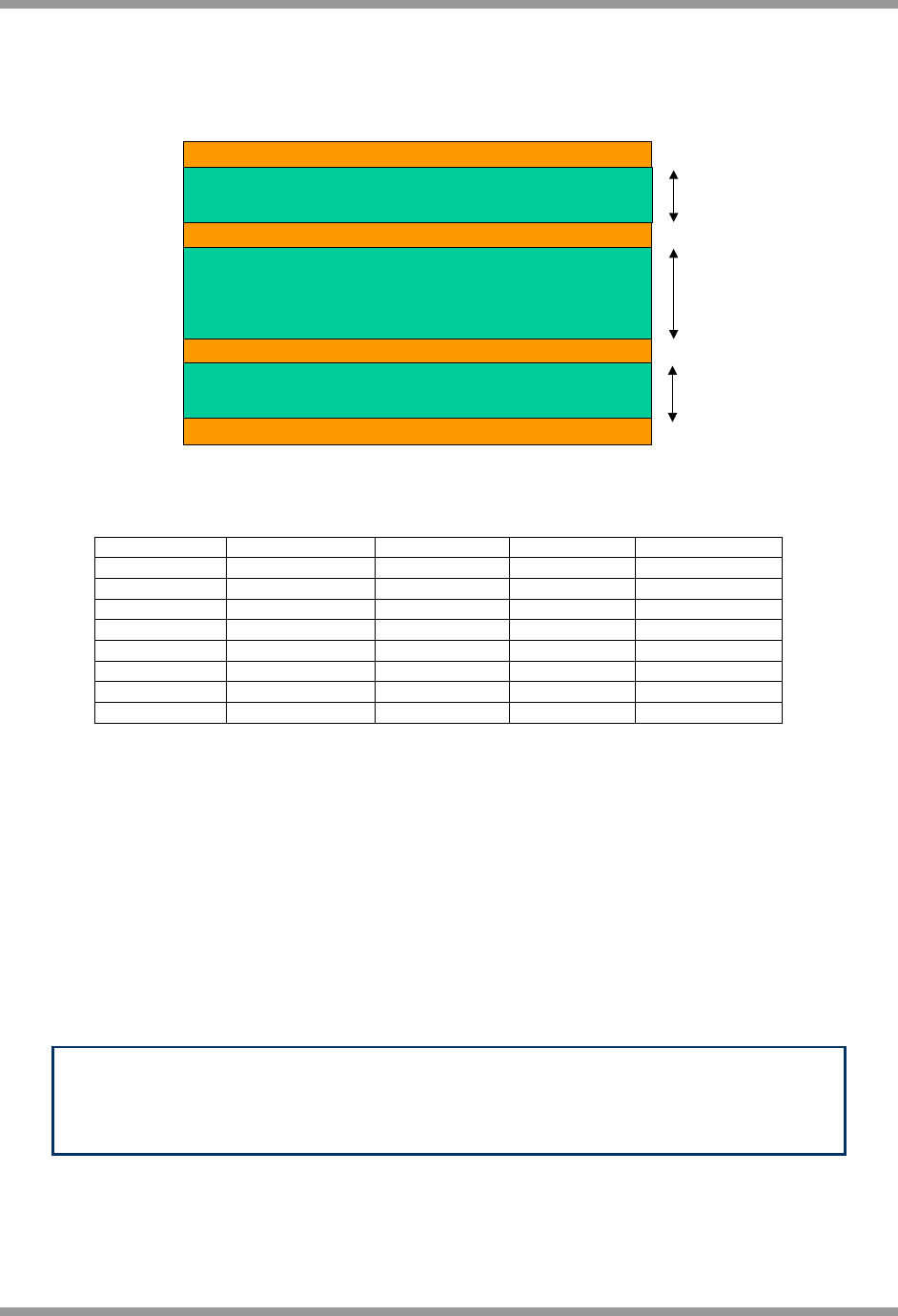
Jennic
JennicJennic
Jennic
76 JN-DS-JN5139 v1.5 © Jennic 2008
B.3.2 PCB Requirements
Jennic recommend that a standard 4–layer printed circuit board be used for design, with the individual layers
organised as shown below in .
Copper (0.5 oz – 17 µm)
Copper (0.5 oz – 17 µm)
Copper (0.5 oz – 17 µm)
Copper (0.5 oz – 17 µm)
A
B
A
Dielectric FR4 pre-preg 0.009” x 1
Dielectric FR4 0.02” x 1
Dielectric FR4 pre-preg 0.009” x 1
Dimension (mm) Description Dimension Tolerance (mm)
Top Metal 0.017 0.5oz copper
Dielectric 1 0.2286 Er = 4.2 to 4.4 Dimension A 0.01
Mid 1 metal 0.017 0.5oz copper
Dielectric 2 0.508 Er = 4.2 to 4.4 Dimension B 0.01
Mid 2 metal 0.017 0.5oz copper
Dielectric 3 0.2286 Er = 4.2 to 4.4 Dimension A 0.01
Bottom metal 0.017 0.5oz copper
Total 1.0322
Figure 51: PCB Cross-Section
From top to bottom, the layers are:
•
Component
•
Ground
•
Digital tracks
•
Power and tracks
The material is standard FR4. While no special measures are required for the board design, it is recommended that
Class 1 tolerances be used.
Note
: The Jennic PCB layout assumes the layers defined above. If a different PCB thickness
is used then the RF track thickness and layout will need to be re-assessed.

Jennic
JennicJennic
Jennic
© Jennic 2008 JN-DS-JN5139 v1.5 77
B.3.3 Supply Decoupling
C12 is the decoupling capacitor for the analogue areas of IC1. It is placed as close as possible to the IC1 pin VDD1.
C13 is the decoupling capacitor for the digital areas of IC1. It is also used to decouple the supply on the Flash
memory due to:
•
placement of the Flash memory power pin (IC2 Pin 8) next to the IC1 Pin VDD2
•
the fact that the Flash memory is only used during booting (unless reprogramming), so the RF areas of the
device are not active.
B.3.4 Reference Oscillator Requirements
The device contains the necessary on-chip components to build a 16-MHz reference oscillator with the addition of an
external crystal resonator. The schematic in
Figure 50: Application Schematic
shows the crystal circuit in the form
of capacitors C10 and C11, together with a crystal resonator Y1.
The reference crystal serves many purposes, including the provision of a reference for the 32-bit RISC processor,
radio and analogue peripherals. In addition, the crystal also provides timing references for external I/O (e.g. on-chip
UARTs) and timer counters. Thus, it is important that the crystal reference is specified and built correctly to ensure
that the system functions properly.
The external crystal resonator, Y1, is connected to IC1 via two coupling capacitors, C10 and C11, that should be
15pF ±5% and use a C0G dielectric – the 15pF will need to vary for alternate crystals. This is important, in order to
ensure that the oscillator Q-factor is maximised and the temperature co-efficient is minimised.
The choice of crystal resonator is important for the following reasons:
• Resonator tolerance:
A number of parameters, ranging from on-chip timings to radio centre-frequency, are
derived directly from the tolerance of the crystal. As indicated in the component list, we recommend that a total
tolerance of less than ±35ppm is used, as the maximum permissible offset specified in IEEE 802.15.4 is ±40
ppm. Also note that this tolerance should include both temperature and ageing effects imparted on the
resonator.
• Resonator load capacitance:
The active oscillator components on the JN5121 and JN5139 series devices
are designed for a crystal resonator with load capacitance of 9 pF. This is a standard loading, and resonators
of this type are widely available.
B.3.5 Reference Oscillator Layout Considerations
The layout of the oscillator circuit is such that the components are close together. This improves the performance of
the oscillator by reducing parasitic impedance and the likelihood of cross-talk.
We also recommend that the symmetry of layout be maximised in order to avoid uneven loading of the crystal
resonator.
B.3.6 VCO Tune Circuit Component Specifications
Jennic wireless microcontroller devices employ an RF Phase Locked Loop (PLL). With respect to the schematic in
Figure 50: Application Schematic
, the only external components required on the printed circuit board are two
capacitors, C8 and C9, together with the resistor R4.
!
Caution: It is essential that the component values advised here
are followed, since their substitution could lead to failure in the
PLL.

Jennic
JennicJennic
Jennic
78 JN-DS-JN5139 v1.5 © Jennic 2008
B.3.7 VCO Tune Circuit Layout Considerations
The layout of these components is such that all three components are close together, and close to the VCO_TUNE
and VB_VCO pins on the wireless microcontroller IC. This improves the performance of the PLL by reducing parasitic
impedance and the likelihood of cross-talk.
B.3.8 Radio Front-End
The radio part of the wireless microcontroller device has an internal transmit-receive switch connected to the external
pins on the chip (RF- and RF+). The PHY controller of the radio configures the switch between transmit and receive.
In both configurations, the connection to the device is a differential 200-ohm configuration. As an example of how
this may be used, the 200-ohm differential antenna connection (RF- and RF+) can be fed to a miniature balun to
convert to a single-ended 50-ohm microstrip line which, in turn, can be connected to a small ceramic antenna.
Note: The PCB layout is very important for all of the external radio
connections and associated power supplies. In this respect, the tolerances
indicated in Figure 51: PCB Cross-Section are particularly important
B.3.9 Antennae
There are many different antenna configurations that could function for a 2.4-GHz transceiver. The free-space
wavelength at 2.4 GHz is approximately 12 cm, which means that a standard half-wave dipole would be
approximately 6 cm.
When advising on antenna design, it is dangerous to generalise. However, designers of any low-power radio device
must strive to ensure that as little power as possible is wasted in producing a radio signal transmission. This involves
careful consideration of the terms antenna efficiency, antenna directivity and antenna gain:
• Antenna Efficiency
: This is a measure of how much energy fed into the antenna feed is actually retained in the
radio transmission. For example, a small antenna may exhibit an efficiency of approximately 50%, which
means that half the power fed into or out of the antenna is wasted. Clearly, it is important to keep efficiency as
high as possible. However, small antennae exhibit lower efficiency than large antennae.
• Antenna Directivity
: An antenna radiation pattern indicates in which direction the power fed into an antenna
actually radiates. In situations where antennae can be aligned to “see” each other, this can be advantageous.
However, many situations do not allow this, since a path from one device to another may occur in any direction.
In general, larger antennae have a greater ability to radiate in a specific direction. In antenna terminology, this
is called the “directivity”. For instance, an antenna with a directivity of 3 dBi has the ability to radiate twice as
much power in one direction when compared with a theoretical omni-directional antenna. This is fine if both
antennae are aligned in this direction, but it is not good if they are misaligned.
• Antenna Gain
: Often, the term “gain” is used when discussing antennae. This term should be treated with
some caution since it is the product of efficiency and directivity. A poor-efficiency antenna with a high directivity
can still exhibit a reasonable gain; however, power is still being wasted somewhere!
A list of antennae and suppliers can be found in the Application Note
Antennae for use with JN51xx (JN-AN-1030)
,
available on the Jennic web site.
B.3.10 Ground Planes
The recommendation for a four-layer design allows the best use of the ground planes, with this in mind the following
restrictions should be placed on the layout:
•
All RF signals are confined to the top layer.
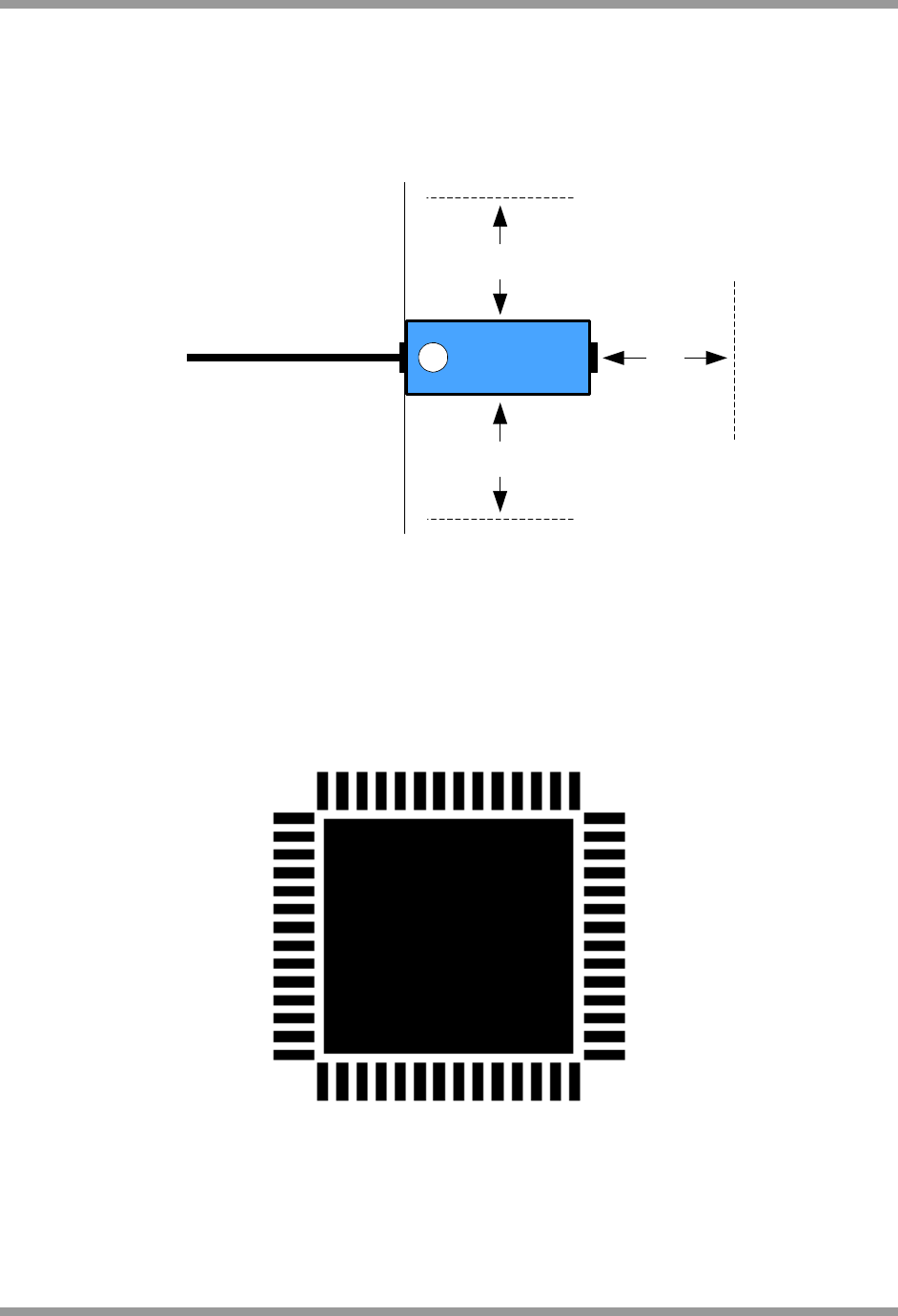
Jennic
JennicJennic
Jennic
© Jennic 2008 JN-DS-JN5139 v1.5 79
•
The second layer is Ground and has no tracks on it. This allows the best return path for all RF signals and will
reduce noise effects.
•
The bottom layer contains all other signals and the V
cc
power supply for the module.
•
The ground planes on all layers stop BEFORE the antenna, so that the performance of the antenna is not
affected. The recommended antenna clearance for a surface-mounted ceramic antenna is shown below.
ANTENNA
CHIP
CLEARANCE
(no ground plane)
CLEARANCE
(no ground plane)
50 Ω transmission line
Dimensions in mm
20
20
20
Figure 52: Antenna Clearance Recommendations
B.3.11 Manufacturing Considerations
The TQFN package must be considered carefully when using reflow solder techniques. The following are
recommendations:
•
The decal is shown in Figure 53. The pad stacks used are 0.25 mm by 1 mm for the smaller pads, and a 6.4-
mm square pad for the paddle.
Figure 53: Recommended PCB Decal for 56QFN Package
•
The solder mask used is shown in Figure 54. The pad stacks used are 0.25 mm by 1 mm for the smaller pads,
and two 2-mm square pads to apply paste to the paddle. The solder paste mask has a thickness of 6 thou
(0.152 mm).
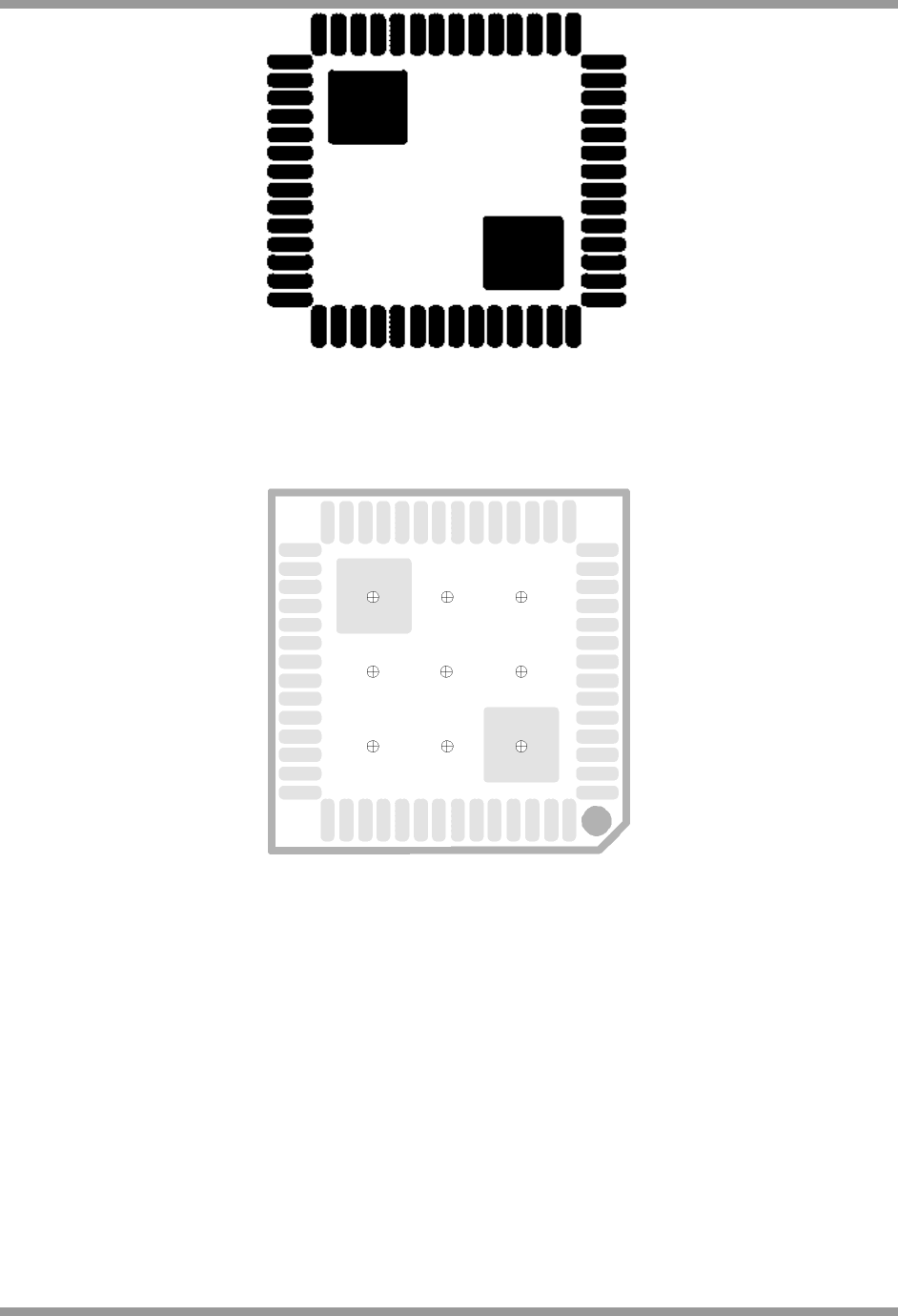
Jennic
JennicJennic
Jennic
80 JN-DS-JN5139 v1.5 © Jennic 2008
Figure 54: Recommended Solder Paste Mask for 56QFN Package
•
Nine vias are applied to the paddle. These allow excess solder paste and heated air to be vented away from the
device, preventing the device from being lifted during soldering.
Figure 55: Vias on the Paddle of the 56QFN Package
B.3.12 Bespoke Solutions - PCB Layout Suggestions
The list presented below provides some key suggestions when using a wireless microcontroller on a bespoke, multi-
layer PCB. Clearly, the list is not exhaustive and you may have more detailed considerations in using mixed-signal
integrated circuits.
• Shared vias
: Often in layout, it is convenient for a number of components to share a return to Analog Ground.
Examples include bypass capacitors and reference setting resistors. We recommend that all components are
given a separate via to ground. This avoids noise feed-through and poor isolation issues that often occur if a
via is shared.
• Oscillator circuit
: We recommend that tracks from the oscillator pins are kept to the same length and, ideally,
on the top layer. This avoids asymmetrical loading of the crystal resonator. The placement of the two capacitors
should be symmetrical to the crystal. This also avoids asymmetrical loading of the reference oscillator.
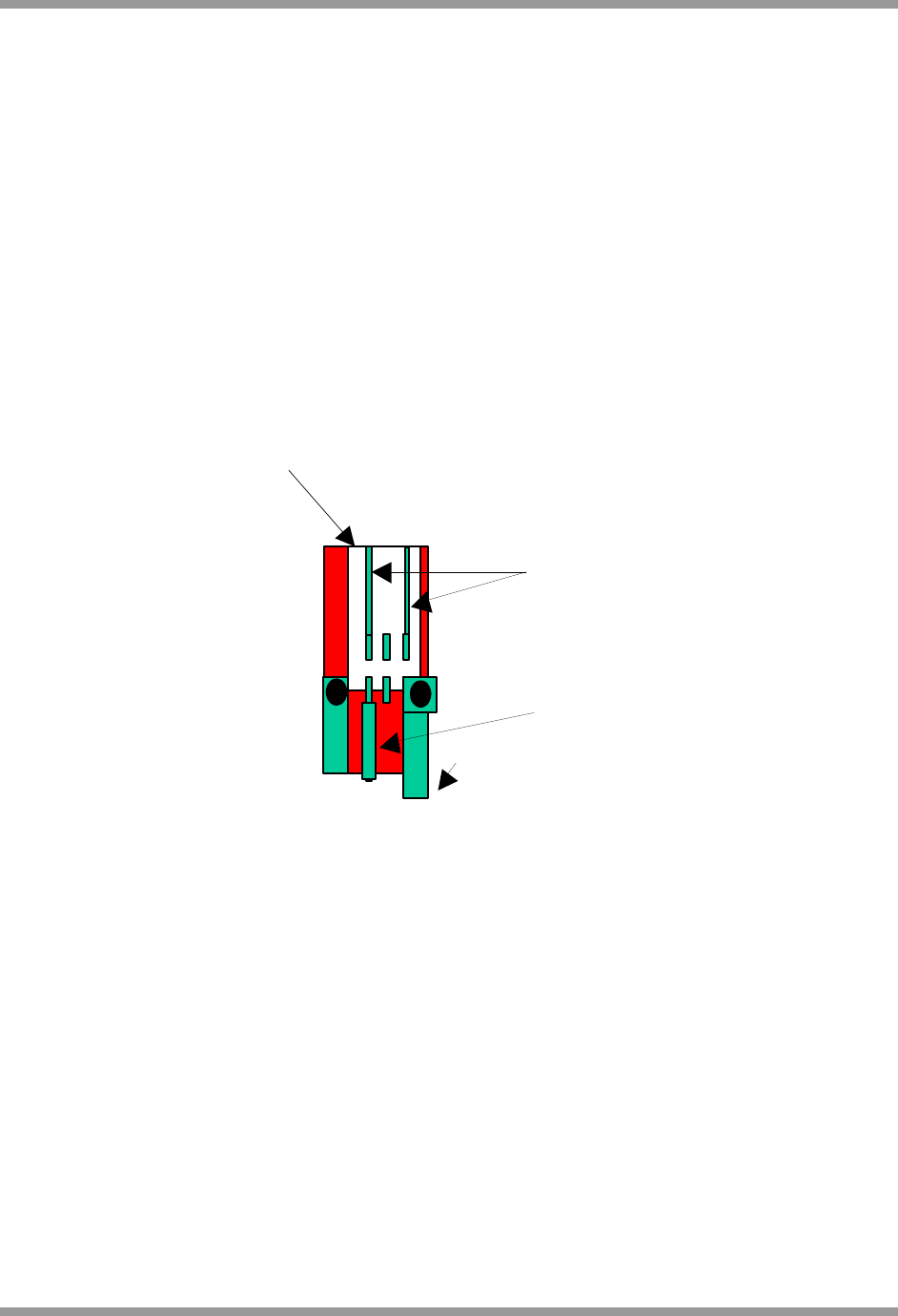
Jennic
JennicJennic
Jennic
© Jennic 2008 JN-DS-JN5139 v1.5 81
• VCOTune circuit
: The components defined in the schematic should be used in order to set the PLL bandwidth
correctly. It is also essential to keep these components close to the chip, with minimum track lengths.
B.3.13 Using a Balun
When using a single ended antenna, the wireless microcontroller will use a balun and should be connected as
indicated in Figure 56.
The tracks between IC1 pins RF+ and RF-, and the balanced side of the balun, are on the top layer. These are
impedance-controlled tracks, designed to provide the 200-ohm differential matched impedance required by the device
at its RF port. With the exception of the via connected to the VB_RF pin, other nearby tracks should be placed such
that there is at least three times the track width of unbroken ground on either side and underneath the tracks.
The other side of the balun should be connected to the antenna. This track is an unbalanced microstrip RF track
operating at 2.4 GHz. It should be impedance controlled to 50 ohms for a good RF input match.
Top View
BALUN
To wireless microcontroller
Track widths to
give 200 ohm
differential line
Track width
to give 50
ohm line
GND
GND
GND plane to be
cut underneath
differential tracks
Figure 56: Connecting the Balun
B.3.14 Decoupling Capacitors
Three capacitors should be used:
•
Two ceramic 100-nF capacitors - one should be placed close to pin VDD1, the other should be placed close to
pin VDD2
•
One 10-µF electrolytic capacitor connected to ground - if the PCB is a module then place this capacitor close to
the point where the power enters the module.

Jennic
JennicJennic
Jennic
82 JN-DS-JN5139 v1.5 © Jennic 2008
B.3.15 Internal Regulator Smoothing Capacitors
A ceramic 100-nF capacitor should be connected to each of the following pins. Place these capacitors close to the
device and make the tracks as thick as possible to improve RF bypass/decoupling. Some pins require an additional
47-pF capacitor. Details are given below.
Pin Name 47-pF Capacitor Required
VB_DIG1
VB_SYN
VB_VCO
VB_RF
VB_A
VB_DIG2
VB_MEM
B.3.16 VREF
A ceramic 100-nF capacitor should be placed as close as possible to the VREF pin.
B.3.17 IBIAS
A 43-kΩ resistor should be connected as close as possible to the IBIAS pin.
B.3.18 EMC
For good EMC performance, it is necessary to minimise any ground loops when laying out the PCB.

Jennic
JennicJennic
Jennic
© Jennic 2008 JN-DS-JN5139 v1.5 83
Appendix C
Related Documents
[1]
IEEE Std 802.15.4-2003 IEEE Standard for Information technology – Part 15.4 Wireless Medium Access Control
(MAC) and Physical Layer (PHY) Specifications for Low-Rate Wireless Personal Area Networks (LR-WPANs)
[2]
JN-AN-1003 Boot Loader Operation
[3]
JN-AN-1062 Using OTP eFuse Memory
[4]
JN-AN-1038 Programming Flash devices not supported by the JN51xx ROM-based bootloader
RoHS Compliance
JN5139 devices meet the requirements of Directive 2002/95/EC of the European Parliament and of the
Council on the Restriction of Hazardous Substance (RoHS).
Status Information
The status of this Data Sheet is
Production
.
Jennic products progress according to the following format:
Advanced
The Data Sheet shows the specification of a product in planning or in development.
The functionality and electrical performance specifications are target values and may be used as a guide to the final
specification. Integrated circuits are identified with an R suffix, for example JN5139-Z01R.
Jennic reserves the right to make changes to the product specification at anytime without notice.
Preliminary
The Data Sheet shows the specification of a product that is in production, but is not yet fully qualified.
The functionality of the product is final. The electrical performance specifications are target values and may used as a
guide to the final specification. Integrated circuits are identified with an R suffix, for example JN5139-Z01R.
Jennic reserves the right to make changes to the product specification at anytime without notice.
Production
This is the final Data Sheet for the product; all product characterization is completed.
All functional and electrical performance specifications where included, including min and max values are final.
This Data Sheet supersedes all previous document versions.
Jennic reserves the right to make changes to the product specification at anytime to improve its performance.
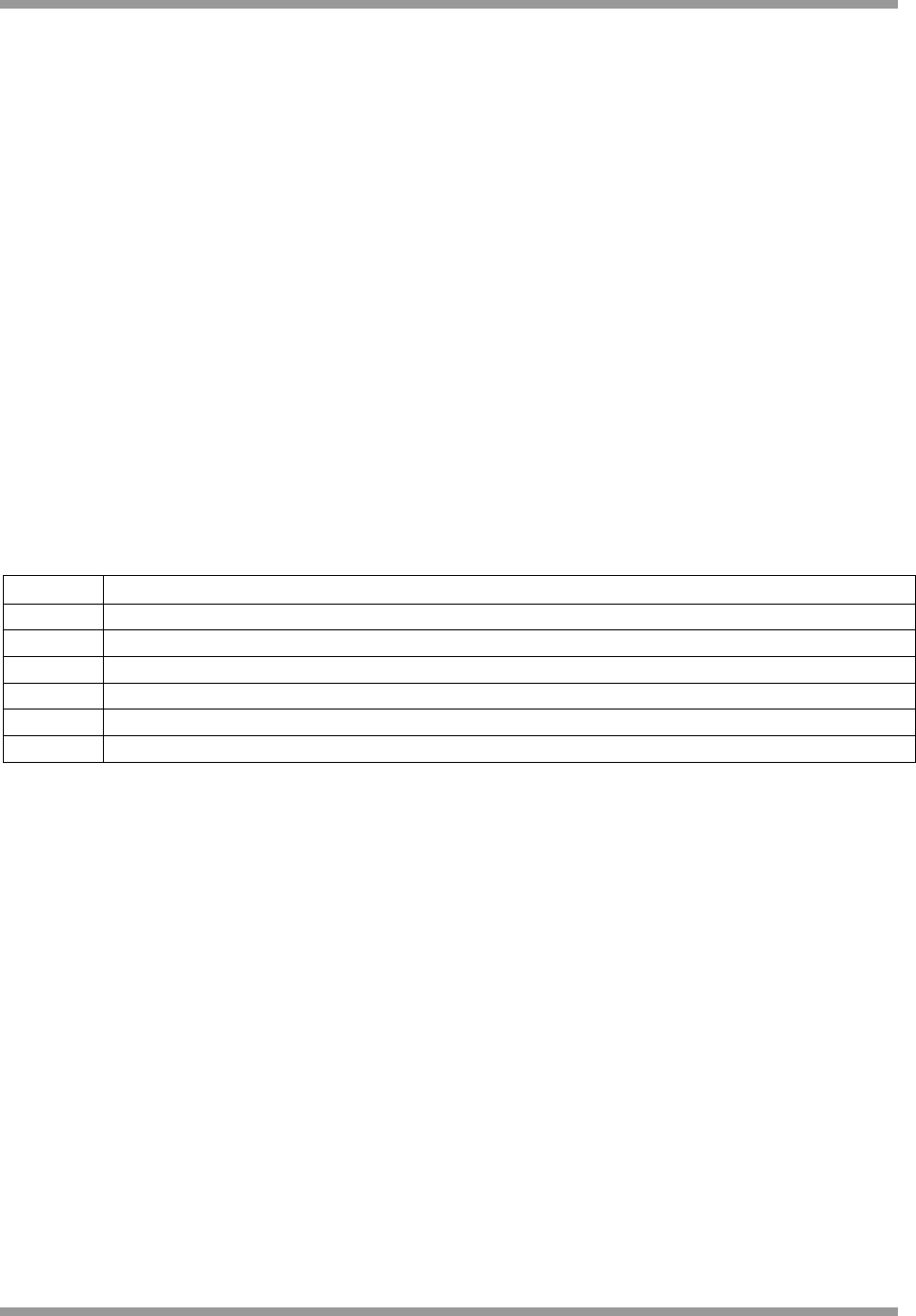
Jennic
JennicJennic
Jennic
84 JN-DS-JN5139 v1.5 © Jennic 2008
Disclaimers
The contents of this document are subject to change without notice. Jennic reserves the right to make changes,
without notice, in the products, including circuits and/or software, described or contained herein in order to improve
design and/or performance. Information contained in this document regarding device applications and the like is
intended through suggestion only and may be superseded by updates. It is your responsibility to ensure that your
application meets with your specifications.
Jennic warrants performance of its hardware products to the specifications applicable at the time of sale in
accordance with Jennic’s standard warranty. Testing and other quality control techniques are used to the extent
Jennic deems necessary to support this warranty. Except where mandatory by government requirements, testing of
all parameters of each product is not necessarily performed.
Jennic assumes no responsibility or liability for the use of any of these products, conveys no license or title under any
patent, copyright, or mask work right to these products, and makes no representations or warranties that these
products are free from patent, copyright, or mask work infringement, unless otherwise specified.
Jennic products are not intended for use in life support systems, appliances or systems where malfunction of these
products can reasonably be expected to result in personal injury, death or severe property or environmental damage.
Jennic customers using or selling these products for use in such applications do so at their own risk and agree to fully
indemnify Jennic for any damages resulting from such use.
All trademarks are the property of their respective owners.
Version Control
Version Notes
1.0 22
rd
December 2006 - First Release
1.1 9th February 2007 – Added solder reflow profile
1.2 16th July 2007 – uplifted to Preliminary status, typical specification updates, internal reset modifications
1.3 31st July 2007 – updates to DC current consumptions
1.4 26th October 2007 – updated applications information, added PCB decal including paddle details
1.5 23rd April 2008 – Product has now been fully characterised

Jennic
JennicJennic
Jennic
© Jennic 2008 JN-DS-JN5139 v1.5 85
Contact Details
Corporate Headquarters
Jennic Ltd, Furnival Street
Sheffield S1 4QT, UK
Tel: +44 (0)114 281 2655
Fax: +44 (0) 114 281 2951
info@jennic.com
www.jennic.com
Jennic Ltd Japan
Osakaya building 4F
1-11-8 Higashigotanda Shinagawa-ku
Tokyo 141-0022, Japan
Tel: +81 3 5449 7501
Fax: +81 3 5449 0741
info@jp.jennic.com
www.jennic.com
Jennic Ltd Taiwan
19F-1, 182, Sec.2 Tun Hwa S. Road.
Taipei 106, Taiwan
Tel: +886 2 2735 7357
Fax: +886 2 2739 5687
info@tw.jennic.com
www.jennic.com
Jennic America Inc
1060 First Avenue, Suite 400
King of Prussia, PA 19406, USA
Tel: +1 484 868 0222
Fax: +1 484 971 5015
info@us.jennic.com
www.jennic.com
Jennic Ltd Korea
601, Bethel B/D, #324-1,
Yangjae-dong Seocho-ku,
Seoul, Korea
Tel: +82 2 552 5325
Fax: +82 2 577 9130
info@kr.jennic.com
www.jennic.com